
Journals By Subject
- Proceedings
Information


Pompeii as a Dark Tourism Site: The Frozen City
Shaimaa Mohamed Naguib Mostafa
Faculty of Tourism and Hotels Management, Helwan University, Cairo, Egypt
Souzan Ibrahim Hassanein Ibrahim
Add to Mendeley
Dark heritage concept becomes more popular during the last years than before especially in the field of heritage studies. This widespread encouraged what is known as dark tourism. As it is going to be discussed in this paper, the dark heritage or tourism concept include any destruction, catastrophe, and death cases. Travelling for the purpose of seeing dead or death sites become very popular and carry a special type of interest. As seen in our presented case study, Pompeii is an attractive destroyed city which catches the attention of thousands of visitors who eager to travel to see the life in this site as it was. The site of Pompeii is a unique site in its components and catastrophic and sudden destroy by the eruption of Mount Vesuvius in 79 A. D. This in turn makes this site very remarkable and important dark heritage tourism site along with its importance to the scholars due to its richness that reflected the lifestyle of the ancient Romans. Among the aims of this study is to discuss the concept of dark heritage and tourism and its importance to the recent tourism programs and heritage studies shedding the light on the site of Pompeii as very successful and important model for dark tourism in Italy.
Dark Heritage, Tourism, Pompeii, Interpretation
Shaimaa Mohamed Naguib Mostafa, Souzan Ibrahim Hassanein Ibrahim. (2022). Pompeii as a Dark Tourism Site: The Frozen City. History Research , 10 (1), 59-69. https://doi.org/10.11648/j.history.20221001.17
Shaimaa Mohamed Naguib Mostafa; Souzan Ibrahim Hassanein Ibrahim. Pompeii as a Dark Tourism Site: The Frozen City. Hist. Res. 2022 , 10 (1), 59-69. doi: 10.11648/j.history.20221001.17
Shaimaa Mohamed Naguib Mostafa, Souzan Ibrahim Hassanein Ibrahim. Pompeii as a Dark Tourism Site: The Frozen City. Hist Res . 2022;10(1):59-69. doi: 10.11648/j.history.20221001.17
Cite This Article
- Author Information
Verification Code/
The captcha is required.
Captcha is not valid.
Verification Code
Science Publishing Group (SciencePG) is an Open Access publisher, with more than 300 online, peer-reviewed journals covering a wide range of academic disciplines.
Learn More About SciencePG

- Special Issues
- AcademicEvents
- ScholarProfiles
- For Authors
- For Reviewers
- For Editors
- For Conference Organizers
- For Librarians
- Article Processing Charges
- Special Issues Guidelines
- Editorial Process
- Peer Review at SciencePG
- Open Access
- Ethical Guidelines
Important Link
- Manuscript Submission
- Propose a Special Issue
- Join the Editorial Board
- Become a Reviewer
10 Haunting Dark Tourism Destinations From Around the World
Eerie but still fascinating, these dark tourism spots are definitely off the beaten path, yet could still be worth visiting (if you don’t mind the macabre).

While some people go on vacation for a little rest and relaxation, others prefer to travel to destinations that are primarily associated with the morbid and the macabre.
The practice, which is known as dark tourism , involves visiting locations with a lot of notoriety because they’re largely associated with death , devastation, and unspeakable acts against humanity.
“It’s not a new phenomenon,” J. John Lennon, a professor of tourism at Glasgow Caledonian University told The Washington Post in 2019. “There’s evidence that dark tourism goes back to the Battle of Waterloo where people watched from their carriages [as] the battle [took] place.” Lennon and his colleague Malcolm Foley are credited with coining the term dark tourism in 1996, and together they wrote the book Dark Tourism: The Attraction to Death and Disaster .
In recent years, foot traffic to Civil War battlefields and places like Auschwitz have even been on the rise, perhaps because tourists want to better understand some of history’s most tragic chapters. Below are some of the most well-known dark tourism destinations from around the world.
1. The Ruins of Pompeii // Pompeii, Italy
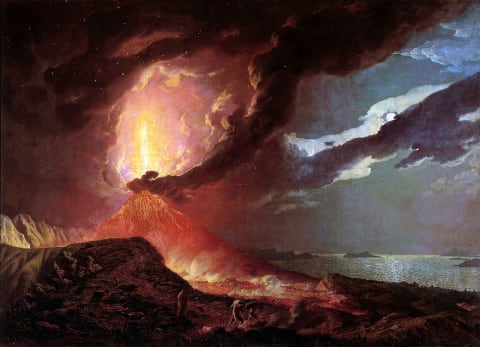
In the fall of 79 CE, Mount Vesuvius erupted with the force of 100,000 atom bombs, releasing toxic gas, ash, and other volcanic debris into the air. It subsequently wiped out the nearby cities of Herculaneum and Pompeii . Nearly 2000 years later, the ruins of Pompeii , as part of Vesuvius National Park, have become one of Italy’s most frequented tourist attractions, in large part due to the volcanic ash deposits that completely coated and preserved the ancient city.
There are a number of guided tours and excursions that take tourists to historical sites around the ruins that are still frozen in time, such as Pompeii Archaeological Park, The Forum, Teatro Grande, and more.
2. Auschwitz-Birkenau State Museum // Oświęcim, Poland

One of the most harrowing places on the planet to visit is the Auschwitz-Birkenau State Museum , which opened in 1947 in Oświęcim, Poland. Auschwitz was the largest Nazi concentration camp during World War II (an estimated 1.3 million people were sent there before 1945); it was also the site of a mass genocide where more than 1.1 million people—including over 960,000 Jewish people—were murdered or died due to illnesses like typhus , tuberculosis, and dysentery. Poor sanitary conditions also led to issues like scabies, and many prisoners suffered from boils, rashes, and abscesses that were largely caused by vitamin deficiencies.
Today, Auschwitz is a memorial and museum that’s dedicated to history, education, and remembrance of the atrocities inflicted on fellow humans.
3. National September 11 Memorial & Museum // New York City, New York

Ever since the terrorist attacks that destroyed the World Trade Center on September 11, 2001, people from around the world have flocked to New York City’s Financial District to pay their respects to the nearly 3000 lives lost at Ground Zero.
In fact, according to a 2022 survey by Passport Photo Online, Ground Zero is one of the most popular dark tourism destinations in the world. The National September 11 Memorial and Museum , which opened in 2014, features twin reflecting pools containing the largest man-made waterfalls in North America where the Twin Towers once stood. The names of every victim are engraved in bronze panels surrounding each acre-sized pools. The museum itself has artifacts on display, personal stories , special exhibitions, and more. There are also exhibits focused the World Trade Center bombing that happened on February 26, 1993.
4. The Killing Fields of Choeung Ek // Phnom Penh, Cambodia

From 1974 to 1979, the Khmer Rouge regime murdered more than 1 million political prisoners in Cambodia (about one-fourth of the country’s total population), burying the bodies in mass graves known as “killing fields.” The largest of the killing fields was Choeung Ek, located on the outskirts of Phnom Penh. The site was an orchard and Chinese cemetery before the Khmer Rouge used it for widespread massacres.
In 1980, after the regime was overthrown, the remains of nearly 9000 people were exhumed from the mass graves surrounding Choeung Ek (although some graves were left untouched ). Roughly 8000 skulls that were taken from those graves are now on display behind glass panels at the Choeung Ek memorial stupa, a Buddhist-style structure which was erected in 1988 to remember the victims who were lost.
In 2019, more than 250,000 visitors—a mix of international travelers and Cambodians— explored the site ; prior to the COVID-19 epidemic, approximately 300 to 600 guests visited daily. Attendance rates sharply declined after 2020 because it was closed, but in 2022, more than 45,000 foreign guests and over 21,000 Cambodians visited. In addition, the Choeung Ek Genocidal Center is a focal point every year during Cambodia’s National Day of Remembrance, which is observed on May 20.
5. Hiroshima Peace Memorial Museum // Hiroshima, Japan

Since it opened in August 1955, the Hiroshima Peace Memorial Museum in Hiroshima, Japan, has been dedicated to preserving stories, photos, and other artifacts that convey the unimaginable terror and loss of life that the city endured after being on the receiving end of the world’s first atomic bomb strike on August 6, 1945. (The U.S., in case you missed it in your history classes, was responsible for dropping the bomb .)
The museum reportedly gets around 1 million visitors every year and is a very popular choice for school field trips within the country. Inside you’ll find victim testimonials and exhibits depicting the horrors of war and the destructive nature of nuclear weapons. As the museum explains , “Each of the items displayed embodies the grief, anger, or pain of real people. Having now recovered from the A-bomb calamity, Hiroshima’s deepest wish is the elimination of all nuclear weapons and the realization of a genuinely peaceful international community.”
6. Murambi Genocide Memorial Centre // Murambi, Rwanda
Formerly a technical college, the Murambi Genocide Memorial Centre in southern Rwanda is one of the grimmest places for dark tourism. While the destination itself is picturesque (complete with rolling countryside hills and other scenic views), it was also the site of a brutal 1994 massacre which claimed approximately 50,000 lives during the Rwandan Civil War.
Approximately 65,000 refugees from the Tutsi minority community had fled to the technical college after being told by authorities that they would be safe there . Instead, they were confined without food or water, and subsequently massacred by a government-backed Hutu militia. Only 34 people are believed to have survived the carnage that ensued.
Throughout the 100-day period now known as the Rwandan genocide , Hutu militias collectively murdered upwards of 800,000 civilians, many of whom were Tutsis. The Murambi Genocide Memorial Centre, which opened in April 1995, is now one of six National Genocide Memorial Sites within the country. More than 800 mummified corpses and preserved skeletons are on display in Murambi, to serve as a reminder of the horrific darkness and gruesomeness of the genocide, and to honor those who were victimized.
7. The Catacombs of Paris // Paris, France
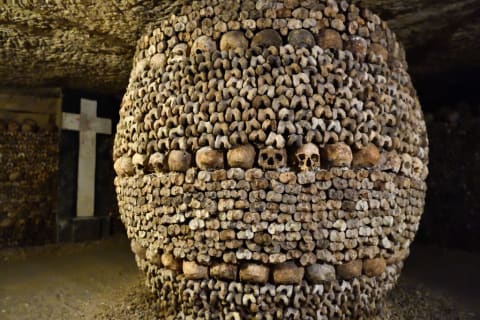
During the 18th century, Paris had a big public health problem on its hands: Local cemeteries were overcrowded and improper disposal of corpses was fueling the spread of disease. In response, the city decided to convert its subterranean Lutetian limestone quarries into sprawling underground ossuaries.
Located about 65 feet below the City of Light’s streets, the Les Catacombes de Paris (a.k.a. the Catacombs of Paris ) house the remains of more than 6 million late Parisians. Today, visitors can take guided tours and learn about its unique history, all while viewing the millions of human skulls and bones that line the walls of the cavernous space.
8. Alcatraz Federal Penitentiary // Alcatraz Island in San Francisco Bay, California
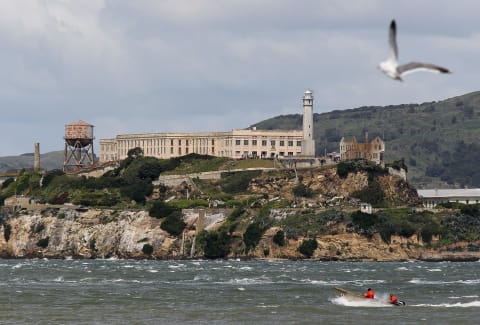
It might come as a surprise, but one of San Francisco ’s most popular tourist attractions is technically located in San Francisco Bay, on Alcatraz Island. Better known to some as “The Rock,” Alcatraz Federal Penitentiary was a former maximum-security federal prison that closed down in 1963. But before it did, it hosted some pretty infamous inmates , including Al Capone , George “Machine Gun” Kelly, James “Whitey” Bulger, and others.
Over the decades, Alcatraz has been immortalized in pop culture through music and movies. It’s also considered a U.S. National Park now and has over 1.5 million visitors annually. Tourists can take guided walks around the main cell-house, dining hall, lighthouse, and other locations around the grounds.
9. Cape Coast Castle // Cape Coast, Ghana
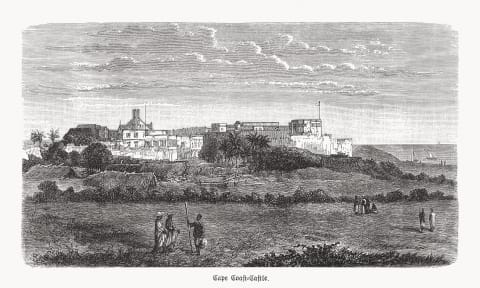
Originally built for the Swedish Africa Company in 1653 for the purposes of trading gold and timber, Ghana’s Cape Coast Castle later became an integral part of the Atlantic slave trade. Famously, one of the doors at the slave-trade outpost was known as the “ Door of no Return .” Many believe that captive Africans were led through it to ships that were about to embark on the Middle Passage , and were never seen or heard from again. (However, some have recently speculated that the door may not have been linked to the slave trade at all, and may have actually been used as a way to dispose of waste by tossing it into the sea.)
During the ‘70s, Cape Coast Castle was converted into a museum and monument, and the United Nations Educational, Scientific, and Cultural Organization (UNESCO) later named it a World Heritage Site for preservation and protection, as a “cultural and natural heritage around the world considered to be of outstanding value to humanity.” Over the years, it has become a major tourist attraction for some Black Americans (including former President Barack Obama ) looking to reconnect with their roots.
10. Chernobyl // Pripyat, Ukraine
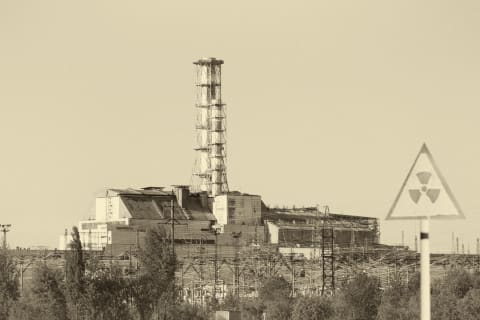
On April 26, 1986, nuclear reactor number four at the Chernobyl Nuclear Power Plant in Pripyat, Ukraine exploded, leaving the area uninhabitable and in ruins. Although it’s currently unsafe to visit due to the ongoing Russo-Ukrainian War, the site of the world’s worst nuclear disaster has been a favored destination for dark tourism since 2011 , when the Chernobyl Exclusion Zone opened up for visits.
Pripyat has since become a ghost town with abandoned schools, hospitals, apartment buildings, and more; there’s also a deserted amusement park with a Ferris wheel and bumper cars. Scientists believe it could take up to 20,000 years for the land to fully recover from the radioactive damage. However, there have been very strict short-term guided tours allowed in the past throughout the exclusion zone. There are a number of very strict safeguards —like wearing restrictive clothing and using a Geiger counter—to prevent radiation poisoning. In 2019, an estimated 200,000 tourists visited the site.

- Rome ( Ardeatine caves , Mussolini's bunkers at Villa Torlonia , Foro Italico , Resistance Museum , Crime Museum , Capuchin Crypt , the Colosseum )
- Milan ( Shoah Memorial , Cimitero Monumentale , San Bernadino alle Ossa , Duomo )
- Venice ( Ghetto , Cimitero di San Michele , San Servolo )
- Bologna ( Ustica memorial , Palazzo Poggi )
- Trieste ( Risiera di San Sabba , Foiba di Basovizza )
- Vajont dam
- Museum of Deportation, Carpi
- Mussolini crypt, Predappio
- San Pietro Infine
- Pompeii near Naples
- Stromboli
- Catacombe dei Cappuccini , Palermo, Sicily
- dark tourism
- Search & Find
volume 9, issue 1
Curses as crowd control: tourist folklore at pompeii, by rowan murry.
In 1922, news of Howard Carter’s rediscovery of King Tutankhamun’s tomb took the world by storm. In February 1923, excavators reburied and secured the tomb while archaeologists catalogued their findings and made plans for the next excavation season. It was around this time that the excavation’s financier, who had been present at the opening of the tomb, died mysteriously. 1 In actuality, Lord George Herbert, the fifth Earl of Carnarvon (1866–1923), had contracted blood poisoning from an open wound caused by a mosquito bite. 2 The press, seizing on the story of the Earl’s “mysterious” death, developed a sensationalized narrative of the so-called “mummy curse,” a legend that has pervaded the field of Egyptology ever since. 3
The Egyptian mummy curse is an example of what I will refer to as “tourist folklore.” The term describes the perceived phenomenon of misfortune brought upon tourists who steal from or vandalize cultural heritage sites and the perpetuation of these myths by local inhabitants or stewards of these sites. 4 Often, tourist folklore myths are bolstered, or sometimes even invented, by heritage site stewards to discourage theft or vandalism. 5 This essay examines one example of how custodians of heritage sites manipulate public superstition to protect their sites from thievery and vandalism associated with tourism, especially in cases where funding and implementing physical security measures is impossible.
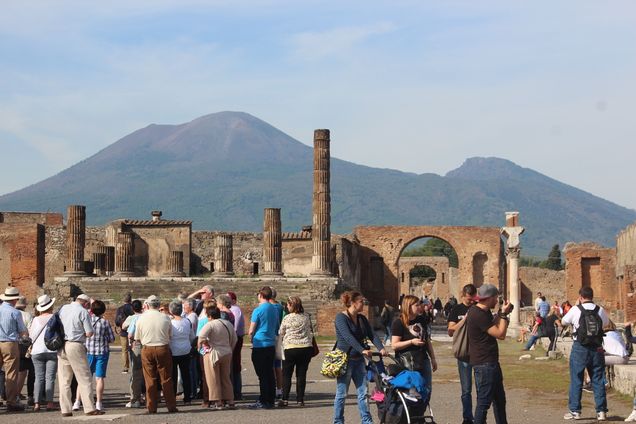
A valuable example of contemporary tourist folklore operates at the ruined city of Pompeii, an archaeological park near Naples, Italy (fig. 1). Pompeii is an important example not only because of its notoriety as a “dark tourist site”—a site associated with death and trauma—but also because it is one of the most visited UNESCO sites in the world, with approximately three million visitors per year. 6 Using frameworks offered by Marcel Mauss and Michel Foucault, this essay utilizes the cultural heritage site of Pompeii as a means to explore the tourist folklore phenomenon. While the example of tourist folklore at Pompeii is not representative of all types of heritage sites and folklore, it provides an example through which to discuss themes of magic, dark tourism, and spectacle.
A discussion of the origins and function of tourist folklore requires an introduction to “contagion magic,” a dominant force fueling superstition and mysticism at Pompeii. The concept of magical contagion is best summarized by French sociologist Marcel Mauss in his book A General Theory of Magic :
The idea of magical continuity, realized through the relationship between parts and the whole or through accidental contact, involves the idea of contagion. Personal characteristics, illness, life, luck, every type of magical influx are all conceived as being transmitted along a sympathetic chain….However, magical contagion is not only an ideal which is limited to the invisible world. It may be concrete, material and in every way similar to physical contagion. 7
In other words, once a person comes into physical or spiritual contact with an object, person, or entity, its essence, properties, or spiritual links are transmitted to the person. Contagion curses imply that the physical act of touching and subsequently removing an object from its home initiates spiritual contagion. The physical act of theft provokes bad luck caused by the object, the land, or a deity, which afflicts the offender and sometimes even their family and friends.
Pompeii shares similarities with the tourist folklore and mummy curses associated with the excavations of ancient Egyptian tombs. Anthropologist Anna Wieczorkiewicz dissects this societal fascination with ancient bodies and death, and concludes that “mummies, skulls, and skeletons become our fetishes in seeking meaning” about our own mortality. 8 At Pompeii, visitors are immersed in a past world of paganism, debauchery, and destruction, where they play the roles of archaeologist, discoverer, adventurer, ancient Roman, and tourist. 9 As a result, Pompeii becomes a dark tourist site where death and destruction are commodified and fetishized. This “quasi-religious mystique” of Pompeii is a crucial factor in a tourist’s decision to steal from the site. 10 Visitors to dark tourist sites “seek tangible symbols of the place, the memory, meanings and experiences,” where material objects offer a medium through which they can reflect and channel complicated feelings or difficult memories. 11 In addition to these motivations, I propose that the act of stealing artifacts from dark tourist sites like Pompeii is an act of defiance against mortality. It is a direct challenge to the destruction and death one must face at Pompeii—it gives the thief an illusion of control, both literal and metaphorical, over natural forces.
In October 2020, the media amplified the sensationalized story of a “cursed” Canadian woman who had visited Pompeii in 2005. 12 She stole “two white mosaic tiles, two pieces of [amphorae], and a piece of ceramic wall” as souvenirs from her visit. 13 In 2020, the woman returned the artifacts along with a letter, which stated that she “wanted to have a piece of history that couldn’t be bought,” and which she claims plagued her with bad luck and “negative energy” for 15 years. 14 In the letter, she cites examples of her misfortune, including a breast cancer diagnosis and financial loss. 15 She implies that the bad luck associated with the artifacts was the direct result of desecrating such a powerful site of trauma, loss, and destruction; it was a disrespectful act which activated Pompeii’s magical contagion.
Luana Toniolo, Archaeological Officer of Pompeii, has estimated about 200 returns of stolen material to Pompeii over the past ten years, both resulting from and in anticipation of the potential curse. 16 Toniolo suggested that artifacts which have been removed from their findspot lose their “strength as historical objects,” a quality which is crucial for the park’s mission of preservation and education. 17 The park’s desire to deter tourists stealing and displacing artifacts led to a fascinating exhibition on the site’s tourist folklore. In response to the 2020 letter regarding the curse, curators at the Antiquarium of Pompeii compiled a temporary exhibition of letters and returned “cursed” objects. According to CNN, the purpose of the exhibition was anthropological, as a documentation of tourist interactions at Pompeii, but the underlying message is clear: do not steal from the site or else. 18 News and media coverage of the alleged curses and subsequent exhibition further sensationalized the tourist folklore narrative maintained by the park’s staff.
The curse of Pompeii further perpetuates this air of mystique offered by dark tourism, and the stewards of Pompeii are using it to their advantage. By displaying returned cursed objects in the Antiquarium and in the media, the custodians of Pompeii are simultaneously creating further interest in the site while protecting it from future damage. The curse brings more visitors to the park, but the threat of magical contagion keeps them in line. At a place like Pompeii, which spans 170 acres, it is impossible to always surveil guests. This is where the curse plays a crucial role. In Foucault’s panopticon, a prisoner surveillance system which functions as a metaphor for modern society’s structure, the threat of constant visibility provokes self-regulation. 19 At Pompeii, the threat of the curse plays the singular authoritative role which influences the behavior and social norms of the masses. Fear of this authority creates a system of self-discipline and social control—it is a means of surveillance without a physical entity.
At Pompeii, tourists’ desires to steal from the site stem from uncomfortable encounters with death, destruction, and dark tourism. The curse relies on its mystical associations with paganism and death at the site to both enrapture visitors and the media and ensure the site’s future protection from vandalism and theft. The media spectacle created by the curse serves Pompeii in various ways by preventing destruction and theft, serving as cost-effective security measures, and bringing more attention, visitors, and money to the site. In the face of mass tourism, curses can help communities and custodians regain some semblance of authority over their own heritage and history. However, in some cases, tourist folklore further perpetuates stereotypes and misrepresentations of ancient culture and beliefs. This is true for Pompeii, which is often portrayed in the media as debaucherous and esoteric. It is vital to consider the ways tourist folklore operates in different contexts and how this can positively or negatively impact our collective understanding of history and cultures.
____________________
Rowan Murry received her BA in Art History from the University of Mississippi and is currently pursuing an MA in Museum Studies at New York University. She is particularly interested in Ancient Roman art and archaeology, ethical collecting, and interactive technologies for physical and virtual exhibitions.
1. Mark R. Nelson, “The Mummy’s Curse: Historical Cohort Study,” British Medical Journal 325, no. 7378 (December 21–28, 2002): 1482.
2. Roger Luckhurst, The Mummy’s Curse: The True History of Dark Fantasy (Oxford: Oxford University Press, 2012), 8.
3. Luckhurst, The Mummy’s Curse, 9; “George Herbert, 5 th Earl of Carnarvon,” The British Museum, accessed December 12, 2022, https://www.britishmuseum.org/collection/term/BIOG53843.
4. Joyce D. Hammond, “The Tourist Folklore of Pele: Encounters with the Other” in Out of the Ordinary: Folklore and the Supernatural (Logan, Utah: Utah State University Press, 1995), 159.
5. Other examples of sites that have a history of tourist folklore in order to discourage theft and vandalism include The Petrified Forest in Arizona and Hawai’i Volcanoes National Park.
6. The Palgrave Handbook of Dark Tourism Studies (London: Palgrave Macmillan UK, 2018); “Visitor Data,” Pompeii Archaeological Park. This number does not account for any COVID-19 pandemic closures during 2020–2022. The most recent data comes from 2018.
7. Marcel Mauss, A General Theory of Magic (London: Routledge, 2001), 81–82.
8. Anna Wieczorkiewicz, “Unwrapping Mummies and Telling Their Stories” in Science, Magic, and Religion: The Ritual Processes of Museum Magic (New York: Berghahn Books, 2004), 68.
9. Wieczorkiewicz, “Unwrapping Mummies and Telling Their Stories,” 66.
10. Dorina Buda and Jenny Cave, “Souvenirs in Dark Tourism: Emotions and Symbols,” in The Palgrave Handbook of Dark Tourism Studies (London: Palgrave Macmillan, 2018), 719.
11. Buda and Cave, “Souvenirs in Dark Tourism: Emotions and Symbols,” 719–720.
12. Jack Guy and Nicola Ruotolo, “Tourist returns stolen artifacts to Pompeii after suffering ‘curse’ for 15 years,” CNN, October 13, 2020, https://www.cnn.com/travel/article/pompeii-artifacts-returned-scli-intl/index.html.
13. Guy and Ruotolo, “Tourist returns stolen artifacts.”
14. Guy and Ruotolo, “Tourist returns stolen artifacts.”
15. Guy and Ruotolo, “Tourist returns stolen artifacts.”
16. James Gabriel Martin, “Curious tales of why tourists have been returning ‘cursed’ items to Pompeii,” Lonely Planet , October 26, 2020, https://www.lonelyplanet.com/news/pompeii-cursed-objects-tourists.
17. “About Us,” Archeological Park of Pompeii, accessed December 12, 2022, http://pompeiisites.org/en/archaeological-park-of-pompeii/about-us/.
18. Guy and Ruotolo, “Tourist returns stolen artifacts.”
19. Michel Foucault, Discipline and Punish: The Birth of the Prison (New York: Vintage Books, 1979).
View all posts
The Travelling Dane
– FOR THE CULTURAL TRAVELLER

- bosnia & herzegovina
20 Dark Tourism Sites: From Pompeii to Ground Zero
WHAT IS DARK TOURISM?
Dark tourism is also called thanatourism as thanatos translates to death in Greek (hence then name Thanos in Avengers). It means tourists travelling for sights that are connected with fear, death, trauma and war. Some find problematic, but the way I see it: if we don’t talk about the horrible events in history, we forget them. The dark tourism sites become sites of remembrance. It goes without saying (but I still will) that I can only endorse visiting dark tourism posts to learn about history as to not repeat it and behave with respect!
But within the concept “dark tourism” are completely different attractions and they therefore need different behaviour from visitors. I talked to a researcher on dark tourism and she explained it as a spectrum: at one end is the serious, dark and horrible places like Auschwitz, and at the other less dark end are events like a ghost-walk. The spectrum is a really good way to see it, because it also helps with the way you should behave. Serious and respectful in the dark end and, while you can be more relaxed at the other end. But make sure you get it right.
Dark Tourism sites have (as they said in Cambodia’s Toul Sleng Prison) the aim to encourage visitors to be messengers of peace.
20 Dark Tourism Sites
Sedlec ossuary, bone church in kutna hora, czechia.

An ossuary is a collection of bones. Sedlec Ossuary or Kostnice Sedlec is more than just a collection of bones from 40.000 people. As if that wasn’t enough.
The chapel goes back to 1278 when the King of Bohemia sent the abbot of the Sedlec Cistercian Monastery to Jerusalem. He returned with some soil from the Golgotha aka the “Holy Soil.” Soon everyone wanted to be buried in Sedlec. In the 15th century, a Gothic church was built near the cemetery, and its basement was used as an ossuary. The bones stayed there until 1870, when a woodcarver named Frantisek Rint was appointed to organize the bones. I wonder if the result came as a surprise…

Genocide Museum in Phnom Penh, Cambodia

Tuol Sleng or S-21 is a prison in the Cambodian capital of Phnom Penh. The Tuol Sleng Genocide Museum is the memorial site of the S-21 interrogation and detention center of the Khmer Rouge. The site tells of the tragic period in Cambodian history when in the 1970’s the Khmer Rouge killed millions of the their fellow Cambodians. When I visited in 2003, some of the volunteers at the museum had once been prisoners here.

Pompeii, Italy

Pompeii is probably one of the most famous dark sites. A natural disaster that unlike Tuol Sleng couldn’t be avoided.
Most people were trapped in the city when the nearby volcano Vesuvius erupted in 79. The entire city and its citizens were buried in stones and ashes. The heat was so intense that no human remains were left, but on the spot were they fell, archaeologist later could recreate their shapes from the negative space. Not for the faint of hearted.
The outbreak preserved the city as it was on that day giving us a unique glimpse into the life of an Roman town and everyday life.

The Arcehological area of Pompeii is a UNESCO Site. Also part of the site is the nearby city Herculaneum that suffered somewhat same fate. Definitely worth a visit. Both is easily visited from Naples by train. A new high speed train from Rome will get you to Pompeii in 2 hours .
CHICHEN ITZA
Yucatan, mexico.

TOWER OF LONDON

Tower of London is an old castle in the middle of London. It’s most famous for its prison called the Bloody Tower. You might think this is at the light end of the spectrum with ghost stories, but alas no.
The story behind the nickname is a bloody and sad one, but also not entirely bulletproof. It concerns the supposed murder of the 12-year-old Edward V and his younger brother, Richard, in 1483 on the orders of their uncle Richard III. What actually happened is a mystery. In Westminster Abbey, you can see a small coffin containing the bones of two children found in the tower. But it could also just some of the others that died there. Making it not less sad.
And that’s not to mention all the royal imprisonments, executions and murders that has taken place in the Tower like that of the real braveheart William Wallace. Why the attraction also finds the need to tell ghost stories – I don’t understand.

SHAH-I-ZANDA
Samarkand, uzbekistan.

It’s so pretty, you almost forget it’s an alley of mausoleums. It has some of the most spectacular tilework in the Muslim world – and this is saying A LOT! These stunning necropolis dates back to the 14th century. The avenue of mausoleums consists of grand tombs looking like palaces decorated with colourful tiles.
You might even find the grave of 7th century Qusam, the cousin of the prophet Mohammed, who brought Islam to region. He maybe even be the cause of the name of the place, since it means Tomb of the Living King.

ROSKILDE CATHEDRAL
Roskilde, denmark.

MAUSOLEUM OF FIRST QIN EMPEROR
Xi'an, china.

The famous terracotta warriors are part of a tomb: the mausoleum for the first emperor of China, Qin Shi Huang (259–210 BCE). He unified China into a single political entity and that’s no small deed.
The emperor is mostly remembered for is his impressive burial complex with more than 8000 soldiers, 130 chariots, 520 horses, and 150 cavalry horses! Even more impressive, every soldier is different and unique.

Dachau, Germany

KZ Gedenkstätte in Dachau is a concentration and work camp of the Nazis. Gedenkstätte means a place om contemplation (or more literally: think place) and so it should be. Dachau was the first actual concentration camp. 200000 prisoners from over 40 nations (including Denmark) were imprisoned here and at least 41500 persons died of hunger, illness, torture, murdered, or perished. There’s an explanatory and gruesome exhibition.
I’ve never been to Auschwitz even though I’ve been close by. I’m afraid to go. I have visted Theresienstadt in Czechia, but it was mainly a wok camp and Dachau is even more horrible to visit. It was a beautiful sunny day when we visited, but you felt guilt smiling, eating or drinking. This is a place for serious contemplation on man’s cruelty against man.

VALLEY OF THE KINGS
Luxor (former thebes), egypt.

Paris, France

Beneath the city of lights, you find one of the more overwhelming sites despite it’s not connected to war or catastrophe. Just natural death. The catacombs of Paris.
In the late 1700s, the city grew and so did the population, and hence more people need a burial place. The old cemeteries from the Middle Ages was becoming health hazards. So the bones were moved from several cemeteries to an underground Roman tunnel system.

VALLEY DE LOS INGENIOS
Trinidad, cuba.

The name is beautiful and the tower overlooking the lush lands are pretty, but the site is connected to the slave-dependant sugar trade. The tower was built to keep an eye on the enslaved workers.
In 1827 more than 11000 slaves were working in the mills. The plantations, mills and other facilities in the 225 km2 large Valley de los Ingenios is an example of the richest and best-preserved of the Caribbean sugar agro-industrial process of the 18th and 19th centuries, and of the slavery associated with it.

SHOES ON THE DANUBE
Budapest, hungary.

At the lighter end of the spectrum is the Labyrinth beneath Buda Castle , where Dracula was once held. But it’s not all fake horror stories: The labyrinth was functioned as both a prison and as a torture chamber and in the 15th century, its darkest chambers held its most infamous resident — Vlad Tepes. I went down with my son, but found it too scary.
THE BLOODBATH
Stockholm, sweden.

The Danes and the Swedes have long been enemies – longer than friendly neighbours. Our bloody history climaxed in the bloodbath of Stockholm, where the streets were literally running with blood and the phrase might even come from here.
The Bloodbath might not be an internationally known event, but as a Dane I feel obligated to remember my own dark past. In 1520, the Danish King Christian II mass executed the Swedish nobles. It all took place in the now lovely square Stortorget in the center of the old Swedish capital.

HO CHI MINH MAUSOLEUM
Hanoi, vietnam.

The Mausoleum is huge! The grey marble monument holds the remains of the Vietnamese revolutionary leader and President Ho Chi Minh. It was finished in 1975 and is locally known as Uncle’s Mausoleum. Actually, he just wanted to be cremated and scattered across the country to save land for agriculture, but no. He lies in a glass sarcophagus like Sleeping beauty.

Warsaw, Poland

At the end of WWII, the Polish capital of Warsaw was heavily bombed. 85% of the city was wiped out! The bombing came right after an uprising by the Polish people. They fought for 63 days without help from the rest of us and the uprising was the largest resistance against the Nazis. The uprisers lost, and as a result ALL the Warsaw residents were removed from the city and many killed.

GROUND ZERO
New york, usa.

It goes without saying New York has more to explore. Apparently, there are catacombs, but I haven’t been. A trip to the site where Lennon was shot is also popular.
Church of Holy Sepulchre
Jerusalem, israel.

Sarajevo, Bosnia & Herzegovina

A shot started World War 1. On the corner of the Latin Bridge and Zeleni Beretki 1, the Serbian nationalist . Princip shot the heir to the throne of the Austro-Hungarian empire Archduke Franz Ferdinand and his wife Sophie. On the corner of the shooting, you can see pictures of the funeral and more in the windows of the Sarajevo Museum 1878-1918 . You can also have your picture taken in a similar car dressed as the Archduke. Not sure what’s the fun in that – to me it seems like a confusion of what par t of the spectrum this site is.

I just visited Belgrade in Serbia, where they see the story differently. Gavrilo Princip is praised as a Serbian nationalist hero and even has a park named after him.
Sankt Petersburg, Russia

Share this:
- Click to share on Facebook (Opens in new window)
- Click to share on Twitter (Opens in new window)
- Click to share on Pinterest (Opens in new window)
- Click to email a link to a friend (Opens in new window)
- Click to print (Opens in new window)
MORE INSPIRATION
Leave a reply cancel reply.
This site uses Akismet to reduce spam. Learn how your comment data is processed .
Privacy Overview
Discover more from the travelling dane.
Subscribe now to keep reading and get access to the full archive.
Type your email…
Continue reading

30 Dark Tourism Destinations and How to Visit
By: Author Zachary Friedman
Posted on Last updated: March 1, 2024
Categories Travel Destinations
Home » Travel » Travel Destinations » 30 Dark Tourism Destinations and How to Visit
Many of us have a natural morbid curiosity. Death, disasters, atrocities, and destruction fascinate us. Every year, millions of people travel to some of the darkest and most tragic sites on earth to satisfy that curiosity as well as to gain a deeper understanding of the events that took place there. This is called dark tourism. In this guide, we’ll outline some of the most popular dark tourism destinations and explain how to visit them. We’ll also explain exactly what dark tourism is and talk a bit about the ethics, controversies, and motivations of dark tourism.
Personally, I’m a big fan of dark tourism. Over the years, I’ve visited many of the dark tourism sites on this list. In this guide, I’ll share my experience.

Table of Contents
- Auschwitz-Birkenau Memorial, Poland
- Chernobyl Nuclear Disaster Site, Ukraine
- Choeung Ek Killing Fields and S-21, Cambodia
- September 11 Memorial and Museum, New York
- Hiroshima Peace Memorial Park and Museum, Japan
- Kigali Genocide Memorial, Rwanda
- Pompeii, Italy
- Slave Castles, Ghana
- Sedlec Ossuary, Czech Republic
- Alcatraz Island, San Francisco
- Suicide Forest (Aokigahar), Japan
- Fukushima, Japan
- Robben Island, South Africa
- Pearl Harbor, Hawaii
- The Colosseum, Rome
- Mount St. Helens, Washington
- Anne Frank House and Museum, Amsterdam
- Various Nuclear Test Sites
- The Catacombs of Paris
- Warsaw Ghetto, Poland
- Perm-36 Gulag, Russia
- Cremations on the Ganges River in Varanasi, India
- WWII memorials and museums in Berlin, Germany
- Communist Leader Mausoleums
- Somme Battlefield, France
- Verdun Battlefield, France
- D-Day Beaches and Memorials in Normandy
- Antietam National Battlefield, Sharpsburg, Maryland
- Cu Chi Tunnels, Vietnam
What is Dark Tourism?
Dark tourism is a relatively new term for a form of tourism that involves travel to a site where death, tragedy, disaster, violence, atrocity, or suffering took place. This could include sites of genocide, assassination, natural disaster, war, terrorism, man-made disaster, etc. Usually, dark tourism sites have some kind of historical significance. They could also be the site of a recent or ongoing tragic event. Dark tourism is also called black tourism, morbid tourism, and grief tourism.
A few of the most well-known and popular dark tourism sites in the world include the ruins of Pompeii, Auschwitz concentration camp, the site of the Chornobyl nuclear disaster, the Paris Catacombs, Gettysburg, Ground Zero, and the 9/11 memorial in New York. In each of these sites, death, suffering, tragedy, or disaster took place.
Most people visit dark tourism sites for educational purposes. These sites usually have interesting histories. Some people visit because these sites pique a morbid curiosity. Others just want to witness large scale destruction and damage. Everyone has their own motivation.
There are different types of dark tourism as well. For example, dark tourism and heritage tourism are sometimes closely related. For example, someone may choose to visit Holocaust sites to learn about the events that their ancestors experienced. Descendants of slaves may choose to visit slavery heritage sites. Some consider this a form of dark tourism as well.
To consider someone a dark tourist, they must visit the site for dark tourism purposes. Some sites have a dark element but aren’t exclusively visited for dark tourism purposes. For example, if you visit Mount St. Helens to go for a hike, you’re not a dark tourist. If you visit to learn about the volcanic eruption and the damage it caused, you are a dark tourist.
Dark Tourism Destinations
1. auschwitz-birkenau memorial and museum, poland.

Located outside of Krakow, Poland, Auschwitz was the largest and most deadly of the Nazi concentration camps. Between 1.1 and 1.6 million men, women, and children were murdered here during the Holocaust. Auschwitz is one of the largest mass murder sites in the world.
Today, the site symbolizes genocide and the evil acts that humans inflict upon one another. It also acts as a valuable education tool to help prevent atrocities such as the Holocaust from happening again.
Auschwitz is actually a series of 40 concentration camps rather than one large camp. Auschwitz I is the older and smaller camp where political prisoners were held. Here, you’ll see a terrifying exhibition of some of the inmates’ possessions including piles of suitcases, shoes, and human hair.
Auschwitz-Birkenau, which is located a couple of miles down the road, is a much larger concentration camp and extermination camp. Here, you’ll find the ruins of the infamous gas chambers, barracks with wooden shelves where prisoners slept, and the train track which was used to haul thousands of people into the camp.
Auschwitz has become a mass tourist site seeing over 2 million visitors per year and over 60 million visitors since the site opened in 1947. This is probably the world’s biggest and most well known dark tourism site. The Auschwitz Memorial is free to enter but you should book in advance. Only a limited number of tickets are available per day because the site is so popular.
2. Chernobyl Nuclear Disaster Site, Ukraine

On April 26, 1986, the world’s worst nuclear meltdown took place at the Chernobyl nuclear power plant near Pripyat, Ukraine. This disaster caused the death of around 4,000 individuals from radiation-related illness as well as the displacement of over 300,000.
The area is still not safe for people to inhabit, even though some have moved back into their villages anyway. In fact, scientists believe it could take 20,000 years before the exclusion zone is completely safe. The radiation has dissipated enough for tourists to make short visits on guided tours.
Several tour companies offer day trips and multi-day trips to Chernobyl from the nearby city of Kyiv. During the tour, you’ll see the radiation-contaminated Red Forrest and eerie abandoned buildings including the famous Pripyat Amusement Park and a Kindergarten. You’ll also learn about the impact the disaster had on the region.
Keep in mind that there is still a risk of radiation poisoning when visiting the Chernobyl exclusion zone. Radiation levels are still hazardous in much of the zone. Your guide will explain the safety precautions you must take and guide you through the areas that are safe enough to visit.
Chernobyl is one of the world’s most famous and popular dark tourism sites. The recent HBO miniseries, Chernobyl, greatly increased the popularity of the area. Following the release of the show, tourism increased by 30%.
Note: Currently, it’s not possible to visit this site. Hopefully, it will be possible to visit again in the near future.
3. Choeung Ek Killing Fields and Tuol Sleng Genocide Museum (S-21), Cambodia
The Khmer Rouge regime came into power after the Cambodian civil war ended in 1975. The new government was called the Communist Party of Kampuchea. Their leader was prime minister Pol Pot.
Immediately following the end of the war, the Cambodian genocide began. From 1975 to 1979, between 1.7 and 2.5 million people were killed at 300 sites throughout the country. These sites are known as killing fields.
The most famous of these killing fields is Choeung Ek, which is located about 11 miles outside of Phnom Penh, the capital of Cambodia. It is estimated that around 17,000 men, women, and children were killed at this site. Many were killed violently with knives, scythes, bats, and bayonets. This is the main memorial for the Cambodian genocide.
At this site, you’ll see a memorial Buddhist stupa made of glass. Inside the stupa, there are 5,000 human skulls. Many of the displayed skulls are catastrophically damaged, showing the brutal manner in which the victims were killed. The site also includes a mass grave that contains the remains of almost 9,000 people that were exhumed from the surrounding area. Human bones still litter the entire site. Occasionally fragments wash up after heavy rain.
Another famous Cambodian Genocide site is the Tuol Sleng Genocide Museum or S-21. This museum is located in Phnom Penh. Originally, this site was built as a secondary school but was converted into a prison by the Khmer Rouge. Around 20,000 people were imprisoned here during Pol Pot’s reign. Many were tortured and killed. Here, you’ll see prison cells, photos of victims, as well as an exhibit that documents the events of the Cambodian genocide.
4. National September 11 Memorial and Museum, New York

This New York City memorial and museum was built to commemorate and honor the 2,977 people who died in the September 11, 2001 terror attacks as well as the six people who died in the 1993 World Trade Center bombings. The memorial sits on the site where the twin towers once stood.
The main memorial, called Reflecting Absence, consists of two 1-acre pools that occupy the exact footprints where the Twin Towers stood. Each pool features a large waterfall. Bronze parapets with the name of each victim etched in surround the pools. The September 11 Museum, located underground, contains thousands of images, artifacts, recordings, and videos. The exhibit tells the complete story of the events of 9/11.
This site is fairly controversial. Partly for the high price of entry ($24) but mostly for the fact that the remains of over 1000 victims were placed in a tomb in the bedrock under the museum. Many people find this disrespectful. Even so, the 9/11 Memorial is one of the world’s most popular dark tourism sites. Over 6 million people visit this memorial per year.
5. Hiroshima Peace Memorial Park and Museum
This memorial and museum commemorate and honor the city of Hiroshima and the 140,000 people who died when the United States dropped an atomic bomb on the city on August 6, 1945. It also memorializes the world’s first nuclear attack. The aim is to educate people about the danger of nuclear weapons as well as to promote peace.
The atom bomb, codenamed “Little Boy,” detonated 600 meters above the busiest part of downtown Hiroshima. The explosion essentially leveled the area except for a few ruins. This event marked the beginning of the end of WWII. Japan surrendered on August 15, 1945. The park was built on the site of the bombing. Today, the Hiroshima Peace Memorial Park contains a number of monuments as well as a museum and a lecture hall.
Hiroshima Peace Memorial Museum is the main feature of the park. The museum educates visitors about the events leading up to the bombing as well as the catastrophic effect the bomb had on the city. You’ll see photos and artifacts from the bombing. A major section of the museum is dedicated to the stories of the victims and survivors.
The A-Bomb Dome is the second most important site in the park. This is the ruins of the Hiroshima Prefectural Industrial Promotion Hall. Today, it’s just a shell of a building. This building is significant because it is one of the only buildings that survived the blast. Most structures in Hiroshima were built from wood and burned up in fires that the bomb started. This building was also just 150 meters from the hypocenter of the blast. It has been designated a UNESCO World Heritage Site.
A few more significant points of interest in Hiroshima Peace Memorial Park include Children’s Peace Monument, Peace Flame, Peace Bells, Peace Pagoda, Gates of Peace, and Atomic Bomb Memorial Mount. You could easily spend half a day wandering around the park viewing the various monuments and memorials.
3 days after the bombing of Hiroshima on August 9, 1945, The United States bombed the city of Nagasaki in a second nuclear attack. Today, you’ll find a number of memorials and museums including the Atomic Bomb Museum, Peace Park, Oka Masaharu Memorial Peace Museum, and more.
6. Rwanda Genocide Sites (Kigali Genocide Memorial and Murambi Genocide Memorial)
In 1990, a rebel group of Tutsi refugees called the Rwanda Patriotic Front (RPF) invaded Rwanda from Uganda. This started the Rwandan Civil War. President Juvénal Habyarimana signed peace accords in 1993. The following day, the president was assassinated. Genocidal killings of Tutsi people began soon after and the civil war resumed.
The Rwandan genocide lasted from April 7 to July 15, 1994. During that time 500,000-1,000,000 people were killed. This includes about 70% of Rwanda’s Tutsi population. The genocide ended when the RPF captured Kigali and gained control of the country. The government and genocidaires were forced into Zaire (now the Democratic Republic of the Congo).
Today, there are a number of genocide memorials located throughout the country. The largest and most visited is the Kigali Genocide Memorial Centre. The remains of an astonishing 250,000 people are interred at this site. The attached museum includes three exhibits. The first documents the events of genocide from start to finish. The second exhibit is a memorial to the children who died. It includes photos and details about their lives, things they liked, and the way they died. The third exhibit covers genocide around the world.
The Murambi Genocide Memorial (Murambi Technical School), located in southern Rwanda is one of the darkest dark tourism destinations on the planet. Here, around 50,000 Tutsi men, women, and children were murdered by Hutu Interahamwe militiamen in April of 1994.
The Tutsis were told that they could safely shelter at the school and that the French military would protect them. This turned out to be a trap. After being starved for several days to weaken them, they were attacked and killed. Only 34 people survived the attack and escaped. At Murambi, the remains of 800 people are displayed partially decomposed and preserved by lime.
7. Pompeii, Italy

This ancient Roman city was wiped out when nearby Mount Vesuvius erupted in 79 AD. Historians estimate that about 2,000 people died in the disaster. The thick layer of ash and pumice that covered the city preserved this little slice of ancient Rome.
At the ruins, you can see beautifully preserved artwork, pottery, casts of people who died, houses, an amphitheater, and more. Pompeii is a UNESCO World Heritage site and is one of Italy’s most popular tourist destinations with over 2.5 million visitors per year.
Some people question whether or not Pompeii is actually a dark tourism site due to the age of the site. After all, the eruption occurred nearly 2000 years ago. In my opinion, Pompeii is absolutely a dark tourism site due to the large scale death and destruction that happened here. The age of the site is irrelevant.
8. Slave Castles, Ghana (Cape Coast Castle and Elmina Castle)
During the colonial period of West Africa, the British, Dutch, and Portuguese built around 40 castles or forts along the Gold Coast. The Europeans originally used these castles as trading posts for timber or gold.
During that time, African slaves were in high demand in the Americas. The European traders quickly found that the slave trade was more profitable.
They modified their forts to hold as many slaves as possible. Usually in an underground dungeon. African slavers would capture slaves inland then sell them to the Europeans who lived in the castles on the coast. The slaves stayed in the castles until they were shipped across the Atlantic to the Americas.
Living conditions for the slaves were horrible. Slavers shackled and packed the slaves into the castle’s dungeons. There was very little light or ventilation. There was no water or sanitation so the floors were covered in waste. Many became ill. The slaves lived in these conditions for up to three months before being shipped across the Atlantic.
Today, dark tourists visit these castles to learn about the horrors of the slave trade. Two of the most significant castles to visit include Elmina Castle and Cape Coast Castle. Both are located in Ghana. Guided tours are available.
Elmina Castle was the first European trading post and is the oldest European building in Sub Saharan Africa. The Portuguese built the castle in 1482. Today, it is a UNESCO World Heritage Site. Here, you can see the famous ‘Door of No Return’ where slaves exited the castle before boarding ships to Brazil and other Portuguese colonies. You’ll also see the dungeon where the slaves were held as well as the living quarters for the European slavers, who lived on the upper floors of the castle.
Cape Coast Castle was built by Swedish traders in 1653. Over the years, the castle changed hands multiple times until it came into British possession. Here, you can see the dungeons where slaves were held and cannons that were used to defend the fort. In 2009, President Obama visited Cape Coast Castle during his visit to Ghana.
9. Sedlec Ossuary, Czech Republic
This small Roman Catholic chapel is located in a cemetery in a suburb of the city of Kutná Hora in the Czech Republic. Here, you’ll find the remains of 40,000-70,000 people. Initially, the remains were moved from the cemetery into the basement of the chapel to solve an overcrowding problem that was caused by the plague in the 14th century.
In 1870, a local artist named František Rint rearranged the piles of bones into artwork. The most impressive piece is a massive chandelier in the center of the chapel that is made entirely from human bones. Supposedly it contains at least one of every bone in the human body.
Another interesting piece is a large coat of arms made from bones. In the corners of the chapel, you’ll find large stacks of bones. There are cabinets filled with damaged skulls of those who were killed violently in war. The artist also signed his name in bones.
You can visit Selded Ossuary as a day trip from Prague. It’s easy to visit independently by train. Organized tours are available as well. The chapel is pretty small. It only takes 20 minutes or so to see the whole thing. The place gets pretty crowded as it receives over 200,000 visitors per year.
10. Alcatraz Federal Penitentiary, San Francisco

Also known as The Rock, Alcatraz Federal Penitentiary was a maximum-security prison from 1934-1963. It is located on an island in the San Francisco Bay, 1.25 miles offshore. During the 29 years that the prison operated, some of the hardest criminals of the day served time here including the infamous Al Capone, Machine Gun Kelly, Henri Young, and ‘the Birdman of Alcatraz’, Robert Stroud.
For punishment, prisoners were sent to solitary confinement, known as ‘the hole’ at Alcatraz. These inmates got one shower and one hour of exercise per week. Almost equally punishing for some, the prison sits close enough to the mainland that prisoners could see people going about their lives on the outside.
Today, Alcatraz is San Francisco’s most popular tourist attraction with up to 1.5 million visitors per year. The National Park Service manages the island. After arriving at the island by boat, you can take a tour of the prison. You’ll see the prison cells, learn about the dark history of the island, and hear stories of former inmates. Much of the prison remains the way it was while the prison was in operation.
11. Suicide Forest (Aokigahar), Japan
This forest, located to the Northwest of Mount Fuji, is famous for being one of the most popular suicide site in Japan. In 2003, a record was made when 105 bodies were found in the forest. In 2010, over 200 people attempted suicide here with 54 of those being successful.
The most common methods of suicide used are hanging and drug overdose. Because the suicide rate is so high here, Japanese officials installed a sign at the entry to the park which urges suicidal people to seek help.
Part of the reason for the popularity of this forest as a suicide site is that the area has long been associated with death in Japanese culture. The forest is said to be haunted by the yūrei, which are spirits that can’t leave our world.
Here, visitors can roam about the many trails that wind throughout the 30 square kilometer forest. This is an excellent place to enjoy the solitude of the dense forest. Tours are available as well.
Some visitors come here to see if they can spot a body. As you can imagine, this is a very controversial form of dark tourism. For example, YouTuber Logan Paul was criticized for filming a video of a man who had recently committed suicide here in 2018.
12. Fukushima, Japan
On March 11, 2011, an earthquake off the east coast of Japan triggered a tsunami that flooded the reactors at Fukushima nuclear power plant and caused an electrical grid failure. The reactors lost their cooling which led to three nuclear meltdowns at the plant. 154,000 people had to be evacuated. Many were never able to return to their homes.
Today, there is a 20 km exclusion zone surrounding the nuclear plant to protect people from radiation exposure. In 2018 tours to visit the exclusion area began. In 2020, The Great East Japan Earthquake and Nuclear Disaster Memorial Museum opened. On the tour, you’ll see abandoned structures and witness the effects that the disaster had on the region.
13. Robben Island, South Africa
Robben Island, located in Table Bay, north of Cape Town, was used as a prison from the colonial times of the late 1600s until 1996. The prison gained notoriety during the apartheid era of South Africa. It held political prisoners between 1961 and 1991.
The most famous prisoner was political revolutionary, Nobel Peace Prize recipient, and president of South Africa, Nelson Mandela. He served 18 of his 27-year imprisonment on Robben Island before his release in 1990. in 1994, South Africa elected Mandela as the first president. A total of three former inmates went on to become South African presidents including Kgalema Motlanthe and Jacob Zuma.
Conditions in the prison were incredibly harsh. Prisoners were held isolated from one another in small cells. The prison was segregated by race. Food rations were small and communication with the outside world was limited. Prisoners were also forced to do hard labor in a lime quarry located on the island.
Today, Robben Island is a UNESCO World Heritage Site and a South African National Heritage Site. The only way to visit Robben Island is on a guided tour. The tour leaves from Cape Town and lasts for about 3.5 hours. The guides are all former prisoners. They take you around the prison and share their first-hand stories about their time there. You’ll see the lime quarry where the prisoners were forced to work as well as Nelson Mandela’s prison cell.
14. Pearl Harbor, Hawaii
On December 7, 1941, the Imperial Japanese Navy Air Service surprise attacked the United States naval base at Pearl Harbor, Hawaii. The goal of the attack was to prevent the United States Navy fleet from interfering with the Japanese military plans to expand throughout Southeast Asia. If Japan crippled the United States fleet was crippled, they could invade and conquer US and British held territories such as the Philippines, Guam, Singapore, Malaysia, and Hong Kong, as well as other small islands of the Pacific.
The Japanese launched a massive attack with 353 aircraft which took off from six aircraft carriers. They sank 4 of the 8 battleships stationed at Pearl Harbor. They seriously damaged the other four. 188 aircraft were also destroyed in the attack 159 were damaged. The attack killed 2,403 Americans and injured 1,178. The attack also damaged or destroyed a considerable amount of the base’s infrastructure including a power station, piers, various buildings, and more.
The most significant loss was the battleship USS Arizona. It suffered a direct hit to an ammunition magazine which exploded and caused the ship to sink almost instantly. 1,000 sailors sank with the ship.
The attack on Pearl Harbor dragged the United States into World War II. The day after the attack, Japan declared war on the United States. The next day, the United States declared war on Japan. Three days later, Germany and Italy both declared war on the United States.
Today, there are a number of museums and memorials at Pearl Harbor that commemorate the attack. The main site is the USS Arizona memorial. This memorial straddles the sunken ship and is accessible only by boat. Inside, you’ll see a number of exhibits including one of the ship’s anchors, a shrine with the names of all of those who died as well as some plaques with information about the attack. There is also an opening in the floor where you can view the deck of the ship underwater. Onshore, there is also a museum that outlines the events leading up to the attack and the attack itself.
Nearby, you can also view the USS Missouri Memorial, USS Utah Memorial, USS Oklahoma Memorial, Pacific Aviation Museum, and USS Bowfin Museum.
15. The Colosseum, Rome

Built in Ancient Rome between 72-80 AD, the Colosseum is one of the oldest and most recognizable dark tourism sites. At the time, it was the largest amphitheater ever built with a capacity of 50,000-80,000 spectators. The Colosseum, also known as the Flavian Amphitheatre, hosted a number of dark and violent events including gladiatorial events, executions, animal hunts, and battle re-enactments.
The most famous of these events were the gladiatorial contests. People and animals brutally battled to the death for the entertainment of thousands of spectators. Most gladiators were slaves, criminals, or prisoners of war but some volunteered to seek fame and fortune.
Exotic wild animals including lions, hippos, rhinos, elephants, bears, tigers, crocodiles, etc. were brought in from Africa and the Middle East. These animals were used for hunts or battles. In some cases, people were fed to lions.
Over the course of the 400 years that these gladiatorial events took place, historians estimate that around 400,000 people died in the Colosseum. Some people consider these events the earliest form of dark tourism.
Today, the Colosseum is one of the top tourist destinations in Rome and the world. Around 7 million people visit this site per year. There are a number of guided tours available. You’ll see the underground level where the gladiators prepared to fight, the arena floor where the gladiatorial fights took place, areas where the animals were kept, and artwork.
16. Mount St. Helens, Washington
The 1980 volcanic eruption of Mount St. Helens killed 57 people and caused a great deal of destruction to the mountain and surrounding area including the largest landslide in recorded history. The eruption was so violent that the mountain’s elevation decreased by 1300 feet. The top completely blew off.
Many tourists come to visit the area each year. Today, you can see tree stumps and dead trees that still stand around the blast site. There is a visitor center with an exhibition about the eruption. In the visitor center, they also have a small movie theater that shows a short documentary about the event. The surrounding state park offers plenty of hiking, camping, climbing, and other recreational activities.
17. Montserrat
This volcanic island in the Caribbean is sometimes called a modern-day Pompeii. The Soufriere Hills Volcano became active in the mid-1990s and slowly covered the former capital of Plymouth in ash. The town was evacuated in 1997 just before a major eruption covered much of it.
The volcano is still very active today, periodically spewing ash, smoke, and gasses across 1/3 of the island. Occasionally pyroclastic flows cover more of the island’s land. Travelers can hike to a lookout point to view smoke spewing from the volcano and maybe get a glimpse of Plymouth. It is also possible to view the volcano and town by boat. It is unsafe to visit the town of Plymouth at this time.
16. Anne Frank House and Museum, Amsterdam
In this famous canal house Anne Frank, her family, and four others hid from Nazi persecution for 761 days. They quietly lived in a hidden part of the house called the Secret Annex. Anne Frank is famous for keeping a diary of her daily thoughts and experiences during her days in hiding during World War II.
Sadly, Anne Frank and the others hiding in the Secret Annex were betrayed by an unknown informant and discovered by the Nazis on August 4, 1944. The Nazis split them up and moved them to various concentration camps. Anne Frank died in Bergen-Belsen concentration camp in February of 1945 when she was just 15 years old. Anne’s father Otto, who survived the Holocaust, discovered his daughter’s diary after the war and published it in 1947.
The canal house where the two families hid is a now museum that attracts up to 1.2 million visitors per year. Here, you can walk through the Secret Annex where Anne Frank and her family hid. The original diary is on display in the attached museum. The museum also includes a permanent exhibit about the life of Anne Frank and her experience during the war.
19. Nuclear Test Sites
Since nuclear testing began in 1945, 8 countries have detonated around 2056 nuclear bombs at dozens of test sites around the world. A few nuclear test sites that you can visit include:
- Semipalatinsk Test Site (The Polygon)- Semipalatinsk was the Soviet Union’s primary nuclear test site from 1949-1991. It is located on the steppe of northeastern Kazakhstan. More nuclear weapons detonated here than anywhere else on the planet. Beginning in 2014 parts of the area have opened up for tourism. There isn’t all that much to see here outside of some massive craters and some concrete towers and bunkers that housed instruments to measure the blasts.
- Nevada Test Site- This site was the United States’ main nuclear testing site from the time it was established in 1951 until nuclear testing ended in 1992. The site is located about 65 miles to the northeast of Las Vegas. Here, you can see a number of large craters in the desert where nuclear weapons were detonated for testing purposes. Monthly public tours are offered but are often fully booked months in advance. This is a difficult place to visit.
- Bikini Atoll, Martial Islands- This was one of the United States’ main nuclear test sites. Between 1946 and 1958, 23 atomic bomb tests were performed here. The blasts turned out to be more destructive than anticipated and resulted in significant contamination to the surrounding area. Probably the biggest attraction for tourists here is Scuba diving the 10 ships that were sunk during nuclear tests. This is a risky area to visit due to the significant levels of radiation that still exist.
20. Catacombs of Paris, France

This network of underground ossuaries underneath the city of Pairs holds the remains of around 6 million people. The tunnels were originally mine tunnels. The Paris Catacombs were built to solve the problem of the city’s overflowing cemeteries. The dead were crowding the living. Starting in 1786, the city began transporting human remains from the city’s cemeteries into the underground tunnels by covered wagon during the night. The catacombs open to tourism in 1867.
Today, the Catacombs are one of the more popular tourist destinations in Paris. You can book a guided tour and wander through the labyrinth of bone filled tunnels and view the millions of bones stacked neatly throughout. Around 300,000 people visit this site per year. It is only accessible by tour.
21. Warsaw Ghetto, Poland
Ghettos were segregated neighborhoods where Jewish people were forced to live while under Nazi occupation during WWII. The largest of these was the Warsaw Ghetto. The area actually consists of two smaller ghettos with a footbridge between them. At its peak, approximately 460,000 people lived in Warsaw Ghetto.
During the Uprising the ghetto was almost completely destroyed. Today, you can visit the area and view a small number of streets and buildings that survived. The monument called ‘The Footbridge of Memory’ stands at the site of the original footbridge.
22. Perm-36 Gulag, Russia
Following the Bolshevik Revolution, the Soviet Union built a large system of forced labor camps to imprison ‘enemies of the state.’ These included government officials, military members, and regular citizens. Anyone who was anti-communist or anti-Stalin was imprisoned. These camps were known as gulags. Millions of people were held in these camps and forced to perform backbreaking work in extremely brutal conditions.
Perm-36 is the only remaining Soviet gulag. It is located about 60 miles from the Russian city of Perm in the Western Ural Mountains. The camp operated from 1946-1987. Perm-36 is unique because it was not closed after Stalin’s death in 1953. This is one of the only gulags that was not demolished after the Soviet Union collapsed in 1991.
When Perm-36 opened, it was used as a forced labor camp for regular criminals. In later years, the camp housed political prisoners. The prisoners were forced to do logging work. Some political prisoners lived in 24 hour closed cells. Perm 36 was considered the harshest political camp in the Soviet Union.
Today’s site operates as a museum and memorial called The Museum of the History of Political Repression Perm-36. It opened to the public in 1995. Here, you’ll see the wooden barracks that the prisoners built, various prison buildings, and an exhibit about the gulag system and the prisoners. You’ll also learn about the economic benefit that the gulag system created for the Soviet Union.
23. Cremations on the Ganges River in Varanasi, India

Varanasi is a holy city located on the Ganges river in Uttar Pradesh, India. The city has become a popular dark tourism destination for its famous Hindu cremation ceremonies that take place on the banks of the river. In the Hindu religion, people believe that cremation on the banks of the Ganges river breaks the cycle of reincarnation so they can achieve salvation. Along the river, dozens of cremations take place out in the open every day.
The bodies are placed atop piles of wood and set on fire until they turn to ash. The ashes are then scattered in the Ganges River, which is considered a holy site in the Hindu religion. Poor families who cannot afford a cremation sometimes release the entire body of their loved one in the river to decompose naturally. Some terminally ill people travel to Varanasi so they can die and be cremated in the holy city.
Tourists are welcome to view and experience these cremation ceremonies. When you arrive at the famous ghats on the bank of the river in Varanasi, you’ll clearly see the cremation sites. Just look for the smoke. You’ll see open areas with large fires and piles of wood sitting around. The cremations take place here.
For a few dollars, you can hire a guide to walk you through the cremation site and explain how the process works. There are multiple cremations taking place simultaneously at all hours of the day. You can walk right up and see the cremation and feel the heat from the fire and smell the smoke.
As you can imagine, this is a fairly controversial form of dark tourism. After all, you are essentially attending a cremation for touristic purposes as the family grieves of the loss of their loved one. Some view this as voyeuristic. It’s up to you to decide whether or not this form of dark tourism is ethical.
24. Berlin, Germany

Berlin is one of the darkest cities on earth. It was the capital of Nazi Germany, one of the world’s most evil regimes. Next, it became the most significant city in the cold war. It was also the capital of the socialist single-party regime of the former GDR. As a result, Berlin is packed with dozens of dark tourism sites. A few of the most popular ones include:
- Memorial to the Murdered Jews of Europe (the Holocaust Memorial)- This memorial is to the Jewish people murdered during the Holocaust. It contains 2,711 concrete slabs ranging in height from .2-4.7 meters. The slabs are arranged in a grid pattern over a 19,000 square meter site. Below the memorial is an information center that contains the names of 3 million Holocaust victims as well as photographs and letters. This memorial is quite controversial. Partly because it is so vague. There is no mention of Nazi Germany or the Holocaust on the memorial itself or in the official name of the memorial. People also use the site as a recreational area, sitting or standing on the pillars. Many consider this to be disrespectful. Due to its size and design, the memorial is difficult to defend from vandals.
- Berlin Wall- Between 1961 and 1989, this concrete barrier divided West Berlin from surrounding East Germany. The German Democratic Republic (East Germany) constructed the wall to prevent East Germans from defecting to the west. The four-meter tall wall extended 155km (96 miles) and cut through 55 streets. Today, you can see several small sections of the wall still standing in the city. The largest is is a 1.4 km section that is part of the Berlin Wall Memorial. Here, you can see the graffiti on the west side and learn about the historical significance of the wall.
- Checkpoint Charlie Museum- Checkpoint Charlie is the most well-known crossing between East and West Berlin. The original guardhouse was preserved and today is part of the Checkpoint Charlie museum. Here, you can see exhibits about the Berlin Wall, the Cold War, and some famous escape attempts.
- Jewish Museum- Designed by architect Daniel Libeskind, the Jewish Museum is one of Germany’s best and most popular museums as well as one of Berlin’s most striking landmarks. Here, you’ll find thousands of artifacts, photos, religious objects, and archives that document the struggle of the German Jewish people from the Middle Ages to the present time. The museum also houses a massive library and hosts various events throughout the year.
- Topography of Terror Museum- This museum is located on the site of the Gestapo secret police and SS headquarters. Allied bombings destroyed the original building in 1945. After many years of delay, the museum opened in 2010. The main exhibit focuses on policing under Nazi rule. You’ll see photos, documents, short films, and artifacts that show the crimes that the SS and Gestapo committed throughout Europe. The grounds of the museum also contain some historic artifacts including a large section of the Berlin Wall. You’ll also see an excavated trench that exposes the cellar wall, where political prisoners were kept, tortured, and ofttimes executed.
- DDR Museum- This newer museum outlines life in East Berlin under communist rule with a hands-on approach. Here, you’ll see a recreation of an interrogation room, prison cell, and an apartment. You can try on clothing and watch television from the era. The exhibit covers food, music, daily life, education, architecture, and more. You’ll also learn about the mass surveillance conducted during the time. This is a private museum and is one of Berlin’s most popular.
25. Communist Leader Mausoleums
For whatever reason, communists love to embalm their leaders after they die and put the bodies on public display. A few famous mausoleums you can visit include:
- Lenin Mausoleum- This mausoleum is located in the Red Square in the center of Moscow. Inside, you can view the embalmed corpse of the Soviet leader Vladimir Lenin. The body has been on public display since shortly after his death in 1924. The mausoleum is open to the public and free to enter. Stalin’s body was put on display here from 1953-1961 but was removed and buried near the mausoleum.
- Ho Chi Minh Mausoleum- This mausoleum is located in Ba Dinh Square in Hanoi, Vietnam. Inside, you can view the embalmed body of Vietnamese revolutionary and president Ho Chi Minh, who died in 1969. The body is kept in a dimly lit glass case which is heavily guarded by military honor guards. The mausoleum is open to the public.
- Mausoleum of Mao Zedong- This large mausoleum, also known as Chairman Mao Memorial Hall, is located in the center of Tienanmen Square in central Beijing. Here, you can view the embalmed remains of Mao Zedong, who served as the Chairman of the Communist Party of China from 1945-1976. Interestingly, Chairman Mao wanted to be cremated. The mausoleum is open to the public.
- Kumsusan Palace of the Sun (Kim Il Sung Mausoleum)- This absolutely massive palace is located in the North Korean capital of Pyongyang. The building was intended to be the official residence of Kim Il Sung but was converted into a mausoleum when he died in 1994. Inside, you can view the embalmed remains of North Korean founder Kim Il Sung as well as his son and former leader of North Korea, Kim Jong Il. Both bodies lie inside of glass sarcophaguses. The mausoleum is open to the public. Foreigners can only enter the palace when they are on an official government tour.
26. Somme Battlefield, France
The Battle of the Somme was a WWI battle fought between the French Third Republic and British Empire against the German Empire. The battle took place between July 1 and November 18, 1916. Over three million men fought in the Battle of the Somme. One million were killed, injured, or went missing, making this the most bloody battle of WWI and possibly the most deadly battle in world history.
Several factors contributed to the massive amount of death in the battle. First, the battlefield was small. The Germans were also well prepared and trained for trench warfare. An incredible amount of heavy artillery was also used in this battle.
The Battle of the Somme ended when British Commander in Chief Sir Douglas Haig decided to stop the offensive near the Somme River. When the battle ended, the British and French armies had gained just six miles of land. Modern historians are not in agreement as to whether or not the battle was a success.
Today, there are a number of monuments, museums, cemeteries, and battle sites that you can visit in Somme. The Remembered Trail leads visitors through some of the most significant locations. It’s is a great place to start in the region. Guided tours of the area are also available.
27. Verdun Battlefield, France
The battle of Verdun lasted from February 21-December 18, 1916, making it the longest battles in World War One at 302 days. This battle was also one of the most costly with up to 1 million casualties between the French and German armies.
Today, you can view the battlefield complete with shell craters that are still visible over 100 years later. You’ll also find several memorials including an ossuary. The battlefield itself contains the remains of 100,000 soldiers. You can also visit the Verdun Memorial Museum which features artifacts from the battle as well as information about the time.
28. D-Day Beaches and Memorials in Normandy
On June 6, 1944, the Allied Forces invaded Nazi occupied France on the beaches of Normandy. This operation, known as Operation Overlord, was the largest amphibious invasion in world history. This event marked the beginning of the liberation of France and Western Europe and eventually led to the Allied victory over the Third Reich on the Western Front. The D-Day invasion of Normandy resulted in 4,000-9,000 German casualties and around 10,000 Allied casualties including 4,414 deaths.
Today, there are dozens of memorials, museums, and war cemeteries along the beaches of Normandy as well as further inland. A few of the most significant D-Day sites to visit include:
- Beach landing sites- The 50 miles stretch of Normandy beach was divided into 5 sections where the invasion took place. The beach landing sites include Utah, Omaha, Gold, Juno, and Sword. Today, you can visit each of the 5 beaches. Probably the most popular beach to visit is Omaha. Here, you’ll see German bunkers and the sculpture Les Braves which commemorates the American soldiers who died on D-Day.
- Utah Beach Museum- This museum outlines the entire D-Day invasion from the planning phase until the end of the battle. Here, you’ll see vehicles, artifacts, and photographs from the massive invasion. The museum overlooks Utah Beach.
- Normandy American Cemetery and Memorial- This cemetery, overlooking Omaha Beach, contains 9,388 graves of American soldiers who died in WWII. Mostly on D-Day.
- Overlord Museum- This museum, located near Omaha Beach and the American cemetery, documents the time period between the Allied landing and the liberation of Paris. Here, you’ll see thousands of artifacts from the invasion including tanks and cannons as well as photos and reconstructed battle scenes.
- Pegasus Bridge- 6000 British paratroopers landed here with supplies and weapons just past midnight on June 6, 1944. Their job was to secure the bridge so German reinforcements couldn’t cross. The current bridge is a reconstruction of the original, which was destroyed.
- Memorial Museum of the Battle of Normandy- This museum, which is located in Bayeux, outlines the military operation in detail. Here, you’ll see military equipment, artifacts, photos, and a fantastic short film about the D-Day landings.
- Caen Memorial Center- This museum outlines the battle of Normandy from the end of WWI all the way to the beginning of the Cold War. This gives you a great overview of the historical events leading up to the war and their effects on Europe and the world. Here, you’ll see letters and personal belongings from soldiers, airplanes, and a short documentary film with footage of the D-Day invasion.
- Airborne Museum- This museum, located in Sainte-Mère-Église, focuses on the paratroopers who landed in Normandy the night before the attack. Here, you’ll see photos, artifacts, tanks, and airplanes including a WACO glider and C-47 that you can enter.
29. Antietam National Battlefield, Sharpsburg, Maryland
On September 17, 1862, Confederate General Robert E. Lee and his Army of Northern Virginia battled Union General George B. McClellan and his Army of the Potomac in the Battle of Anteteitum near Sharpsburg, Maryland. This was the bloodiest battle of the American Civil War with 22,717 dead, injured, or missing. This massive loss of life took place over the course of just 12 hours.
The battle ended when Lee decided to withdraw back to Virginia. McClellan decided not to follow him. The Union claimed victory. After the battle, President Lincoln announced his Emancipation Proclamation which freed 3.5 million slaves.
Antietam is considered to be one of the most well-preserved American Civil War Battlefields. Probably because it was one of the first battlefields preserved in 1890. Today, visitors can take a self-guided tour of the battlefield or hire a tour guide. You’ll see landmarks of the battle such as the Cornfield, Dunker Church, and Burnside’s Bridge.
30. Cu Chi Tunnels, Vietnam
The Cu Chi Tunnels are a massive network of underground tunnels located outside of Ho Chi Minh City, Vietnam. They were used by Viet Cong soldiers for a number of purposes including hiding spots, supply routes, living quarters, hospitals, and food and weapons caches. They were famously used as a base of operation for the North Vietnamese during the Tết Offensive in 1968.
Life in the Cu Chi Tunnels was difficult. Air quality was poor. The tunnels were cramped and claustrophobic. Food and water were limited. Rodents, ants, snakes, scorpions, and spiders infested the tunnels. Diseases including Malaria and intestinal parasites were common. During heavy bombing campaigns, soldiers had to stay in the tunnels for days at a time.
Today, the Cu Chi Tunnels are a war memorial operated by the Vietnamese government. They are also a popular tourist dark tourist attraction. You can visit the tunnels on a day trip from Ho Chi Minh City. Here, you can crawl through a safe section of the tunnels, watch a short film about the war, and view some different booby traps and trap doors as well as an entrance into the tunnels. There is also a firing range where you can shoot Vietnam War era weapons including an M60 machine gun.
My Experience: Why I Enjoy Dark Tourism
My main motivation to visit dark tourism sites is education. For whatever reason, I wasn’t interested in history when I was in school. I just found it boring. Now, I love history. By visiting dark tourist sites, I have gained a deeper understanding of some of the most significant events in world history. It’s so much more real and engaging when you are standing where an event took place and exploring the landscape and looking at actual artifacts.
It’s also amazing to see how human civilization evolves over the years. For example, 2000 years ago, gladiator games were an acceptable form of entertainment. Most people would not be okay with that today. It is also interesting to see how technology, weapons, clothing, politics, and more have changed throughout the years. The world was a completely different place just 20 years ago. Times change quickly.
I also have a pretty strong morbid curiosity. Dark things simply interest me. I find it fascinating to imagine the horrors that humans have endured and overcome.
Final Thoughts About Dark Tourism
Dark tourism often gets a bad rap in the media. People get the idea that it is disrespectful, voyeuristic, sick, or even unethical. Some country’s tourism departments also try to hide their dark tourism sites because they fear a bad reputation. They may not want people to associate the country with its dark past.
The truth is that most dark tourism is simply educational. People like to visit these sites to learn about their history. They also satisfy our natural morbid fascination. There is nothing wrong with visiting dark tourist places, as long as you do so respectfully.
One important thing to remember is that dark tourism is not a new form of tourism. People have been visiting dark sites for as long as tourism has existed. For example, tourists began visiting Pompeii in the 1800s. The gladiatorial games could be considered one of the earliest forms of dark tourism. Those began when the Colosseum opened in 80 AD. People are naturally interested in these types of destinations and will continue to be.
Dark tourism is also a very broad term. Many of the world’s most visited tourism sites can be considered dark tourism sites. There is also a lot of overlap with mass tourism. Most people don’t travel exclusively to visit dark sites. Instead, they pair dark tourism with regular tourist attractions. For example, if someone is in Hawaii, they may spend a day visiting Pearl Harbor and the various memorials then go to the beach the next day. If someone visits Kyiv, they’ll probably take a day trip to Chornobyl because it’s one of the biggest tourist attractions in the region. It’s common to pair dark tourist sites with other types of sites.
Hopefully, this guide helps you in planning your visit to some of the world’s best dark tourism sites.
If you’re on the fence about dark tourism, check out my guide to the ethics and criticisms of dark tourism.
Are you a dark tourist? Share your favorite dark tourism destination in the comments below!
Pin it for later!

More from Where The Road Forks
- 35 Types of Tourism
- How to Plan a Round the World Trip
- 30 Free Things to do While Traveling
- The Best Solo Travel Destinations
- Whale Watching in South Africa: Where to Go
- 21 Free Airline Stopover Options
Zachary Friedman is an accomplished travel writer and professional blogger. Since 2011, he has traveled to 66 countries and 6 continents. He founded ‘Where The Road Forks’ in 2017 to provide readers with information and insights based on his travel and outdoor recreation experience and expertise. Zachary is also an avid cyclist and hiker. Living as a digital nomad, Zachary balances his professional life with his passions for hiking, camping, cycling, and worldwide exploration. For a deeper dive into his journey and background, visit the About page. For inquiries and collaborations, please reach out through the Contact page. You can also follow him on Facebook.
Sharing is caring!
Sign me up for the newsletter!

Visiting Pompeii: 13 Top Things to See
Written by Barbara Radcliffe Rogers Updated Dec 25, 2023
The ruined city of Pompeii lies at the foot of Mount Vesuvius, the volcano whose eruption in AD 79 engulfed and subsequently encased the city in six meters of ash and pumice-stone. Excavated over several centuries, what we see today, together with the neighboring site of Herculaneum , gives the finest example anywhere of a Roman town and its way of life.
It's easy to see why visiting Pompeii is one of the top things to do in Italy . Only 16 years before its destruction, Pompeii was badly damaged by an earthquake from which its population of 20,000 had not yet finished rebuilding. At the first sign of the eruption, people began leaving, so when the final flow descended like a tidal wave, only about 2,000 people remained trapped in the city.
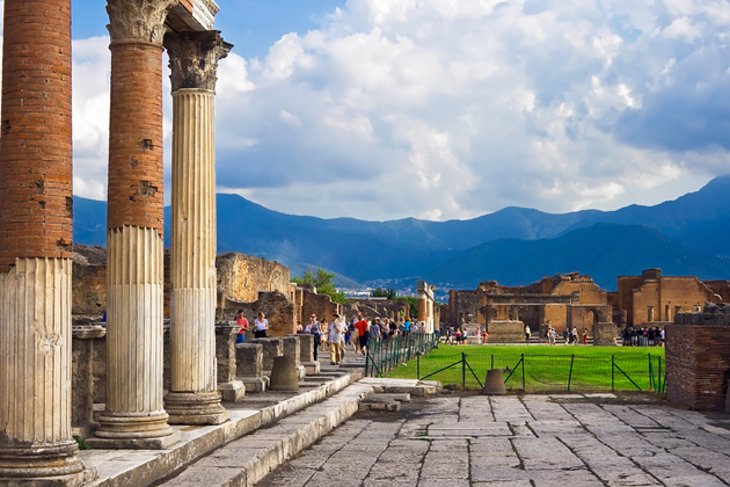
Abandoned ever since, Pompeii started to emerge when excavations began in the 18th century and since then, about three-fifths of the total area (the city walls had a perimeter of three kilometers) have been recovered. Early excavators took everything to the museum in Naples, but archaeologists since 1911 have left artifacts in place, making the more recently excavated areas the most interesting.
The work of recovering ancient Pompeii still continues, with each new find adding to our understanding of life in 79 CE. Most recent was the discovery of a room in the nearby villa of Civita Giuliana that housed a family of slaves. The room contained wooden plank beds and was also used for storage.
Expect to be surprised at how vivid an impression of ancient life you get in its homes, shops, and public places. The feeling is inescapable that when the eruption came, everyone had been in the middle of going about their normal daily business, never dreaming that their last acts would become a window into history. One of the most popular places to visit in Italy, Pompeii is easily reached from Naples or Sorrento and even as a day tour from Rome .
You can find all the best things to do here with this handy list of the top attractions in Pompeii.
Antiquarium
Temple of isis, terme stabiane (stabian baths), house of menander, nuovi scavi (new excavations), amphitheater, house of the vettii, western houses, street of tombs, villa of the mysteries, climb to the rim of mt. vesuvius.
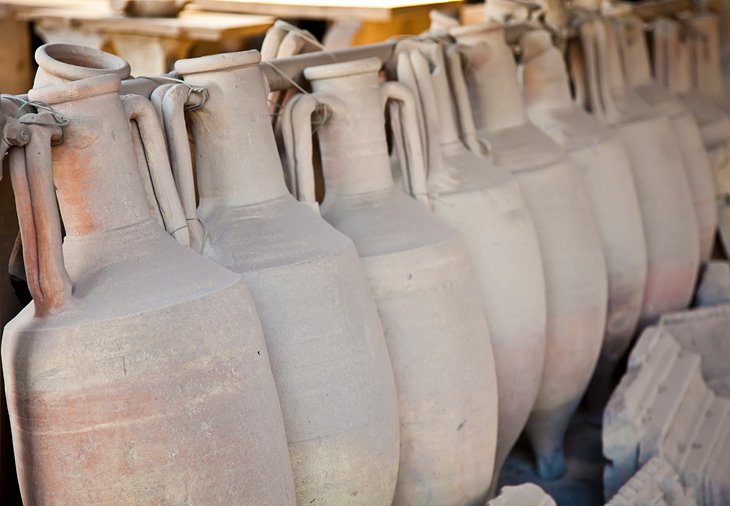
Anxious though you may be to explore this fabled city, it really is worthwhile to stop in this museum first. You'll not only find helpful interpretive displays, but you'll see many of the artifacts found during the excavations that were either too fragile or too prone to weathering to be left in place.
Some of these date to long before the Roman era. Here, you'll see the implements of everyday life - rows of amphora and other vessels, furnishings, and small household and commercial items.
Along with these are the plaster casts made from almost perfect molds left in the solidified ash by the bodies of those caught in the sudden destruction. As these spaces were found by excavators, they were carefully filled with plaster, forming images of the victims as they tried to escape. They bring those final moments into grisly reality and make Pompeii more than just a historic relic.
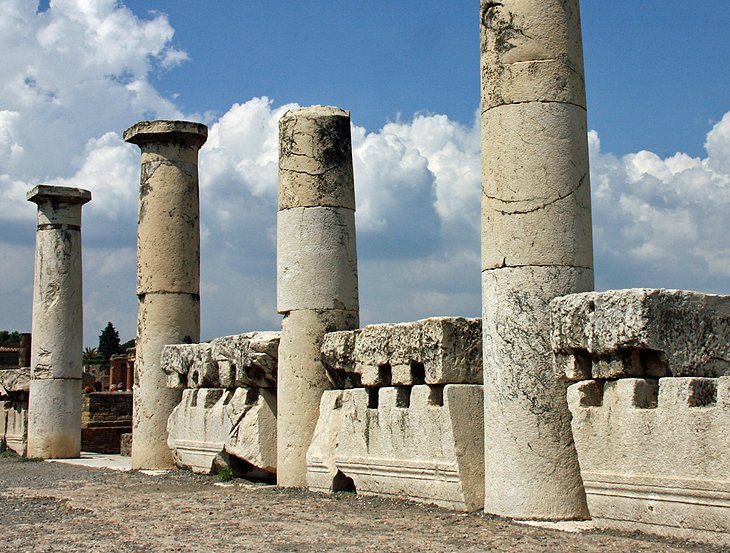
The principal square of a Roman town, the Forum is enclosed by colonnades and bounded on the north by the Temple of Jupiter , rising on a three-meter base. At the corner to its right is the Macellum, a hall for selling food. Various shrines, temples, and other buildings surround the Forum: the Shrine of the Lares; the Temple of Vespasian; a hall for selling wool; and the Curia, where the town council met.
Nearby, the basilica was used as a market and a law-court. To its left, the Temple of Apollo is surrounded by 48 Ionic columns. One of the newer homes to be opened is that of Triptolemus, in front of the basilica. Dating from the second century BCE, this was obviously owned by a prosperous and important family, as you can tell by its two atriums (courtyards) and two peristyles (columned garden courtyards).
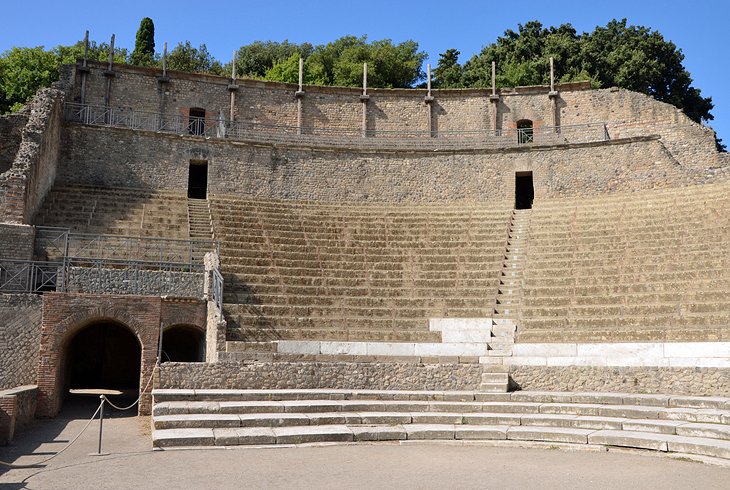
Built into the sloping ground, the Teatro Grande (Large Theater) could seat 5,000 spectators and is used for Son et lumière shows in summer. The top row commands one of the best views of the city and Vesuvius.
The theater illustrates the class divides of that time, with the wider more gently sloped tiers for the upper classes, who were also separated from the masses in the steeper, narrower levels above by a low wall.
The adjoining Teatro Piccolo (Little Theater), better preserved and the earliest example of a roofed Roman theater, dates to about 75 BCE. It would have been used mainly for musical performances.
The Large Theatre was one of the first stone theaters built by the Romans, and Pompeii had these two stone theaters before the first ones were built in the city of Rome.
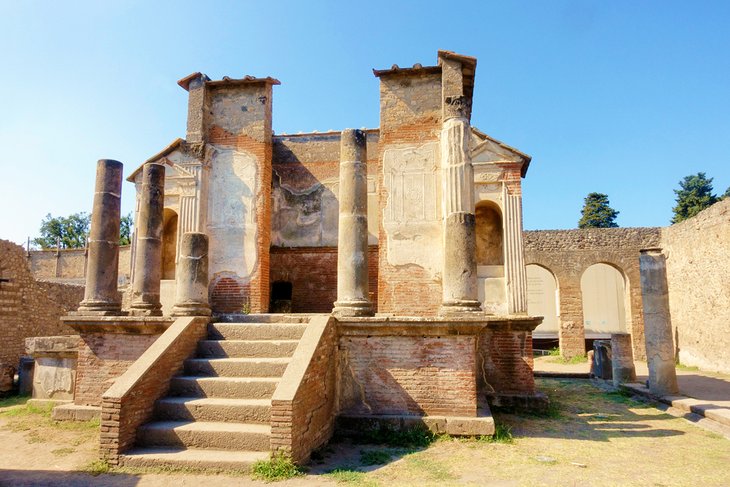
East of the Little Theater is the Tempio di Iside - Temple of Isis, dedicated to the Egyptian goddess whose cult was very popular in the Roman Empire. Although the temple was constructed in the second century BCE, it was destroyed in the earthquake of AD 62 and completely rebuilt. The temple stands on a raised base at the center of a courtyard surrounded by porticoes. You can still see an inscription scratched on its walls by the French novelist Stendhal in 1817.
Adjacent to it is the Tempio di Giove Meilichio. From here, you enter the tree-shaded Triangular Forum , intended mainly for theatergoers, through a fine arcade to get to gladiators' barracks . Inscriptions recording their successes in gladiatorial games were found on its columns.
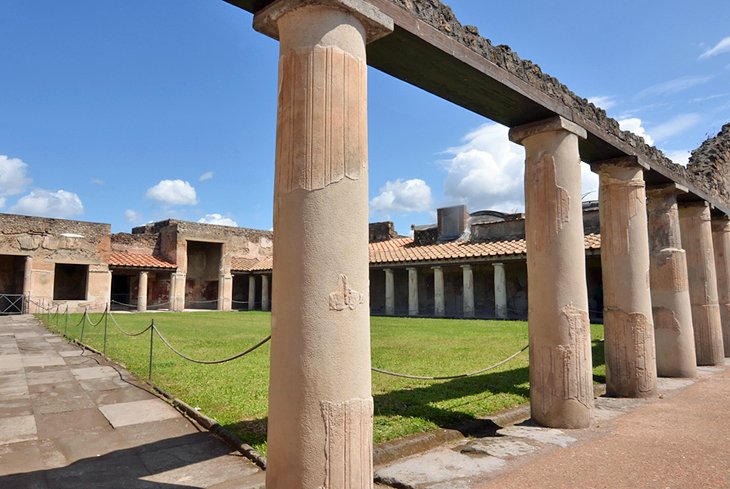
At the corner of Via dell'Abbondanza and Via Stabiana are the largest and best-preserved baths in Pompeii. The entrance leads into the colonnaded palaestra, with a swimming pool on the left; on the right are the male and female baths, separated by the stoves for heating the water.
Each facility has a circular cold bath (frigidarium), a changing room (apodyterium) with racks for clothing, a warm bath (tepidarium), and a hot bath (caldarium) heated by air-ducts in the floor and walls. Gladiators trained in the gymnasium, which was also part of the Stabian complex.
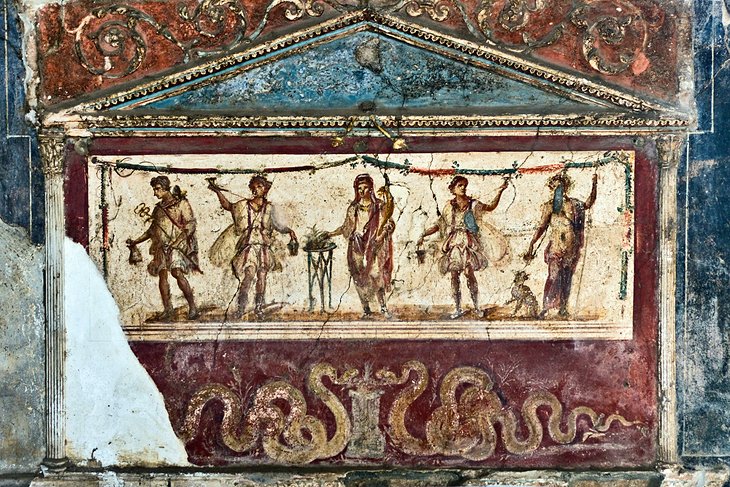
The large, well-preserved House of Menander belonged to a wealthy merchant who gave notice of his status right at the entrance, which is flanked by pillars with Corinthian capitals. The well-preserved atrium has a little temple in one corner and an intact wooden roof that extends out to the center opening, where water drained to collect in the pool below.
Interior rooms are decorated with scenes from Homer's Iliad, and the peristyle is surrounded by a beautiful painted colonnade. Adjoining this is the charming little House of the Lovers, named for an inscription that translates "lovers, like bees, wish life to be as sweet as honey."
Farther along Via dell'Abbondanza, on the left, is the Thermopolium , a tavern fully equipped with drinking vessels, a kettle, a stove, and a lamp; the last customer's money is still on the counter.
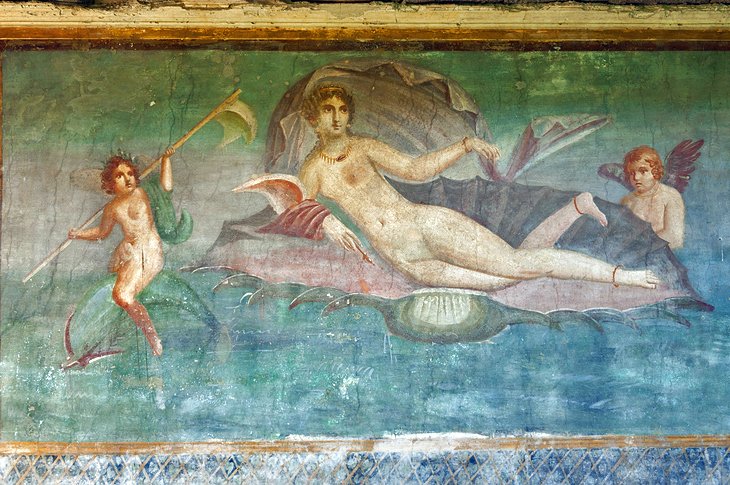
At the farther end of Via dell'Abbondanza, on the right, is the beginning of the New Excavations, where wall paintings and furniture have been left in place. In many of the houses, the upper story, with its balconies and loggias, has been preserved by girders, giving a better idea of how these looked two millennia ago.
Mosaics, statues, frescoes, and furnishings are still here, along with election posters and other casual inscriptions painted on the walls. This part of the town dates from Pompeii's final period, and most of the homes and shops belonged to tradesmen. Look for an ironmonger's shop and a fuller's and dyer's workshop (Fullonica di Stefano), with two restored pressing machines.
In the Cryptoporticus house , a magnificent painted frieze in a passage leading to the cellar illustrates scenes from the Iliad and other Homer poems. In the Casa della Venere (House of Venus) is one of the loveliest frescoes in Pompeii, showing Venus on a seashell.
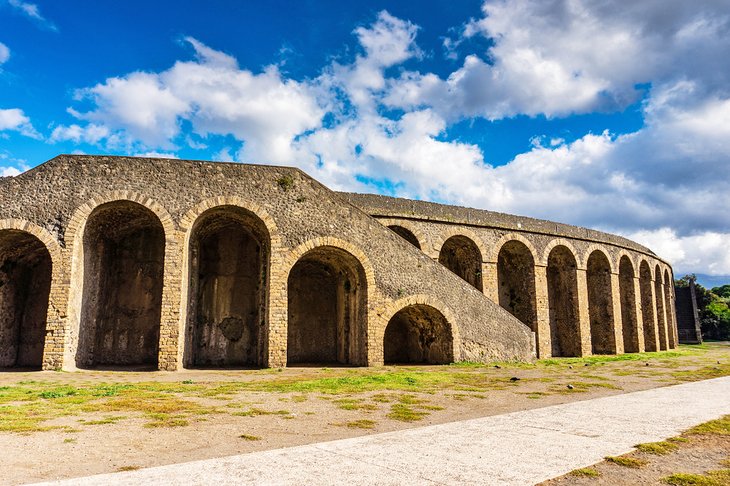
Dating from 80 BCE, the massive Amphitheater at the far end of Pompeii, which seated 12,000 spectators, is the oldest surviving Roman amphitheater and the most complete of any built before the Colosseum in Rome .
Right next to it is the Palaestra , with colonnades around three sides and a swimming pool in the center. Beyond the Porta di Nocera, outside the city walls, is a necropolis (cemetery), much like those that lay outside the walls of all Roman (and other) ancient towns.
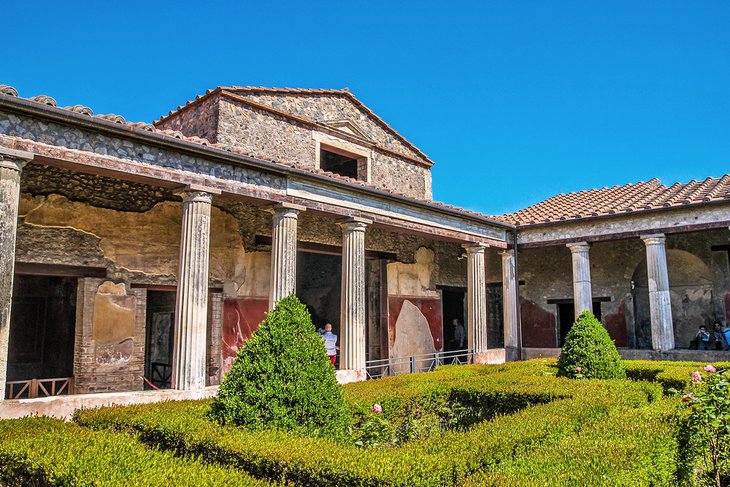
The House of the Vettii in the Vicolo di Mercurio is one of the most interesting in Pompeii. This was the home of two well-off middle-class brothers, and it shows that it was not just the aristocracy who lived well in elegantly decorated homes.
This house has some of the best frescoes, as well as a peristyle that still has its original marble decoration, and whose garden has been replanted, so you can see what it looked like when people lived here. The kitchen still contains its cooking utensils.
From their style, art historians think that the fresco painting in the interior was done after the devastating earthquake of AD 62. The most famous of the frescoes are in the triclinium, where they completely cover the walls in faux panels with mythological scenes and a long frieze of cupids. The colors are especially intense. The walls under the colonnade of the peristyle are also painted to imitate panels.
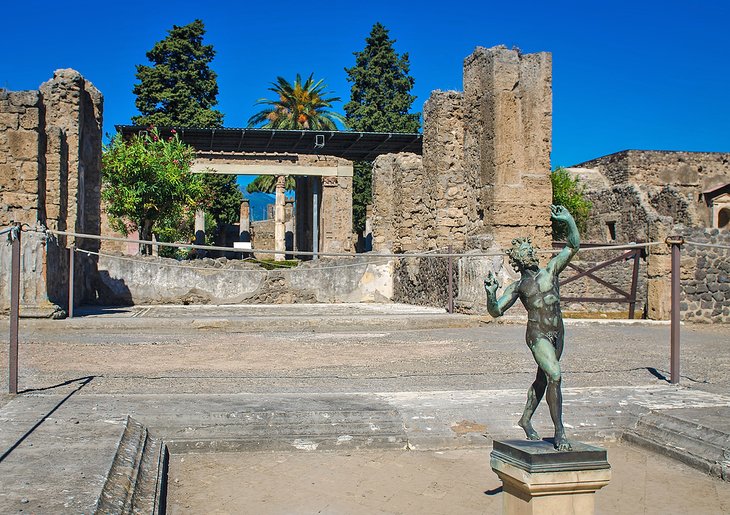
In the same neighborhood, near Porta Ercolano, are several houses worth seeing. Opposite the House of the Vettii, the House of the Faun is the most palatial mansion in Pompeii, but sadly all its art treasures - including outstanding mosaics - were carted off to the museum in Naples.
Next to the House of Siricus is a bakery on whose threshold is inscribed "Salve lucrum" (Long live profit); perhaps they spent theirs on the fine paintings inside. Farther along the Via Stabiana, on the right, the House of Marcus Lucretius has well-preserved paintings, and the House of the Silver Wedding has a fine atrium and peristyle.
The garden of the elegant House of the Gilded Cupids (Casa degli Amorini Dorati) still preserves its original marble decoration. North of the Forum Baths , smaller and more modest than the Stabian Baths, is the richly appointed House of the Tragic Poet . On its threshold, you'll find one of Pompeii's most famous mosaics, of a chained dog with the inscription "Cave canem" (Beware of the dog). On its north side is a fuller's workshop, to the left of which are two houses with beautiful fountains.
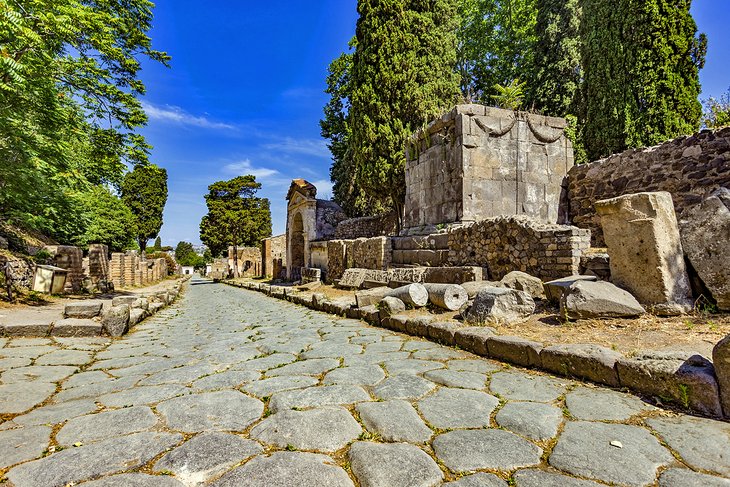
Outside the walls of Pompeii, through Porta Ercolano, is a suburban district whose main street has been excavated. This Street of Tombs is lined with imposing funeral monuments, ranking with the Via Appia outside Rome as the most impressive surviving example of this Roman practice of building tombs along public roads.
At the northwest end is the large Villa of Diomedes , with an extensive garden enclosed by a long portico. Ironically, the house itself became a tomb in the volcanic eruption: in an underground passage, excavators found the bodies of 18 women and children. Near the garden door was the body of a man with a key in his hand and a slave beside him carrying money and valuables.
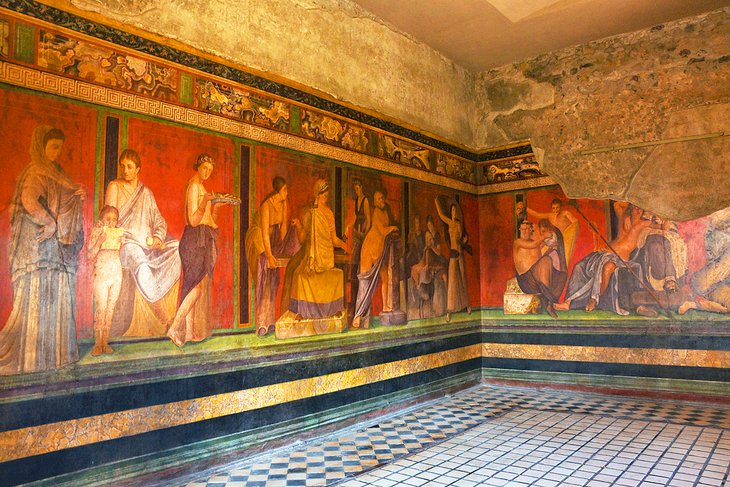
Also outside the main excavation area and beyond the Villa of Diomedes is the magnificent Villa of the Mysteries (Villa dei Misteri). Your ticket includes admission here. This villa, built in the second century BCE contains what many consider to be the finest surviving ancient wall paintings, preserved in all the brilliance of their original colors.
The most remarkable of these is a frieze 17 meters long in the large triclinium, so large that its figures are almost life-size. It is thought that the villa had been converted into a Dionysian cult meeting place, and the scenes in these paintings show followers engaged in the mysteries of initiation.
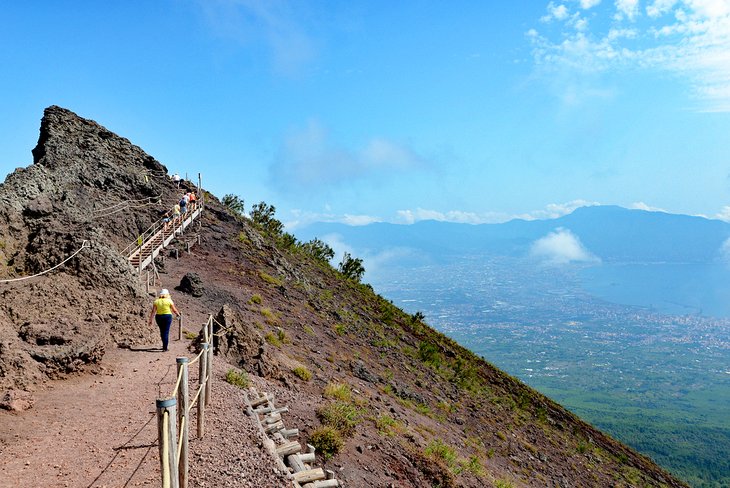
Wooden walkways and gravel paths make the crater rim of Mt. Vesuvius easy to reach, and a hike here gives you an even greater appreciation for the power of this volcano that destroyed two cities. And the views of Naples and the bay from the top are matchless.
The trail known as "Il Gran Cono" begins at 1,000 meters above sea level, and on the way to the rim, you'll cross more recent lava flows dating from the last eruption, in 1944. As you follow the trail around the rim, you'll have views down into the 300-meter-deep crater, which has been stretched into an elliptical shape by successive eruptions.
Although the volcano is currently in a quiet period, the steaming fumaroles inside the Gran Cono crater and along the slopes are constant reminders that it is still alive. Eleven walking trails, totaling 54 kilometers of walkways, allow visitors to explore the Mt. Vesuvius National Park .
If you're traveling from Sorrento or Naples by train, get off at the Villa dei Misteri station, and take one of the local EAV buses to the national park.
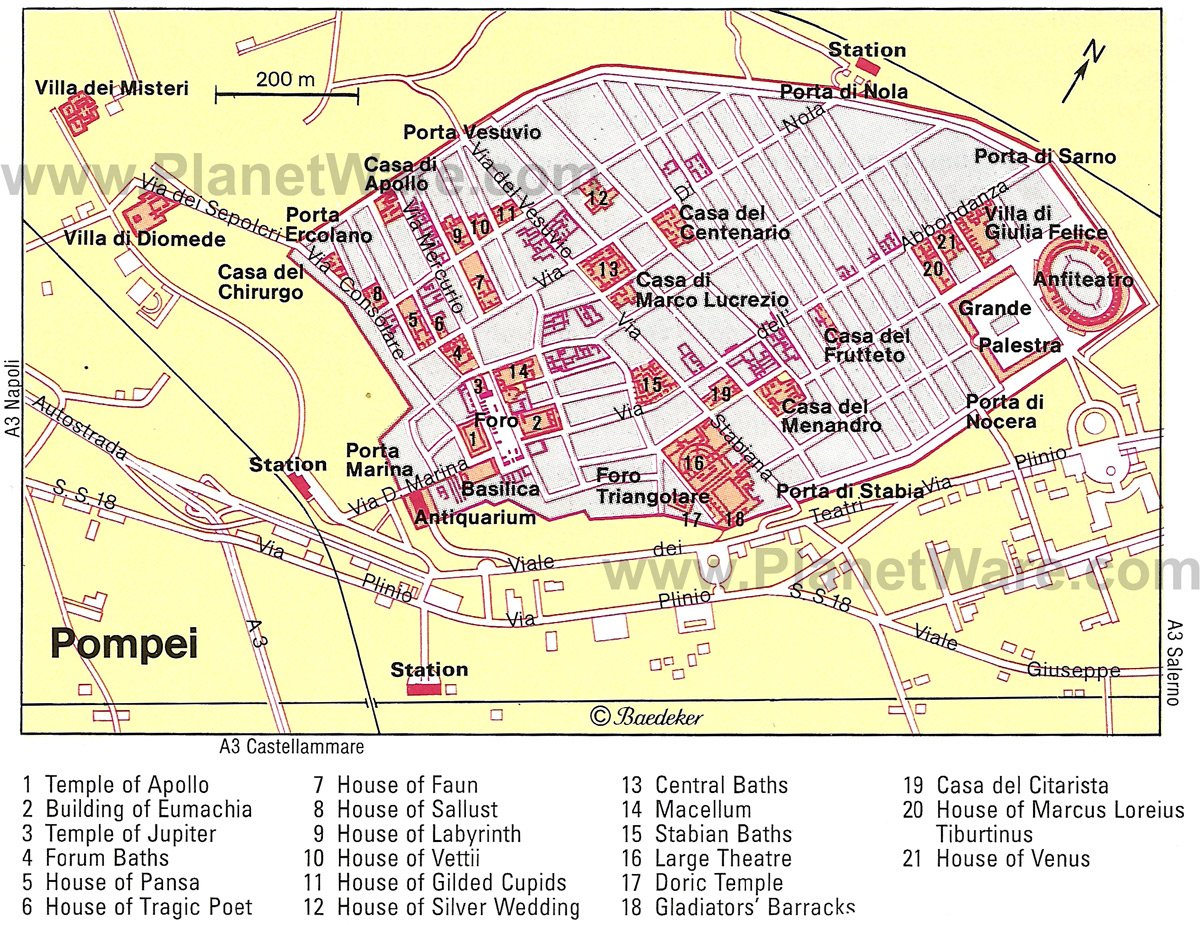
More on Italy


Welcome to Dark Tourists

Dark tourism has become ever-more popular for those looking for alternative types of travel. However, the whole idea of dark tourism can stoke criticism and controversy. Should destinations connected to some of history’s most devastating events be turned into tourist attractions?
The question is a complicated one, however, to assume that the entire notion of dark tourism is exploitative would be to miss a very important point.
For many of us, visiting such destinations brings us a little closer to comprehending the sheer horror of what took place. It is often a powerful, personal reaction where the lessons of history’s teachings become vivid and hard-hitting. And it is through this, that together we have a better chance of ensuring such atrocities do not happen again.
Here at DarkTourists.com, we provide insight into what it means to travel this way. We explore the ethics of dark tourism, and the simple do’s and don’ts when visiting places with complicated pasts. The ethos of dark tourism should always be to educate and inform.
Our aim is to highlight some of the world’s most significant dark tourism travel destinations. From assassinations and murder sites to locations of untold man-made devastation. We explore the battle relics of world wars, the remnants of corrupt regimes, and haunting places of genocide.
Latest Locations //

Spac Prison: Albania’s Dark Tourism Destination Reveals a Haunting History

Visiting Hartheim Castle Memorial Site (Austria)

Tsitsernakaberd Genocide Memorial & Museum (Yerevan)

Visiting Cellular Jail, Port Blair – All You Need to Know
What is dark tourism.

Essentially, dark tourism is the term given to a type of tourism that involves traveling to a site associated with death and tragedy.
Very often we visit these places due to their historical significance. As we mentioned above, a lot can be learned from actually visiting a location where sinister events took place.
However, there will always be those that travel through morbid curiosity and a fascination with the macabre.
There are countless locations that can be described as dark tourist sites. A browse through this website will demonstrate that.
However, places connected with history’s darkest moments come in many forms. There’s the entire abandoned city of Pripyat that can be visited in connection with the Chernobyl disaster .
Or the site of Captain Cook’s murder commemorated with a 27-foot-high obelisk in Hawaii.
Auschwitz is a carefully maintained tourist destination with exhibits and audio tours. A visit to Highgate Cemetry in London will bring you to the site of Alexander Litvinenko’s lead-lined coffin , you can do this during the opening hours of the cemetery alone.
All would fall under the umbrella of dark tourism because of the history associated with each site.
A History of Dark Tourism

Dark tourism was first coined in 1996, by Lennon and Foley ; two scholars at Glasgow Caledonian University, (they were exploring the touristic fascination with sites associated with assassinations ).
The label may be relatively new, but the idea of visiting places associated with death is very old. Consider what the Romans liked to do during their days off. ‘Tourists’ would travel for days to watch Gladiators fight each other to the death in grand battles at the Colosseum .
Public executions were considered a family day out during Victorian times . Visitors could buy refreshments and those living so close that their windows and balconies offered views of the hanging, could charge admission.
In fact, a whole industry would surround an execution. Tourists keen for a memento of the day would buy printed pictures and transcripts detailing the crimes of the condemned.
The site of Jack the Ripper’s murders became tourist spots even as he prowled the streets of Whitechapel. You can buy walking tours during a visit to London to this day.
The Catacombs beneath Paris were a desirable concert location for wealthy 19th Century Parisians. They could enjoy the refined aural pleasures of Mozart while sat beside the bones and skulls pressed into the walls.
Dark tourism is not always associated with death. Asylums during the 18th century would open their doors to the paying public as a source of extra revenue. Tourists would take walking tours around these squalid institutions to gawp at the afflicted.
And while we cannot get into the minds of ‘Dark Tourists’ from times past, it does seem apparent that an innate fascination for the macabre was an overriding factor in the popularity of it all. It was treated as entertainment.
So where does that leave us today? How do we reconcile ourselves with the ethical questions surrounding dark tourism in 2019?
The Ethics of Dark Tourism Today?

There will always be ethical concerns where the site of a tragedy has been repurposed for financial gain.
Some dark tourist sites struggle to strike a balance between education and entertainment and as a result, the horrors of the past can appear to be glorified.
Context is an important issue here. A dark tourism location needs to think carefully about how it represents its story and the artifacts that go along with it.
The best sites clearly explain their past and the events that took place. When done sensitively in a coherent manner the impact on the visitor will be a poignant one; they will appreciate the fact that the site was a place where great suffering took place.
If on the other hand, a site presents an almost random collection of macabre artifacts, with little in the way of a meaningful narrative, the result is often a much more ethically ambiguous experience.
Without context, the dark tourism site is unlikely to educate or inform and will become just a vehicle of dark glorification of the location and whatever is on display.
All of this aside, the ethical questions surrounding dark tourism will continue to remain subjective. There will be some that see the notion as a particularly sinister form of entertainment that should be left well alone, (and others that will visit sites for exactly the same reason).
And then there are those much like the writers of this website. We see dark tourism and its relevant travel destinations as a chance to learn; to come face to face with the horrors of our collective pasts and to pay our respects to those that suffered.
Dark Tourism – The Scholarly Perspective

The nature of dark tourism and its increasing popularity has gained the interest of scholars in recent years.
In fact, there is an entire institute dedicated to Dark Tourism, based at the University of Central Lancashire, England,
Aptly named the Institute for Dark Tourism Research (iDTR); it has become known as one of the world’s leading academic centers for dark tourism scholarship, research, and teaching.
The importance of the institute in the development of ethical dark tourism cannot be understated. (In academic literature, Dark tourism is also referred to as ‘ thanatourism ’ from the Greek word thanatos, meaning death, or grief).
With its continuing work as a center of research and consultation for the appropriate management, interpretation, and promotion of dark tourism sites and attractions, the iDTR has created an internationally recognized body of work that helps to understand dark tourism from an ethical and social scientific perspective.
Head here , for a list of recent interviews with the executive director of iDTR, Dr. Philip Stone .
The scholarly interest in dark tourism doesn’t stop there of course. There are myriad research papers written from all manner of intellectual perspectives; tourism management, social-historical and cultural, to name but a few.
And then there is general commentary within academic literature that takes a somewhat more critical look at thanatourism .
All of the above has its place in furthering our understanding of why it is important to recognize the growing popularity of dark tourism, and how it can be done in an ethically minded manner.
The Dark Tourism Spectrum

Dark tourism locations cross a range of “darkness”. What I mean by this is that the level of tragedy associated with different places and the context in which it is represented does vary.
You could think of this range as the dark tourism spectrum.
To place this in a practical context; a visit to the London Dungeons (which could be considered a dark tourist activity), where actors are involved with the tour and children are allowed, is very different to a trip to Auschwitz.
They are on opposite ends of the dark tourism spectrum. The chart below demonstrates the concept further.

They normally involve visiting a location where the tragedy took place. Visitors are educated about the attached history and should be mindfully respectful throughout.
The killing fields in Cambodia, Chernobyl in Ukraine, and the Gulag Museum in Siberia would all fall into this end of the spectrum.
On the lightest end, history is presented in a more commercial manner. Visitors can still be educated during this type of dark activity, however, they are also expected to be entertained.
A London Jack the Ripper tour or a visit to an Irish castle that is supposed to be haunted would fall into this category.
Ultimately, a “light” dark tourism activity is designed for the visitor to have fun as well as to learn.
Types of Dark Tourism

Understanding the dark tourism spectrum also helps highlight the fact that there is a range of dark tourist activities available.
Let’s take a look at some of them now.
Conflict Sites & Battle Grounds
Sites that have witnessed conflict in terms of civil or all-out war often become dark tourism destinations once peace has been restored, and a suitable amount of time has been passed.
You only need to look at the popularity of the battlefields of the 1st and 2nd World War in France , or the Cu Chi Tunnels in Vietnam to understand what I mean by this.
A somewhat amoral type of dark tourism exists where people visit areas that are still experiencing conflict. The Syrian-Israeli border is a good example.
From a safe distance, high above a valley in the Israeli-occupied Golan Heights , tourists can look down and witness the devastation of the war, as well as watch some of the bloodlettings take place in real-time.
Museums and Exhibitions
There are countless dark exhibitions throughout the world. The pages of this website are full of them. Within Europe and Central and South America, you have a wide choice of museums that focus on the tyranny of communism.
There has been no shortage of despots in the East either. Whatever the regime, there will be a dark tourism activity somewhere that will help you learn more.
There are also museums dedicated to the nature of death , torture, and the plague, to name but a few.
Castles and Dungeons
Visiting old castles and dungeons is a great dark tourism activity. Many are now open to the public and by their very nature, they have a dark and bloody past.
The way the history of these locations is represented varies widely, (from the Disneyfied nature of a London Dungeon tour to the authentic no-frills visit to Leap Castle in Ireland ), however, they do make for an interesting trip.
For those that like a supernatural undercurrent to their dark tourist experience, many castles cater to this too. There are very few locations that do not have a good ghost story attached to them.
Cemeteries, Tombs & Catacombs
Cemeteries as a dark tourism activity are becoming more and more popular. Even a moderate fan of The Doors wouldn’t pass on a visit to the Père Lachaise Cemetery while in Paris, to see Jim Morrison’s grave.
Checking out the final resting places of the famous (or infamous) fascinates many people.
Beyond individual gravesites, you have the bleak but often ostentatious beauty of a large cemetery with grand tombs. This becomes a draw for many. The Recoleta Cemetery in Argentina and the Victorian splendor of Highgate in London falls into this category.
Finally, there are catacombs and ossuaries throughout the world. These are crammed with skulls and when open to the public, prove extremely popular.
Disasters Sites
Disaster sites are increasingly becoming more accessible to the dark tourist. Chernobyl is probably the best example of this. The popularity of the recent HBO series has seen tourists flock to the site of the nuclear disaster that took place in 1986.
Hiroshima, Fukushima, Pompei, and Ground Zero are all disaster sites that see thousands, if not millions of visitors each year. Many of them do not even realize they are having a dark tourism experience while they are there.
Areas of Genocide
Auschwitz, the Killing Fields, and the Rwanda Memorial are all popular tourist locations. They are also areas of genocide.
The history of these places is beyond tragic, but it is important that we learn what happened, in order to prevent such atrocities from happening again.
Therefore, it is also important that these areas of remembrance exist. It is a solemn experience to visit them, but also a necessary one.
Dark Tourism as an Umbrella Term

It is also helpful to see Dark Tourism as an umbrella term for different types of tourist experiences that venture into macabre areas.
The following are all seen as tourism classifications in their own right.
- Holocaust tourism
- Disaster tourism
- Grave tourism
- Cold war tourism
- Military Tourism
- Nuclear tourism
- Prison and persecution site tourism
7 Most Visited Dark Tourist Sites Around the World

There are many dark tourism destinations around the world. As I have already stated, the best of them allow the visitor to explore, commemorate, and understand the tragedies that took place, in a sensitive and enlightening manner.
Under these circumstances, it is no small wonder dark tourism spots are becoming increasingly popular. The following 7 destinations are some of the most visited Dark Tourism spots in the world.
1. Auschwitz-Birkenau Memorial and Museum

Location: Near Krakow, Poland
Auschwitz hardly needs an introduction. As the largest German Nazi concentration camp of WW2, it is also by far the most infamous.
As the most efficient extermination center ever devised, Auschwitz has become a global symbol of terror and genocide. More than 1.1million men, women, and children lost their lives at the camp.
Over 2 million people visited Auschwitz-Birkenau in 2019, a figure so high that one can’t help feeling optimistic. Essentially, the memorial and museum is a vital tool for education. By making people aware of the true horrors that took place there, it aims to prevent such atrocities from happening again.
As the museum explains:
“There is no way to understand postwar Europe and the world without an in-depth confrontation between our idea of mankind and the remains of Auschwitz.”
Details: Admission to the grounds of the Auschwitz-Birkenau Memorial is free. However, you should still reserve a ticket as demand is so high, and there is a limited amount of visitors allowed each day.
The site is open daily from 7.30 am all year round, (excluding Easter Sunday, Christmas Day, and New Year’s Day). Not suitable for children younger than 14.
2. Chernobyl

Location: Pripyat, Ukraine
Chernobyl (and the neighboring town of Pripyat) has seen a massive surge in visitors since the release of the popular HBO television series.
It has been a mecca for dark tourists for many years, (I first visited in 2007 and tours have been available long before that), the abandoned buildings within the exclusion zone providing amazing photo opportunities at every turn.
The ghost town that is Pripyat came about because of the world’s worst nuclear accident. On April 25-26th 1986, Chernobyl nuclear reactor 4 malfunctioned during a (not so routine) safety check.
The resulting explosion spewed radioactive debris into the air that quickly spread across Europe. Pripyat, a town built to accommodate the reactor staff and their families, had to be evacuated. No one has been allowed to live there ever since.
Scientists estimate it will take up to 20,000 years before the exclusion zone can safely be habitable again.
That hasn’t stopped a burgeoning tourist industry from taking off mind you. There are countless organized tours of the town available, with tens of thousands of people visiting the site every year.
Details: Chernobyl tours are open year-round with one-day and multi-day trips available. You can also opt for larger group tours or organize a private guide (the latter is definitely recommended).
Rules are strict to keep you safe from radiation poisoning, so do as your guide instructs. The rapid beeping of the Geiger counter will definitely raise your heart rate.
3. National 9/11 Memorial and Museum

Location: New York, USA
More than 10 million people have visited the 9/11 memorial museum since it opened.
This moving tribute of remembrance and honor to the 2,977 people killed during the September 11 terror attacks in 2001, has become a must-see location for any visitor in New York.
Twin reflecting pools have been built in the foundations of where the Twin Towers once stood. Etched into bronze panels along the edges of each pool are the names of every single victim.
It is a poignant, emotionally loaded spot. Despite being in the middle of the business district of Manhatten, there is an air of somber calm here as visitors walk around the pools, inwardly paying their respects.
The museum is packed with information on the building and life of the Twin Towers, as well, of course, the tragedy of its destruction.
Details: The 9/11 Memorial is free every day from 7.30 am to 9 pm. Museum tickets can be bought online (up to 6 months in advance) as well as at the entrance.
4. Murambi Genocide Memorial

Location: Near Murambi, Southern Rwanda
Of all the global memorials dedicated to victims of mass murder and genocide, Murambi’s is arguably the most hard-hitting.
This is not so much due to the events that took place, (which were clearly horrific), it is the presence of the corpses of over 800 victims that have been exhumed from the local killing fields.
Preserved in lime their bodies did not fully decompose. They now form part of the memorial and have been out on display.
They are the victims of a brutal killing spree conducted by Interahamwe militia and soldiers in 1994. This, along with many other massacres during the Rwanda civil war, was in support of the genocide endorsed by the government.
It is estimated that between 500,000 to 1,000,000 Rwandans were killed, with approximately 70% of the country’s Tutsi population (men, women, and children) murdered.
The memorial is positioned on a picturesque hill with bucolic countryside reaching out in all directions.
Details: The memorial is open daily from 8 am to 5 pm. (except on Umuganda Saturdays). Entrance is free and includes an accompanying audio guide.
5. The Ruins of Pompeii

Location: Pompeii, Italy
Mount Vesuvius’s volcanic eruption wiped out the Roman city of Pompeii in 79AD.
Almost two millennia later, the site is a very popular (dark) tourist destination with over 2.5 million making the trip every year.
The devastation of the eruption and the resulting preservation of bodies from the ash, make this an extraordinary place to visit.
The whole site is a monument to the final minutes of Pompeii as the eruption spread through the city.
Details: Pompeii is open daily from 9 am, (except for New Year’s Day, May 1st and Christmas Day). Tickets can be purchased in advance online or at the entrance on the day you visit.
The standard entrance fee is €18.90. However, prices for EU citizens aged 18-24 is €6, Children cost only €3.
6. The Killing Fields of Choeung Ek

Location: Phnom Penh, Cambodia
Pol Pot and his Khmer Rouge regime are responsible for the genocide that took place in Cambodia between 1975 and 1979.
Turning on their own people, the regime rounded up and murdered approximately 1.5 million people during Pol Pot’s radical push towards Communism.
To fulfill its goals of achieving a socialist agrarian republic, the Khmer Rouge emptied the cities and forced Cambodians to relocate to labor camps in the countryside.
Here forced labor and mass executions were rampant. A former school was transformed into the infamous Security Prison 21 (it is now Tuol Sleng Museum). Here, 20,000 people were sent for questioning. Only seven adults survived.
10 miles southwest of Phnom Penh were the Killing Fields where prisoners were taken to be executed. In order to save bullets, pickaxes were often used. The bodies were then dumped in mass graves close by.
In 1980 the remains of 8,895 people were exhumed from the site. The skulls are now on display inside the memorial based at the Killing Fields. Many of them show evidence of the brutal manner in which the victim died.
Details: The killing Fields are open daily from 7.30 am to 5.30 pm. The entrance fee is $6 including an audio tour.
7. Hiroshima Peace Memorial Museum

Location: Hiroshima, Japan
On August 6th, 1945 an atomic bomb detonated above the city of Hiroshima. It helped bring an end to WW2, but the cost to life was horrific.
Innocent men, women, and children were murdered in the blast. It was a moment that would change the course of history, and shape the world towards a battle for nuclear armament that exists to this day.
The Hiroshima Peace Memorial Museum houses permanent exhibitions that include artifacts from the explosion, items belonging to victims, and testimonials from those who managed to survived.
Details: Open daily (excluding 30 and 31st of December). The entrance fee is 200 yen.
The Do’s and Don’ts of Dark Tourism

So how should one act when visiting a dark tourist site? Number one answer to that is “respectfully”. And that certainly means you should not pose for a selfie with a shit-eating grin plastered across your face.
(The officials at Auschwitz have faced this issue recently with the growing number of tourists taking smiling, social-media snaps while standing on the infamous train-tracks).
Following the advice below will help you act appropriately while visiting and learning about the world’s darkest history.
What not to do when visiting a Dark Tourist site

We’ll start with the don’ts as some of these irk me greatly. Unfortunately, I think I have seen an example of at least one of the following every time I have ever visited a dark tourist location, (unless I have managed to do a private tour).

Take Selfies
I’ll start with the big one; taking selfies or snaps of your grinning friends and family. It is far from respectful. If your number one reason for being at the site is to show off the fact you have been there to your Instagram following, well then you have totally missed the point.
In fact, I don’t want to talk to you anymore, go find another website.
Making Jokes (Even under your breath)
Dark tourist sites have to be taken seriously. Not only should you be respectful to the memory of what happened (and the people it happened too), you should also be conscientious of the people that are visiting the site.
Joking and general larking about is unacceptable. Even chuckling quietly in your small group can potentially upset others around you. You have no idea of the circumstances that bring them there.
Taking a “small” memento
It is also unacceptable to take a memento from the dark tourist site. While it may seem harmless enough to take a stone, a flower or some other small item from the location, it is still fundamentally wrong.
Just imagine if every visitor felt the same way and took a little piece home with them. These locations need to be treated with respect and left intact.
Litter or graffiti
Leaving your trash around and not clearing up after yourself, or etching your initials into the underside of a bench just to make your mark at a famous location is moronic.
I realize I am starting to sound a little preachy in this section, however, it is because I have seen such behavior all too often and it is one of the many reasons “dark tourists” end up getting a bad wrap.
Leaving your shit behind just reeks of disrespect and demonstrates that you simply do not care.
What you should do when visiting a Dark Tourist Site

Now that we’ve got that bad stuff out of the way, let’s take a look at some of the things you can do to be a contentious dark tourist.
Learn as much as you can about the history of the location
Take some time to read up on the location before, during and after you are there. Learning some of the history before you go will generally make for a more interesting visit as the information you will have already learned will become ever-more poignant by being there.
That being said, some people prefer to go in blind. And that is absolutely fine. However, a good dark tourist location will have lots of explanatory material (written and audio guides etc) where information can be gleaned as you make your way around the site.
Often time, I leave a location and become an avid reader on the site afterward. For me personally, the history is significantly more powerful after I have made the trip and experienced the dark tourist location for myself.
Join a guided tour or utilize an audio tour
This is a continuation of the above point and is all about learning as much as you can. If reading plaques as you walk around a site isn’t your thing, see if the site offers guided tours.
Today’s technology also means audio tours are available on some of the smallest and most remote locations.
Even if it means you need to pay extra, the money will often be going towards running the site so it is for a good cause.
Act respectfully as you walk around
This basically means don’t do any of the points we listed in the “What not to do” section. No jokes, selfies, or removing items from the location. Be aware of your surroundings and others that are visiting.
Whether the sad or tragic event that happened at the location is from the distant past or the loss is more recent, you should act in a manner that shows respect to the physical location and the memories of those that may have suffered there.
Tell others about your experience
If you found a dark tourist site interesting and/or moving, tell others about it once you return home. This is important type of tourism and we must work together to remove some of the stigma associated with it. There is a lot to be gained from people visiting these locations and learning more about the history associated with them.
Privacy Overview
Privacy Policy - Contact - Terms and Conditions
Academia.edu no longer supports Internet Explorer.
To browse Academia.edu and the wider internet faster and more securely, please take a few seconds to upgrade your browser .
Enter the email address you signed up with and we'll email you a reset link.
- We're Hiring!
- Help Center

Pompeii as a Dark Tourism Site: The Frozen City

2022, Pompeii as a Dark Tourism Site: The Frozen City
Dark heritage concept becomes more popular during the last years than before especially in the field of heritage studies. This widespread encouraged what is known as dark tourism. As it is going to be discussed in this paper, the dark heritage or tourism concept include any destruction, catastrophe, and death cases. Travelling for the purpose of seeing dead or death sites become very popular and carry a special type of interest. As seen in our presented case study, Pompeii is an attractive destroyed city which catches the attention of thousands of visitors who eager to travel to see the life in this site as it was. The site of Pompeii is a unique site in its components and catastrophic and sudden destroy by the eruption of Mount Vesuvius in 79 A. D. This in turn makes this site very remarkable and important dark heritage tourism site along with its importance to the scholars due to its richness that reflected the lifestyle of the ancient Romans. Among the aims of this study is to discuss the concept of dark heritage and tourism and its importance to the recent tourism programs and heritage studies shedding the light on the site of Pompeii as very successful and important model for dark tourism in Italy.
Related Papers
Geoheritage
Edyta Pijet-Migoń
Proceedings of the Proceedings of the 1st Padjadjaran Communication Conference Series, PCCS 2019, 9 October 2019, Bandung, West Java, Indonesia
Herlina Agustin
Neveen H Badr
Englishes, 50, pp. 21-47
Marxiano Melotti
Journal of Tourism Research & Hospitality
Claudia Seabra
Englishes, 52, pp. 47-76
The increasing attention in tourism to the sensory and emotional aspects reflects the profound cultural transformations of postmodernity, especially in the societies most influenced by the Western patterns of consumption. This attention involves a new hybrid and relative concept of authenticity, more oriented to emotions and experiences than to contents and material aspects. This change entails effects that appear to be particularly significant in cultural tourism and, particularly, in archaeological tourism: tactile and sensory museums, light and olfactory installations, practices of living history and experiential archaeology. These and other activities of consumption and leisure, aimed at recovering a supposed historical and territorial authenticity and characterized by forms of historical theming, are profoundly transforming our relationship with heritage and the past. Also the spreading of festivals of living history is tied to this new tourism mostly based on emotions. These innovative processes of construction of individual and collective identity entail complex interaction between re-enactors, tourists and local community; strategies of tourist and territorial marketing; and a new use of heritage. At the same time, however, we can single out some salient features of the change in course: consolidation of forms of leisure, tourism and cultural fruition intertwining education and entertainment; increasing loss of historical knowledge; growing need of territorial and historical authenticity; larger acceptance of new forms of relative authenticity.
syahrul syaarawy
International Journal of Heritage and Museum Studies
Shaimaa Nagib
Journal of Association of Arab Universities for Tourism and Hospitality
Manal B . Hammad
RELATED PAPERS
Sustainability
Miriam Petracca
Miscellanea Geographica - Regional Studies on Development
Maciej Lechowicz
EDITURA ASE
Adrian Solomon
Helwan university
Hosam Refai , Shaimaa Nagib
greg richards
Ana Pereira Roders
Kaleigh Lewis
Asian Journal of Tourism Research
I Wayan Suyadnya
Geosciences
Journal of Public Archeology
Aldo Di Russo
Tourism and …
Transactions on Maritime Science
Neven Šerić
Maximiliano E. Korstanje , Bintang Handayani , Stanislav Ivanov
Carrie L. Sulosky Weaver
Jordan Bear
MSA University Graduation Projects
Marwan S . Abdelwahab
Kenneth M Mick-Evans
Sueldes Araujo
Laura Dryjanska
ATLAS Cultural Tourism Bibliography
E.C. del Re and R.R. Laremont, eds., Pursuing stability and a shared development in Euro-Mediterranean migrations, Aracne, Roma, 2017, pp. 323-371
Montse Crespi Vallbona , Melinda Jászberényi
Dr. Teresa "Lilly" White
Maximiliano E. Korstanje
Teaching History
Craig Barker
Ulka Chandini Pendit
Journal of Tourism and Hospitality Education
Neeru Karki
Heather Skinner , Cristina Fona , Ambelonas Corfu
uysal yenipınar
Geological Society, London, Special Publications
Thomas Hose
Heather Skinner , Nikolaos Kaloudis , Aggelos Panayiotopoulos , Maria Lichrou , Renaud Vuignier , Audrey Gilmore , Timothy Jung , Julia Fallon , Eli Avraham , Amos S. Ron , Laura Reynolds , Alex Christou , Evangelia Parisi
International Journal of Heritage Studies
Dorina Maria Buda , Annaclaudia Martini
Jo De Waele
International Journal of Heritage, Tourism and Hospitality
Dalia Amara
Tania Doxanaki
Sustainable Development
Ana M Capelo
RELATED TOPICS
- We're Hiring!
- Help Center
- Find new research papers in:
- Health Sciences
- Earth Sciences
- Cognitive Science
- Mathematics
- Computer Science
- Academia ©2024
- Account and Profile
- Newsletters & Alerts
- Gift Subscriptions
- Home Page U.S. & World | Regional
- White House
- Courts and Law
- Monkey Cage
- Fact Checker
- Post Politics Blog
- The Post's View
- Toles Cartoons
- Telnaes Animations
- Local Opinions
- Global Opinions
- Letters to the Editor
- All Opinions Are Local
- Erik Wemple
- The Plum Line
- PostPartisan
- DemocracyPost
- The WorldPost
- High School Sports
- College Sports
- College Basketball
- College Football
- D.C. Sports Bog
- Fancy Stats
- Fantasy Sports
- Public Safety
- Transportation
- Acts of Faith
- Health and Science
- National Security
- Investigations
- Morning Mix
- Post Nation
- The Americas
- Asia and Pacific
- Middle East
- On Leadership
- Personal Finance
- Energy and Environment
- On Small Business
- Capital Business
- Innovations
- Arts and Entertainment
- Carolyn Hax
- Voraciously
- Home and Garden
- Inspired Life
- On Parenting
- Reliable Source
- The Intersect
- Comic Riffs
- Going Out Guide
- Puzzles and Games
- Theater and Dance
- Restaurants
- Bars & Clubs
- Made by History
- PostEverything
- Entertainment
- Popular Video
- Can He Do That?
- Capital Weather Gang
- Constitutional
- The Daily 202's Big Idea
- Letters From War
- Presidential
- Washington Post Live
- Where We Live
- Recently Sold Homes
- Classifieds
- WP BrandStudio
- washingtonpost.com
- 1996-2018 The Washington Post
- Policies and Standards
- Terms of Service
- Privacy Policy
- Submissions and Discussion Policy
- RSS Terms of Service

Dark tourism, explained
Why visitors flock to sites of tragedy.

Every year, millions of tourists around the world venture to some of the unhappiest places on Earth: sites of atrocities, accidents, natural disasters or infamous death. From Auschwitz to Chernobyl, Gettysburg, the site of the Kennedy assassination and the 9/11 Memorial in New York, visitors are making the worst parts of history a piece of their vacation, if not the entire point.
Experts call the phenomenon dark tourism, and they say it has a long tradition. Dark tourism refers to visiting places where some of the darkest events of human history have unfolded. That can include genocide, assassination, incarceration, ethnic cleansing, war or disaster — either natural or accidental. Some might associate the idea with ghost stories and scares, but those who study the practice say it’s unrelated to fear or supernatural elements.
“It’s not a new phenomenon,” says J. John Lennon, a professor of tourism at Glasgow Caledonian University, in Scotland, who coined the term with a colleague in 1996. “There’s evidence that dark tourism goes back to the Battle of Waterloo where people watched from their carriages the battle taking place.”

The hit US drama "Chernobyl" brought a new generation of tourists to the nuclear disaster zone. (Genya Savilov/AFP via Getty Images)
That was in 1815, but he cites an even longer-ago example: crowds gathering to watch public hangings in London in the 16th century. Those are relatively modern compared with the bloody spectacles that unfolded in the Colosseum in Rome.
There aren’t official statistics on how many people participate in dark tourism every year or whether that number is on the rise. An online travel guide run by an enthusiast, Dark-Tourism.com , includes almost 900 places in 112 countries.
But there’s no question the phenomenon is becoming more visible, in part thanks to the Netflix series “Dark Tourist” that was released last year. And popular culture is fueling more visitation to some well-known sites: After the HBO miniseries “Chernobyl,” about the 1986 power plant explosion, came out this spring, travel companies that bring people to the area said they saw a visitor increase of 30 to 40 percent. Ukraine’s government has since declared its intention to make the Chernobyl Exclusion Zone an official tourist spot, despite lingering radiation.
[How to navigate the etiquette of dark tourism]
Philip Stone, executive director of the Institute for Dark Tourism Research at the University of Central Lancashire, in England, says anecdotally that he sees the appetite for such destinations growing.
“I think, for political reasons or cultural reasons, we are turning to the visitor economy to remember aspects of death and dying, disaster,” he says. “There is a kind of memorial mania going on. You could call that growth in dark tourism.”

(Illustrations by Laura Perez for The Washington Post)
Why are tourists so enamored with places that are, as Lennon puts it, “synonymous with the darkest periods of human history?” Academics who study the practice say it’s human nature.
[Ukraine wants Chernobyl to be a tourist trap. But scientists warn: Don’t kick up dust.]
“We’ve just got this cultural fascination with the darker side of history; most history is dark,” Stone says. “I think when we go to these places, we see not strangers, but often we see ourselves and perhaps what we might do in those circumstances.”
“When we go to these places, we see not strangers, but often we see ourselves and perhaps what we might do in those circumstances.”
Philip Stone, executive director, Institute for Dark Tourism Research at the University of Central Lancashire
There is no one type of traveler who engages in dark tourism: It could be a history buff who takes the family on a road trip to Civil War battlefields, a backpacker who treks to the Colosseum in Rome, or a tourist who seeks out the near-abandoned areas near the Fukushima Daiichi Nuclear Power Plant disaster, in 2011, in Japan.

Visitors walk between barbed wire fences at the Auschwitz I memorial concentration camp site in Oswiecim, Poland. (Sean Gallup/Getty Images)
Those who are most familiar with the phenomenon do not condemn it. In fact, they argue that the most meaningful dark-tourism sites can help visitors understand the present and be more thoughtful about the future.
“These are important sites that tell us a lot about what it is to be human,” says Lennon, the tourism professor. “I think they’re important places for us to reflect on and try to better understand the evil that we’re capable of.”
There are even efforts underway to research the way children experience dark tourism, a joint project between the Institute for Dark Tourism Research and the University of Pittsburgh.
Mary Margaret Kerr, a professor of education and psychiatry at the University of Pittsburgh, says the idea came about when the National Park Service asked her to help create a team to design children’s materials for families who visit the memorial to United Airlines Flight 93, which was hijacked on Sept. 11, 2001, and crashed in a field in Pennsylvania.
Her research team now includes middle-school students who have studied how their peers interact with the National 9/11 Pentagon Memorial, in Washington, or the site of the Johnstown flood, in Pennsylvania, which killed more than 2,200 in 1889.

(Illustration by Laura Perez for The Washington Post)
“We wouldn’t want families to stop traveling, and adults want to see these places for very good reasons,” Kerr says. “It’s not so much making the decision for parents whether you take the children or not, but what are the appropriate safeguards."
She said the goal is to provide appropriate safeguards and ways to experience a site, even for children too young to grasp the history, “so the family can be there together, but each member of the family can take meaning that works out for them at their age and stage.”
As more sites with dark histories become popular spots — even part of organized tour packages — experts say there is a risk that they could become exploited, used to sell tchotchkes or placed as backdrops for unseemly photos.
“It does kind of invite that passive behavior — let’s call it that touristy behavior — that might be out of place,” Stone says.

Visitors look at the bodies of eruption victims exposed in the ruins of ancient Pompeii. (Mario Laporta/AFP via Getty Images)
Bad conduct by tourists at sensitive sites — smiling selfies at concentration camps, for example — has been widely shunned on social media. The online Dark-Tourism.com travel guide cautions against such behavior, as well as the ethically questionable “voyeurism” of visiting an ongoing or very recent tragedy to gape.
“These are important sites that tell us a lot about what it is to be human. I think they’re important places for us to reflect on and try to better understand the evil that we’re capable of.”
J. John Lennon, tourism professor at Glasgow Caledonian University
“What IS endorsed here is respectful and enlightened touristic engagement with contemporary history, and its dark sites/sides, in a sober, educational and non-sensationalist manner,” the site says .
Lennon says he’s sometimes “dumbfounded” by some of the behavior that gets publicized, but he declines to say what the right or wrong way is for tourists to behave. Overall, he says, he still hopes that by visiting places with dark histories, people are becoming better informed about atrocities like racial and ethnic cleansing.
“I’m heartened by the fact that they choose to try to understand this difficult past,” Lennon says.
Berlin’s Holocaust memorial is ‘not a place for fun selfies’
Will gun violence lead to a growing ‘dark tourism’ industry?
A selfie ban in the Czech Republic is the latest effort to combat bad tourist behavior
Hannah Sampson
Hannah Sampson is a staff writer at The Washington Post for By The Way, where she reports on travel news.
More stories
Airline helpfully tweets advice on where on a plane you are least likely to die in a crash
Fatality rates are usually not what customers want to hear about, but one carrier's regional Twitter account went there anyway.

Can tourism ‘pledges’ help keep visitors on their best behavior?
Destinations across the world are turning to a new tool: a morality-based honor code, largely without concrete punishments.


Top 10 dark tourism destinations (including WUHAN!)
The top dark tourism destinations in the world are macabre and sorrowful. Yet, this attract millions of tourists each year.
What?! Hang on a minute, I thought holidays were supposed to be fun ? Well, it turns out that as our needs and desires change as tourists , we are seeking more unusual, authentic, cultural and educational experiences as part of our overall tourist experience. No, the vast majority of people are not laughing and joking as they walk around cemeteries or former death sites. Instead, they are gaining and insightful and valuable experience.
But what is dark tourism all about? And what are the top dark tourism destinations? Read on to find out…
What is dark tourism?
#1 wuhan, china, #2 chernobyl, ukraine, #3 fukushima, japan, #4 auschwitz concentration camps, poland, #5 sedlec ossuary, czechia, #6 oradour-sur-glane, france, #7 aokigahara suicide forest, japan, #8 volcano creeks in pompeii, italy, #9 killing fields, cambodia, #10 robben island, south africa, dark tourism destinations: further reading.

Dark tourism , also known as black tourism, thanatourism or grief tourism, is tourism that is associated with death or tragedy. It is a type of niche tourism .
The act of dark tourism is somewhat controversial, with some viewing it as an act of respect and others as unethical practice. At the same time, many have argued that the best way to understand history is to see it for yourself- and dark tourism attractions do just this.
Dark tourism attractions can be world-famous, such as Auschwitz, Chernobyl and Ground Zero. Dark tourism can also occur in places that are less well known, such as small cemeteries, zombie-themed events or historical museums.
Dark tourism attractions allow us to able to emotionally absorb ourselves in a place of tragedy. This is an excellent facilitator of educational tourism and cultural tourism . By visiting dark tourism sites, we are able to give ourselves time to reflect on history.
Dark tourism takes many different shapes and forms. Some types of dark tourism are extreme and serious (e.g. visiting a concentration camp), whilst others are of a more light-hearted nature (e.g. a zombie-themed running race). To learn more about the dark tourism spectrum and the different types of dark tourism, head on over to my article dark tourism explained .
The top 10 dark tourism destinations in the world
OK, so now we understand what dark tourism is, lets take a look at the top dark tourism destinations in the world…

When it comes to new dark tourism destinations, Wuhan is set to top the list.
If you haven’t heard of this somewhat uninspiring Chinese city, then you must have spent 2020 living under a rock! Wuhan was the birthplace of the Coronavirus outbreak…. and apparently it holds plenty of fascination for travellers from across the globe….
Motivated by curiosity and a desire to visit a city that was unwillingly thrust into a global spotlight, tourists and avid travellers have been quick to express their Wuhan desires on social media. People are keen to see for themselves the impact that Covid has had on the city.
Quoted in Vice , Beijing resident Niu Chen said of her September 2020 trip to Wuhan: “I wanted to know more about what was going on and to see it firsthand […] To get a sense of how things were and how people are living their lives now, as well as to look back on what happened.”
Many people see a trip to Wuhan as a way to learn about the pandemic and the way it has changed the world as we know it. Whilst this fascination is yet to be put into practice in large numbers, I foresee an influx of tourists in the coming years.

Personally, I find this one a little scary still, but evidently not everyone shares my apprehension. The Chernobyl disaster site welcomes thousands of tourists each year, despite ongoing radiation concerns.
So what happened at Chernobyl?
The Chernobyl disaster of April 1986 was one that rocked the entire world, and still impacts local residents to this day. It is considered the worst nuclear disaster in history.
The Chernobyl Nuclear Power Plant is located near the city of Pripyat in the north of what was then the Ukrainian SSR. This area is now a ghost town, but one that attracts curious tourists every single year.
Being that it is one of the most well-known disasters to have ever happened, people are keen to see where the events unfolded….
Read more: Chernobyl – 2019 Sky Atlantic Drama [DVD]
Visitors must apply for a day pass at least 10 days in advance, and these are only available through certain established tour operators ; you’ll need to show your passport and this permit at various checkpoints at Chernobyl.
Tour operators have professional monitoring equipment with them throughout the tour, meaning they can gauge how much radiation guests are being exposed to; it is safe to visit Chernobyl, but it is recommended that you wear throwaway overalls.
A trip to Chernobyl feels dystopian. It’s like getting a glimpse into the apocalypse, and this is a huge draw for a lot of people.
Regardless, the Chernobyl disaster is fascinating to most people – and the 2019 HBO dramatisation has definitely piqued a lot of peoples’ interest in one of the world’s most popular dark tourism destinations.

The only other nuclear disaster to be labelled as a level 7 on the International Nuclear Event Scale was the Fukushima Daiichi nuclear disaster.
Similarly to its Ukrainian counterpart, the location of this nuclear accident is one of the world’s leading dark tourism destinations. Caused by the 2011 Tōhoku earthquake and tsunami, this nuclear disaster caused 18 injuries and one indirect death.
A visit to Fukushima can again only be arranged with a tour company. Real Fukushima offer an unbiased look at the disaster and the recovery efforts. This is thanks to permission from the Fukushima Prefectural Government. You can enter the red zone, and see the impact of the disaster. From abandoned cars to bags of contaminated soil, there is plenty to see here.
You can also visit the abandoned town centre of Okuma. It once had a population of 11,000 and now lies empty and semi-destroyed: shops with stock still hanging from rails, a street frozen in time. The tour shows visitors how the earthquake and subsequent nuclear disaster affected the area, and how the local people are trying to rebuild their community.

Poland, and Krakow in particular, has shot up the rankings in terms of popular tourist destinations . And many people visit Krakow because it is a gateway to Auschwitz, the most famous World War II concentration camp – and probably the most visited of the world’s dark tourism destinations. Visiting a concentration camp is an incredibly sombre experience. It is also very educational, and helps tourists understand the sheer scale of the holocaust.
Now a museum, Auschwitz can be visited independently or as part of a tour . There is a wealth of information here explaining each part of the camp, and you can see various artefacts here. There are toys belonging to children who were killed, hair shaved from the victims’ heads, suitcases that were packed when the owners believed they were heading somewhere safe.
Read more: The Twins of Auschwitz: The inspiring true story of a young girl surviving Mengele’s hell
World War II is a topic that fascinates many people, and is a topic taught in educational settings too; therefore it is no wonder that visiting concentration camps is something many people aim to do.

Sedlec Ossuary is one of the lesser-known dark tourism destinations, but still one that is worth visiting. I certainly found it fascinating!
Not far from Prague, Sedlec Ossuary is a church decorated entirely with human bones. It is located in Kutna Hora, which is a short train ride from the Czech capital. The church itself is around 10 minutes from the station on foot, and you can buy a ticket that grants you access to the ossuary itself as well as Saint Barbara’s Cathedral. The money goes towards the upkeep of the churches.
The Sedlec Ossuary is breathtaking – there are bones everywhere. They form chandeliers hanging from the ceiling, and they make words on the walls.
You’re face to face with death and morbidity inside this chapel in the middle of Bohemia. It really is a once in a lifetime opportunity, and somewhere you should definitely consider visiting if you’re already in Prague. Death is a huge part of dark tourism, which is why the Sedlec Ossuary is the perfect example. It is pretty much the only guarantee when it comes to human existence, so it’s no wonder that it is a subject which fascinates so many of us.

Another disaster site linked to World War II, the village of Oradour-our-Glane was massacred just days after D Day. Nobody is quite sure why, but it doesn’t matter – the impact is still felt today as you walk the ruined streets.
You can enter the church where the women and children were rounded up and killed, and see the residential streets where the 642 victims lived.
From rusted bicycles to abandoned sewing machines, evidence of daily life remains here. President Charles de Gaulle ordered that the village remain as a permanent memorial, and there is a museum on site where tourists can learn about this massacre.
It is again one of the less popular dark tourism sites, but still one that captures the curiosity and imagination of visitors. If you are travelling through France, this fascinating tourist attraction should definitely be on your itinerary.

Aokigahara Suicide Forest is one of the most intriguing and eery dark tourism destinations in the world. This stunning forest in Japan, located on the north-west flank of Mount Fuji, has become warped over the years. It is a location where thousands of people have tried to take their own lives, and many have succeeded.
The forest is littered with shoes, photographs, bottles, letters and more – evidence of those who entered the depths of Aokigahara with one clear motive…
Suicide is fascinating to many. People who have no first hand experience of feeling suicidal are often curious about the subject – and for those affected by suicide in terms of having lost someone in this way, a trip to the Suicide Forest might help them feel closer to understanding why.
At any rate, it is certainly one of the more well-known dark tourism destinations. It was boosted by controversial YouTuber Logan Paul’s visit , where he filmed himself discovering the body of one of the forest’s victims.

A visit to Pompeii is a must for any history lover. However, it does also form one of Europe’s most popular dark tourism destinations!
The city was completely frozen in time when Mt. Vesuvius erupted in 79 A.D. causing most of the inhabitants to flee. Some were not so lucky, however. When the city was rediscovered 1700 years later, bodies were found that had almost been turned into statues by the layers of ash and pumice that fell upon Pompeii. You can visit the city on tours from Rome and Naples.
And you can also visit the volcano itself, Mt. Vesuvius, and see for yourself the impact that nature can have. Tourists can get close to the crater rim. This serves as a reminder that the destruction of Pompeii is something that could happen again, here or elsewhere. This seems to be why it is popular in terms of dark tourism.

The killing fields at Phnom Penh are chilling. They will shock and horrify you, providing vital education about the genocide that occurred under the Khmer Rouge regime.
Across four years in the late 1970s, around 1 in 5 Cambodian citizens were killed under dictator Pol Pot. There are actually around 300 killing fields across Cambodia, but the Choeung Ek Killing Fields are one of the world’s most visited dark tourism destinations.
On the surface, the fields are beautiful. But any tour guide or historian will be able to tell you about the horrors that unfolded here. You can see the remnants for yourself: mass graves, holding rooms, trees where soldiers would hang speakers to drown out the cries of those being savagely beaten to death.
There is a pagoda, closed in with glass walls, where you’ll find a tower made from bones and skulls. It climbs higher and higher, a stark reminder of just how many people were killed at this one site alone. It really is a harrowing experience, but again one that does serve to educate visitors.
Located just outside Cape Town , Robben Island is a prison island.

This is where Nelson Mandela was imprisoned alongside many others, and subject to some of the harshest conditions. It is now a UNESCO World Heritage Site, and tourists can visit on tours led by ex-prisoners .
The island was once also a leper colony, and later an asylum. But it was its use as a prison during the Apartheid years that has led to its notoriety.
This is why it is one of the top 10 dark tourism destinations in the world. Crime and punishment is a topic that so many of us are eager to learn about. A tour of this prison island is sure to educate you as well as leave you with some burning questions…
Dark tourism is a fascinating subject and is extremely educational. I personally find that reading a book with personal accounts and stories helps me to really understand the dark tourism sights that I visit. Here are some of my recommendations:
- Chernobyl – 2019 Sky Atlantic Drama [DVD]
- Hell Hole, Robben Island: Reminiscences of a Political Prisoner
- The Last Road to Cambodia
- By Loung Ung First They Killed My Father: A Daughter of Cambodia Remembers (New Ed)
- Apocalypse Pompeii
- The Twins of Auschwitz: The inspiring true story of a young girl surviving Mengele’s hell

GoNOMAD Travel
Inspiration and links to plan your trip.
The Top 10 Cities in Europe for Dark Tourism
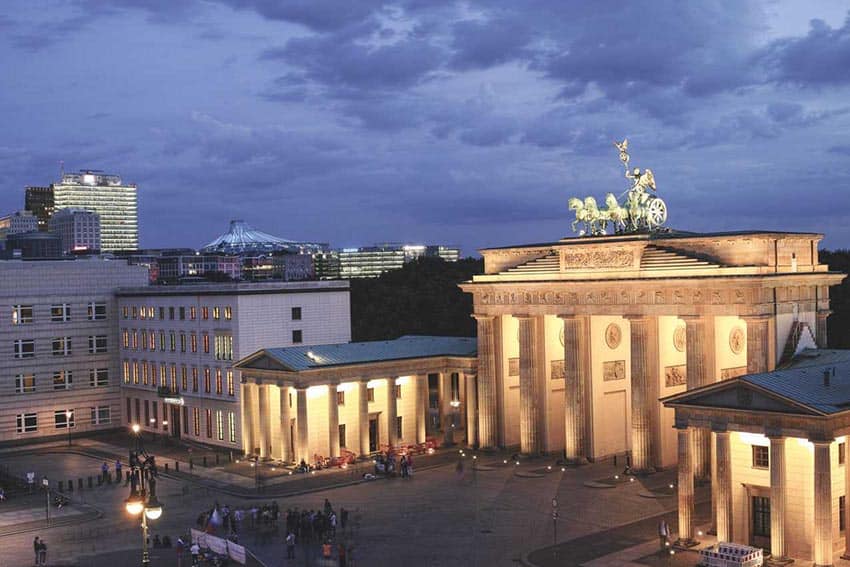
Dark Tourism Centers of Europe: Where Bad Things Once Happened
By Sian McQuillan
War, tragedy, death, and everything in between; Europe has experienced it all. Today, many tourists are keen to learn more about the continent’s dark past. Curious? Let’s dive right in.
Many tourists may gravitate towards the more glamorous and glittering aspects of the European continent, from the impressive Eiffel Tower in Paris to the famous Grand Canal in Venice. Still, many others may want to learn about the tragedy and turmoil that has ensued throughout the centuries.
From natural disasters to civil wars, continent-wide plagues to gruesome battles, Europe is home to centuries of dark and twisted tales. If you’re curious to learn more about the morbid secrets of the past, then here are the top ten cities in Europe for dark tourism .
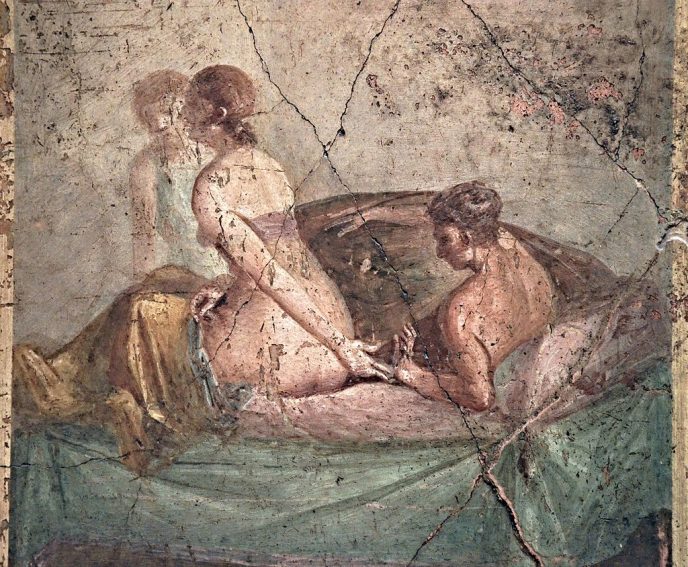
10. Pompeii, Italy – One of the most Tragic Natural Disasters in History
First up on our list of cities in Europe for dark tourism is Pompeii, situated just 25 km (15.5 miles) south of Naples. Once a thriving Roman city, Pompeii has been left abandoned since 79 AD, when Mount Vesuvius erupted, destroying everything in its wake.
About 20,000 inhabitants enjoyed a food market, a bar, many restaurants, several theaters, a gymnasium, aqueducts, baths, and even a hotel. Then, in 79 A.D. the sky came crashing down on them. Mount Vesuvius blew her top and buried everything under sixty feet of ash and pumice. The city was abandoned and eventually forgotten. Not until the mid-1700s was the town rediscovered through excavations.
Today, visitors can take a tour of the archaeological site and explore the excavated ruins of the streets and buildings that used to stand
9. Hunedoara, Romania – Home to a Terrifying Castle
You may not have heard of Hunedoara in Romania . However, we bet you’ve seen pictures of or heard of the haunting castle that stands here.
Corvin Castle, located in the region of Transylvania, Hunedoara, is as ominous as it first appears. First built in the 14th century, this castle is home to many dark and twisted tales that you can discover by taking a tour.
8. Paris, France – Discover the Creepy Catacombs
Many will know Paris for its glamour, architecture, and romantic appeal. However, you may be unaware of the darker side of the ‘City of Love’s past. Taking a walk below the city’s streets, you will be shocked by what you find.
Hidden 65 ft (20 m) below street level are the horrifying Catacombs . These underground ossuaries hold the remains of over six million people, and shockingly, you can explore this morbid site for yourself through the extensive tunnel system. Beneath each street in the city is a sewer pipe of the same name. Really, the trip is a wonderful experience: it doesn’t smell, but strapping, healthy rats do scurry around quite shamelessly; and of course, you can’t visit during or immediately after heavy rainstorms.
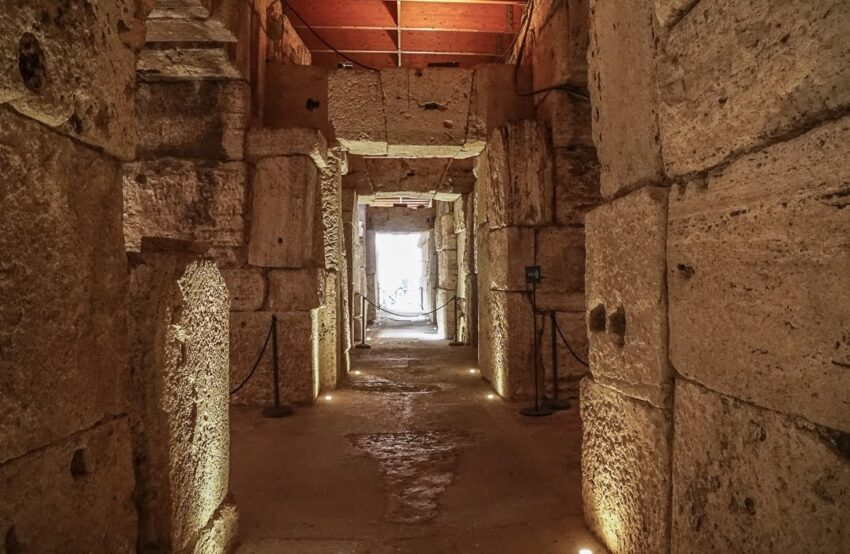
7. Rome, Italy – centuries of tragedy and suffering
As the site of emperors and battles, gladiators, and colosseums, Rome is one of the most historic cities in Europe. So, it comes as no surprise that the city has its fair share of tragedy and suffering.
Some of the most horrifying aspects of this city that you can discover to this day include the Ardeatine Caves , the Santa Maria della Concezione dei Cappuccini, the Colosseum , and Mussolini’s bunkers at Villa Torlonia.
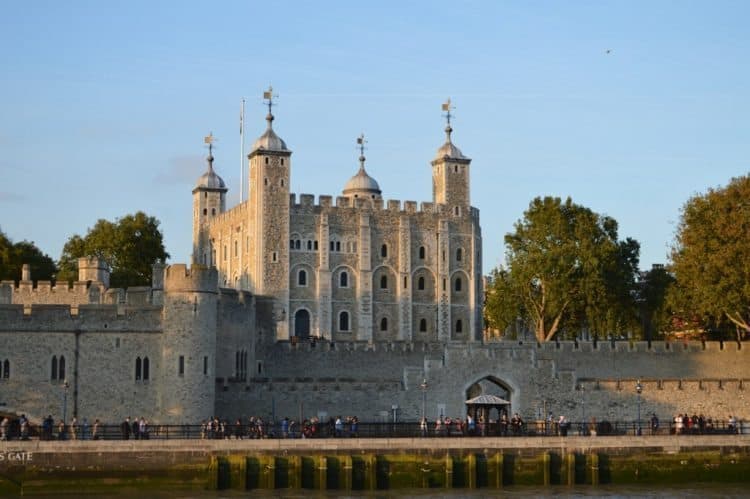
6. London, England – Full of Haunting Tales
The capital of the United Kingdom is no stranger to tales of tragedy and suffering. From plagues to city-wide fires, regions hit the hardest by the two world wars to gruesome murders, there is plenty of dark history to be discovered here.
Check out the Tower of London , take a tour to learn about the infamous serial killer Jack the Ripper, or check out the Monument to the Great Fire of London for some of the darker aspects of this city.
5. Berlin, Germany – One of the top Cities in Europe for Dark Tourism
It may not come as much of a surprise to see the German capital mentioned on this list.
As one of the cities hit the hardest by both World Wars and the Cold War, Berlin certainly boasts a horrifying past. While the city has seen huge progress and modernization in recent years, you can still discover all about its dark past while visiting. The Pearl on the River Spree still bears scars from the devastation of the Second World War, and from nearly 40 years of division brought about by the Cold War and the construction of the Berlin Wall. These scars still mar both the physical and mental landscapes of the city.
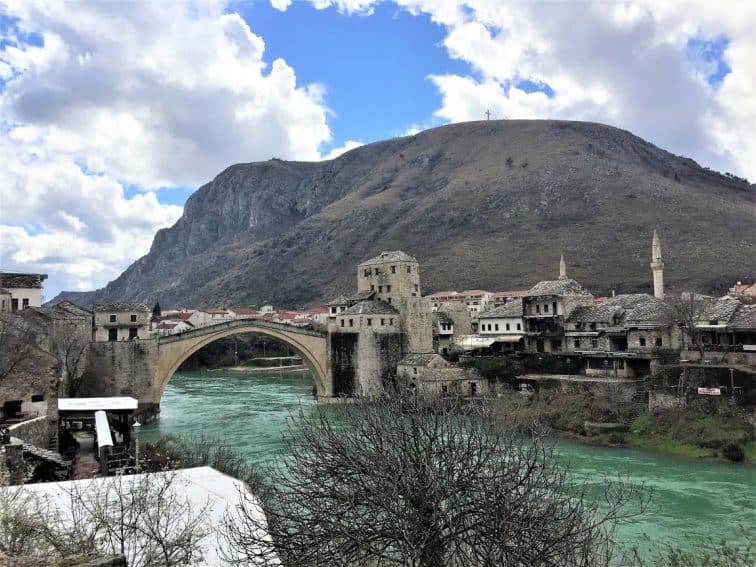
4. Sarajevo, Bosnia, and Herzegovina – a Tumultuous and Tragic History
Sarajevo is a city not to be missed when it comes to dark tourism. It is the city where Archduke Franz Ferdinand and his wife Sophie were assassinated in 1914, which is often deemed the catalyst for the start of the First World War. Bosnia was the most severely battered part of the region during the civil wars of the 1990s.
Photographs of the Old City “then and now”, show a degree of wanton destruction that is hard to imagine. What possible military purpose the city’s Old Bridge had is hard to tell, and why it was necessary to bomb the historical center is difficult to fathom.
Aside from that, the city has faced much tragedy and conflict throughout the last 100 years that can be discovered through War Tours and museums.
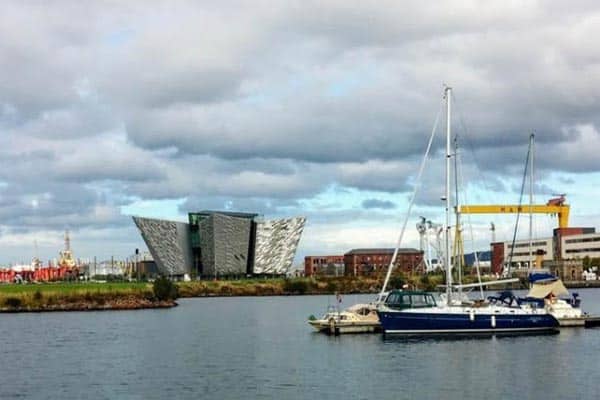
3. Belfast, Northern Ireland – Forty Years of Conflict
Many people still ask to this day whether or not it’s safe to visit Belfast. The answer is yes, but after years of conflict throughout the 20 th century, many are still wary of visiting.
One of the best things to do in Belfast to get an insight into its turbulent past is taking a Black Taxi Tour . On these tours, local guides will take you through the main sites of conflict, including the Peace Walls, and give you a fascinating insight into the city’s past. 90-minute mural tours take you from east to west, north to south taking in both sides of the community and how they depicted their war efforts through amazingly detailed murals.
All the cab drivers have lived through the bloodshed and give an insight into the history behind it all and their own experiences living through it.

2. Oswiecim, Poland – a Central Site of one of the Biggest Tragedies in Europe
You may not recognize the city, but we can bet you will recognize the name of the site we’re about to mention. Oswiecim in Poland is the home of Auschwitz-Birkenau , one of the largest and most notorious Nazi concentration camps in Europe. Dark Tourism doesn’t get much darker than this!
Over 1.1 million men, women, and children were murdered here between 1940 and 1945 as part of the Nazi’s brutal system of extermination. Today, the camp serves as a stark reminder of the Holocaust and the tragedy of human cruelty and suffering.
More than two million people from all over the world visit the Auschwitz-Birkenau Museum every year, and this year I was one of them. It’s difficult to talk about the experience, except to say that, along with the 50 million people who have visited the site since its liberation in 1945, I am a witness to the depths of human depravity.

It’s not just the incredible number of people who were murdered; it’s also the way that they were robbed of their humanity before they died.
1. Pripyat, Ukraine – the aftermath of a Nuclear Disaster
Topping our list of cities in Europe for dark tourism is Pripyat in Ukraine. Pripyat was the home of the Chernobyl Nuclear Power Plant , which exploded in 1986, causing a wave of radioactive dust to spread throughout the surrounding area. Two workers were killed instantly and 40 hours later the residents of Pripyat were ordered to evacuate – with no one to ever return. Almost 28 years on, you can now visit this ghost town taking one of several Chernobyl Tours that are available here.
Almost 50 years on, the radioactive chemicals are still in the atmosphere here. So, tourists must undertake various safety precautions before visiting.

- Latest Posts
- Arezzo, Tuscany: A Stunning Find - September 3, 2024
- Fall Clothing for Your Travels - August 30, 2024
- Mekong Chronicles: The River That Shaped Southeast Asia - August 28, 2024

Leave a Reply Cancel reply
Your email address will not be published. Required fields are marked *
Insert/edit link
Enter the destination URL
Or link to existing content
Subscribe for Our Latest Travel Articles
Pompeii, Italy – Dark Tourism
- Pompeii, Italy: The Ultimate Dark Tourism Guide to...
- Air France Business Class for the Paris 2024...
- Do you need a passport for Puerto Rico?...
- North America
- Travel Gear
- Dark Tourism
Voxplor News & Blog
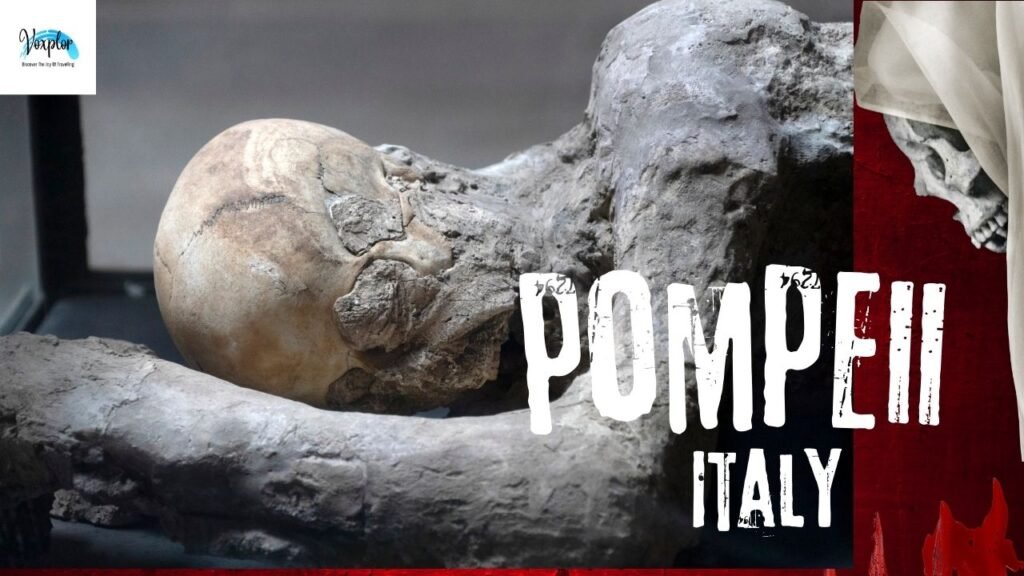
Pompeii, Italy: The Ultimate Dark Tourism

Air France Business Class for the
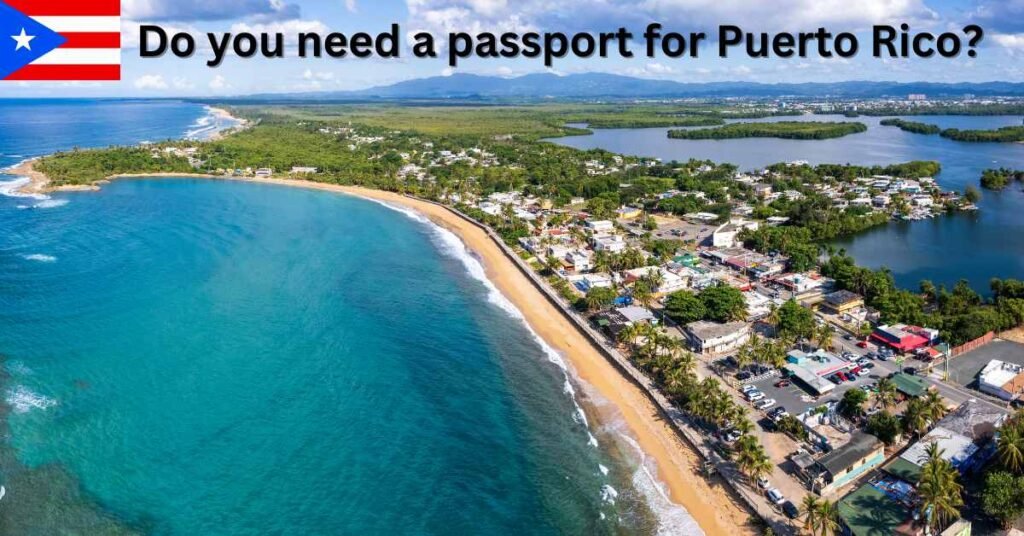
Do you need a passport for
Pompeii, Italy: The Ultimate Dark Tourism Guide to the Haunted Frozen City
- September 4, 2024
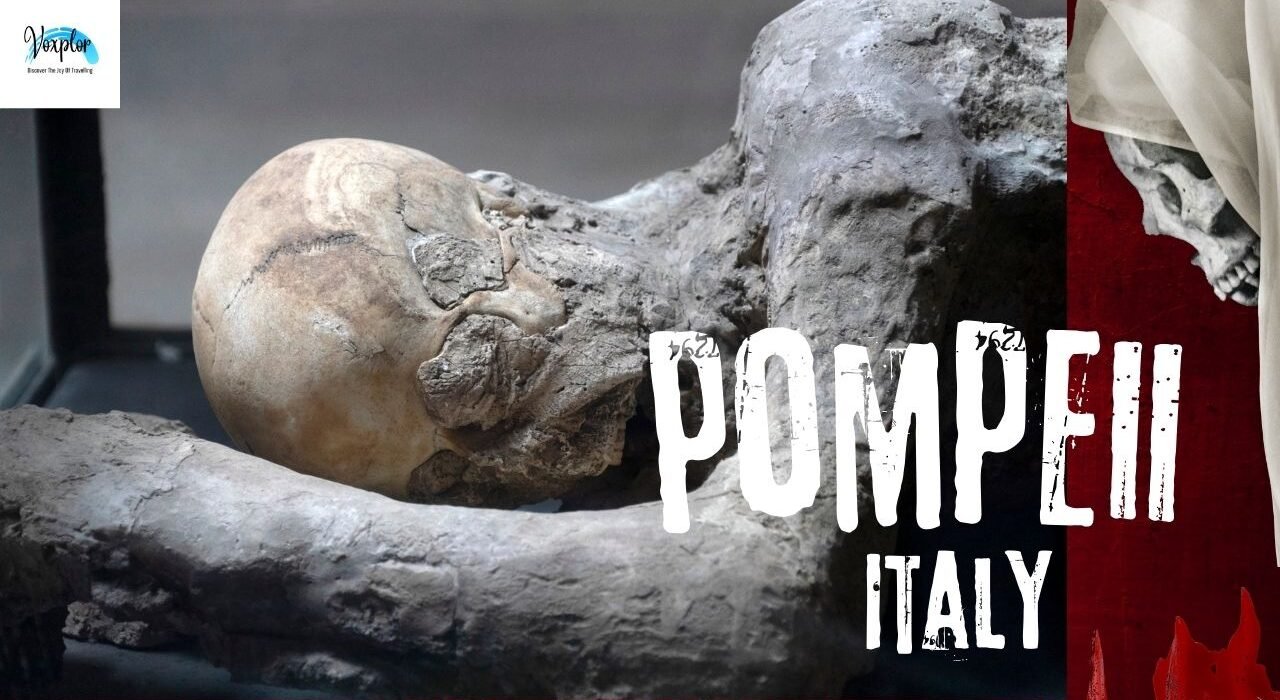
Pompeii, Italy a city frozen in time. This ancient Roman town which is tucked away close to the busy city of Naples has captivated the attention of millions of people because of its amazing preservation and tragic history of destruction.
With its unique opportunity to explore the ruins of a city decimated by a devastating volcanic eruption almost 2000 years ago Pompeii Italy is becoming one of the most popular destinations for dark tourism. We will examine Pompeiis history in this blog post as well as provide advice on lodging options transportation from the United States and must-see locations in the surrounding area.
Table of Contents
The tragedy of pompeii italy.
The Tragic Death of Pompeii. Prior to Mount Vesuvius disastrous eruption in 79 AD Pompeii was a flourishing Roman city. Pumice and volcanic ash covered the city keeping it remarkably intact during the eruption. A moving window into the lives of the ancient Romans is provided by the buildings artifacts and even the bodies of the victims that were sealed over time.
Pompeii was a thriving city with a population of over 11000 before the eruption. The city was renowned for its cutting-edge facilities which included a thriving marketplace public baths and an intricate water system. It was a wealthy artistic and cultural city with opulent homes covered in elaborate mosaics and frescoes.
But the eruption came as a shock burying the entire city in a matter of hours and taking the locals by surprise. When Pompeii Italy was rediscovered in the eighteenth century the horrors of that fateful day started to come to light during the excavation process. Presently the city stands as one of the most renowned archaeological sites globally drawing millions of tourists annually who come to observe the eerie remains of a once-thriving community.
The Rise of Dark Tourism in Pompeii, Italy
Traveling to locations linked to tragedy death and disaster—known as dark tourism—has become more and more common in recent years. One of the best examples of this trend is Pompeii . The well-preserved ruins provide a macabre yet fascinating window into Roman daily life and the tragic event that ended their civilization.
One of the most striking things about Pompeii Italyfor visitors is how silent the city seems. Its easy to picture the lively streets with shoppers kids having fun and people going about their everyday lives all unaware of the impending catastrophe as you stroll around the ruins. The experience is made even more poignant by the plaster casts of the victims who are captured in their last moments and act as a potent reminder of the human cost of the eruption.
How American Citizens Can Travel to Pompeii Italy.
It takes some preparation to get to Pompeii Italyfrom the United States but the trip is well worth it. This is how you can arrange the travel:
- As we take off for Italy : Flying into Naples International Airport (NAP) the closest major airport to Pompeii Italyis the most convenient way to get to the site. – The majority of flights to Naples from the United States will include at least one layover usually in a major European city like Rome Paris or Frankfurt. As an alternative, you can fly to Leonardo da Vinci International Airport (FCO) which is a little farther away but has more flight options.
- From Naples to Pompeii Italy : – By Train: From Napoli Centrale station you can catch a train to Pompeii after you arrive in Naples. Regular trains travel to Pompeii ItalyScavi station which is close to the archaeological sites entrance on the Circumvesuviana line. 30 to 40 minutes is how long the trip takes. By Car: Renting a car is an additional option if you would rather drive. Depending on traffic the drive from Naples to Pompeii takes around thirty minutes. –
By Tour Bus : A lot of tour companies provide guided tours from Naples to Pompeii covering travel expenses entrance costs and a tour guide-led through the ruins. Three.
To Pompeii from Rome: By Train: From Rome in approximately 1. 5 hours take a high-speed train to Naples. From there transfer to the Circumvesuviana line to reach Pompeii. –
By Car: It takes about 2 and a half hours to get from Rome to Pompeii.
Hotels in Pompeii Italy
Hotel Forum: This cozy hotel which combines traditional Italian charm with contemporary conveniences is only a short stroll from the archaeological site. After a day of touring the ruins you can unwind in the hotels lovely garden.
Villa dei Misteri: This inexpensive hotel provides simple but cozy lodging near the Pompeii Scavi station. For visitors who intend to spend the majority of their time exploring the location its a great option.
G rand Hotel Vesuvio : In Naples you may want to stay at the Grand Hotel Vesuvio for a more opulent experience. Beautiful views of Mount Vesuvius and the Bay of Naples can be found from this historic hotel. Although the price is a little high the location and service are excellent.
Hotel Piazza Bellini: This boutique hotel in the center of Naples provides chic lodgings and quick access to the citys top attractions such as the Pompeii ferry.
Hotel Bellevue Syrene : Another great place to stay is Sorrento a stunning seaside town close to Pompeii. The opulent accommodations at Hotel Bellevue Syrene provide stunning views of the ocean and convenient access to the Amalfi Coast.
Ulisse Deluxe Hostel: This Sorrento hostel offers reasonably priced cozy lodging in a welcoming environment for those on a tight budget. Must-See Locations in Pompeii and Other Areas. Although
Must-Visit Sites in Pompeii Italy
The pompeiian ruins: . – the forum:.
The Forum served as both the public gathering place and the citys main square in ancient Pompeii. Notable structures like the Basilica the Temple of Jupiter and the Macellum (marketplace) encircle it. A grand residence in Pompeii
The House of the Faun is renowned for its exquisite mosaics one of which is the famous Alexander Mosaic which portrays a battle between Darius III and Alexander the Great. –
The Amphitheater: The oldest Roman amphitheater still in existence it once held up to 20000 spectators for gladiatorial matches.
The Lupanar: The well-preserved frescoes that adorned the walls of Pompeiis former brothel are visible to visitors. Although a little risque the website provides an interesting look into the social scene of the city. 2.
Mount Vesuvius
To have an incredibly engaging experience think about trekking to the top of Mount Vesuvius. The views from the summit of the pompeii italy volcano are breathtaking and although it is still active it is safe to visit. The crater and the Bay of Naples are visible below offering a distinctive viewpoint on the topography and history of the area. Three.
Herculaneum
Herculaneum is another ancient city that was devastated by Mount Vesuvius but it is frequently eclipsed by Pompeii. The location is more compact but has been better preserved featuring vivid frescoes that provide a closer-up view of Roman life and well-preserved wooden buildings.
The National Archeological Museum of Naples
Its essential to pay this museum a visit if you want to view some of the artifacts that have been retrieved from Herculaneum and Pompeii. The extensive collection of sculptures mosaics and commonplace objects housed within offer a more profound comprehension of the ancient cities.
Traveling to Pompeii is like taking a trip back in time giving you the unique chance to discover an ancient city preserved in stone. Pompeii is a place that makes an impression regardless of whether you are drawn to it by its tragic past haunting beauty or historical significance. By following this guide youll be ready to explore the rich cultural heritage of the surrounding area and make the most of your trip to this poignant and fascinating site. Your trip to Pompeii is guaranteed to be an experience of a lifetime regardless of whether youre lodging in the vibrant city of Naples the charming town of Sorrento or the heart of Pompeii.

Air France Business Class for the Paris 2024 Olympics: Experience Luxury
You may also like
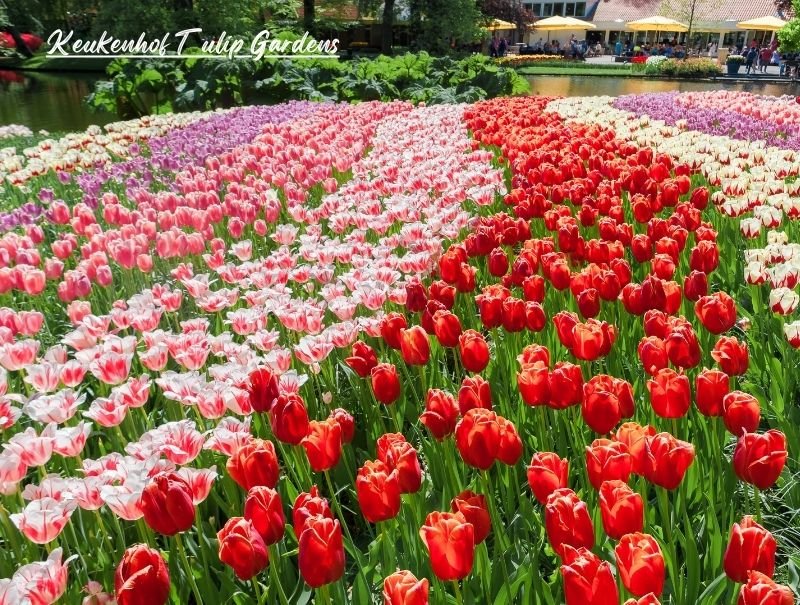
Keukenhof tulip festival 2024- Explore the Beauty of Europe’s Largest Garden
- July 11, 2023
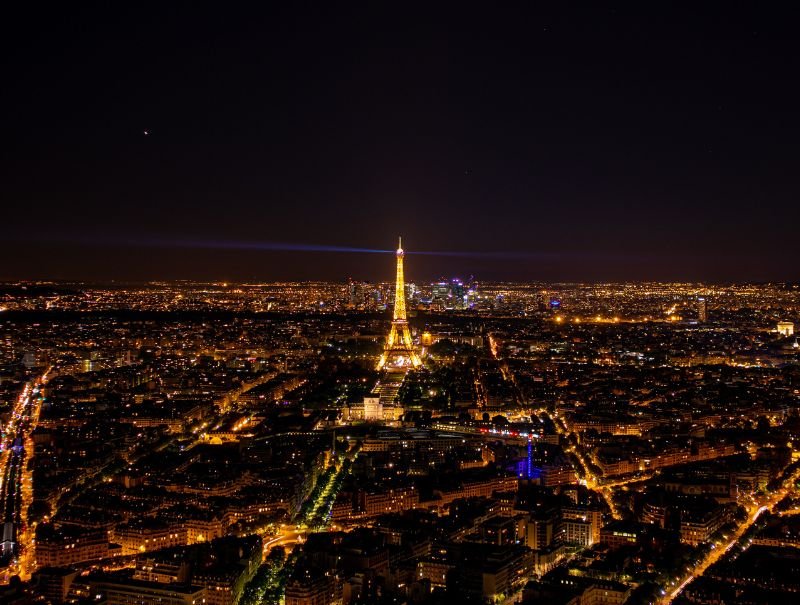
Unveiling the Magic of Paris: Your Ultimate City of Lights Guide
- September 13, 2023
- Harper's Bazaar
- Aaj Tak Campus
- India Today
- Business Today
- Cosmopolitan
- Reader’s Digest
- IndiaTodayNE
- Brides Today
Heard of dark tourism? Here are 10 places to visit for it
From poignant memorials to haunting historical sites, each place tells a story of tragedy and resilience..
Ever heard of dark tourism? No, it's not your usual sun and sand vacation or posing in front of iconic landmarks. We're talking about diving deep into the mysterious and somewhat eerie pages of history, exploring sites linked to tragedy, morbidity, and death! Sounds unsettling, right? But it's way more fascinating than your average beach trip.
So, what's the deal with dark tourism? Well, imagine a world where your travel itinerary goes beyond the ordinary and into the realms of the bizarre. That's where dark tourism comes in. It's not about your typical touristy stuff; it's about delving into the darker side of human history, where stories are rooted in tragedy, conflict, and catastrophe.
Now, some might say, "Why on earth would anyone want to visit places associated with death and gloom?" But hold on! There's a method to the madness. Dark tourism isn't just about embracing the macabre; it's a testament to our inherent curiosity. It's about getting in touch with your humanity in a lot of ways. We're not avoiding history; we're diving headfirst into it, trying to make sense of the hardships and losses that shaped our past.
Ready for it? Here are our 10 top picks.
The Catacombs of Paris, France Beneath the romantic streets of Paris lies a macabre world—the Catacombs, where the bones of millions are arranged in bizarre patterns. In the 18th century, Paris grappled with a significant public health crisis, with local cemeteries became overcrowded, leading to improper disposal of corpses and the subsequent spread of diseases. To address this pressing issue, the city opted to repurpose its extensive subterranean Lutetian limestone quarries, transforming them into expansive underground ossuaries.

Auschwitz Birkenau, Poland Nestled in the quiet countryside of Poland, Auschwitz-Birkenau stands as a haunting site to one of the darkest chapters in human history—the most extensive Nazi concentration camp during World War II, which tragically became a site of mass genocide, claiming the lives of more than 1.1 million people, with a staggering 9,60,000 of them being Jews. Visitors come to pay their respects, learn about the atrocities committed, and reflect on the importance of preserving human rights and preventing such horrors from happening again.
View this post on Instagram A post shared by Auschwitz - Birkenau Oświęcim (@auschwitz_birkenau)
Chernobyl, Ukraine On April 26, 1986, an explosion occurred in nuclear reactor number four at the Chernobyl Nuclear Power Plant in Pripyat, Ukraine.This catastrophic event rendered the area uninhabitable, leaving it in ruins. It has become a unique destination for those interested in the intersection of history and environmental impact. Estimates by scientists suggest that the land around Chernobyl may need as long as 20,000 years for complete recovery from the effects of radioactive damage. Nearly 37 years later, evolving into a deserted town with forsaken schools, hospitals, and apartment buildings, the Chernobyl vicinity has become a magnet for thousands of visitors.
Tours take visitors through abandoned towns and the decaying remnants of a once-thriving community, offering a somber reminder of the consequences of nuclear technology gone awry.
View this post on Instagram A post shared by Keisuke Shingu | Based in Fukuoka (@kei.photography)
Ground Zero, USA The term "Ground Zero '' originally referred to the point on the Earth's surface directly below or above an exploding nuclear bomb. For this one, it is the site of the September 11, 2001 terrorist attack, which serves as a poignant tribute to the nearly 3,000 victims who lost their lives during the attacks. The memorial features twin reflecting pools set within the footprints of the original towers, inscribed with the names of those who perished. It draws visitors seeking to pay tribute to the lives lost and understand the profound impact of the event on global history.
View this post on Instagram A post shared by Pâmella Miranda • Trips da Pam (@tripsdapam)
Pompeii, Italy Pompeii, Italy, stands as a captivating dark tourist site, frozen in time by the catastrophic eruption of Mount Vesuvius in 79 AD. The ancient city was buried under layers of ash and pumice, preserving its streets, buildings, and inhabitants in an eerie tableau. The plaster casts of citizens, captured in their final moments of agony, add a hauntingly human dimension to the tragedy that befell Pompeii. Several guided tours and excursions are available for tourists, providing access to historical sites surrounding the remarkably preserved ruins like Pompeii Archaeological Park and the forum that are still frozen in time.
View this post on Instagram A post shared by Morbid Anatomy (@morbidanatomy)
Hiroshima Peace Memorial, Japan It opened in August 1955, The Hiroshima Peace Memorial, also known as the Atomic Bomb Dome, stands as a symbol of peace and a reminder of the devastating impact of nuclear warfare. Visitors to the Hiroshima Peace Memorial can explore the museum, which houses artefacts, personal belongings, and first hand accounts of the atomic bombing. Every year around 1 million people visit this site.
View this post on Instagram A post shared by mao onodera (@tsumugi9312)
Robben Island, South Africa Robben Island, situated off the coast of Cape Town, South Africa, once a notorious political prison, held Nelson Mandela and other anti-apartheid activists during South Africa's dark history of racial segregation. Political prisoners endured harsh conditions, forced labor, and systematic oppression. Today, it serves as a museum and a UNESCO World Heritage Site, providing insight into the struggles for freedom and equality.
View this post on Instagram A post shared by Amanda White (@amandalikestheworld)
Tuol Sleng Genocide Museum, Cambodia It is a haunting site that bears witness to the atrocities committed during the Khmer Rouge regime from 1975 to 1979. Formerly a high school turned into a prison, the Tuol Sleng Genocide Museum stands as a stark reminder of Cambodia's painful history, showcasing the inhumane treatment suffered by an estimated 17,000 people who passed through its gates. The museum also displays the crude instruments of torture and the grim cells where detainees were held in appalling conditions.
View this post on Instagram A post shared by Tuol Sleng Genocide Museum (@tuolslenggenocidemseum)
Jallianwala Bagh The tragic incident took place on April 13, 1919, as the sun dipped below the horizon, Brigadier General Reginald Dyer ordered British troops to open fire on a gathering of unarmed Indian civilians who had assembled for a peaceful protest against the repressive Rowlatt Act. The echoes of gunfire in the enclosed garden created a macabre symphony, resulting in the loss of hundreds of lives and leaving thousands injured.
View this post on Instagram A post shared by Amit Panchal (@amithpanchal)
The Killing Fields, Cambodia The Killing Fields, a series of sites where mass executions occurred during the Khmer Rouge regime, serve as a stark reminder of Cambodia's tragic history. It offers an immersive experience, with audio guides providing firsthand accounts from survivors and historical context. The remnants of clothing and bone fragments that occasionally surface from the ground serve as haunting reminders of the human tragedy that unfolded here.
View this post on Instagram A post shared by @citrachristina
Dark tourism, though unconventional, offers a unique lens through which travelers can explore the complexities of human history. These 10 destinations represent just a fraction of the many sites around the world that attract visitors seeking to engage with the darker chapters of our collective past.
Feature image: @lyndseyfaye/instagram
The catacombs of paris image: @undeadforeststudios/instagram

The future of luxury travel in India is in sustainable eco-boutique stays

The launch of Armani/Caffè is the beginning of a new era of luxury dining in India

What the new fashion and beauty closet icons look like today according to Madé Lapuerta

Homegrown beauty brands reveal what goes into creating an iconic product

Our favourite moments from London Fashion Week SS25

Rahul Mishra weaves magic into Tod's heritage

This designer's exquisite jewellery collection honours Odisha’s Bonda tribe

#SpoilerAlert: Who killed Merritt Monaco in ‘The Perfect Couple’? We explain the ending

The hottest moments from the New York Fashion Week 2024

How to nail the dark feminine make-up look
- TN Navbharat
- Times Drive
- Health and Me
- ET Now Swadesh
destinations
Dark Tourism Sites: 8 Most Eerie Tourist Destinations Around the World
Dark tourism involves visiting places linked to death, tragedy, or the macabre, giving you a look into the darker parts of human history and culture. these sites often make you understand historical events and their lasting effects. here are eight of the most eerie tourist spots around the world that attract those interested in the haunting side of history..

Updated Aug 17, 2024, 20:00 IST
Pompeii, Italy
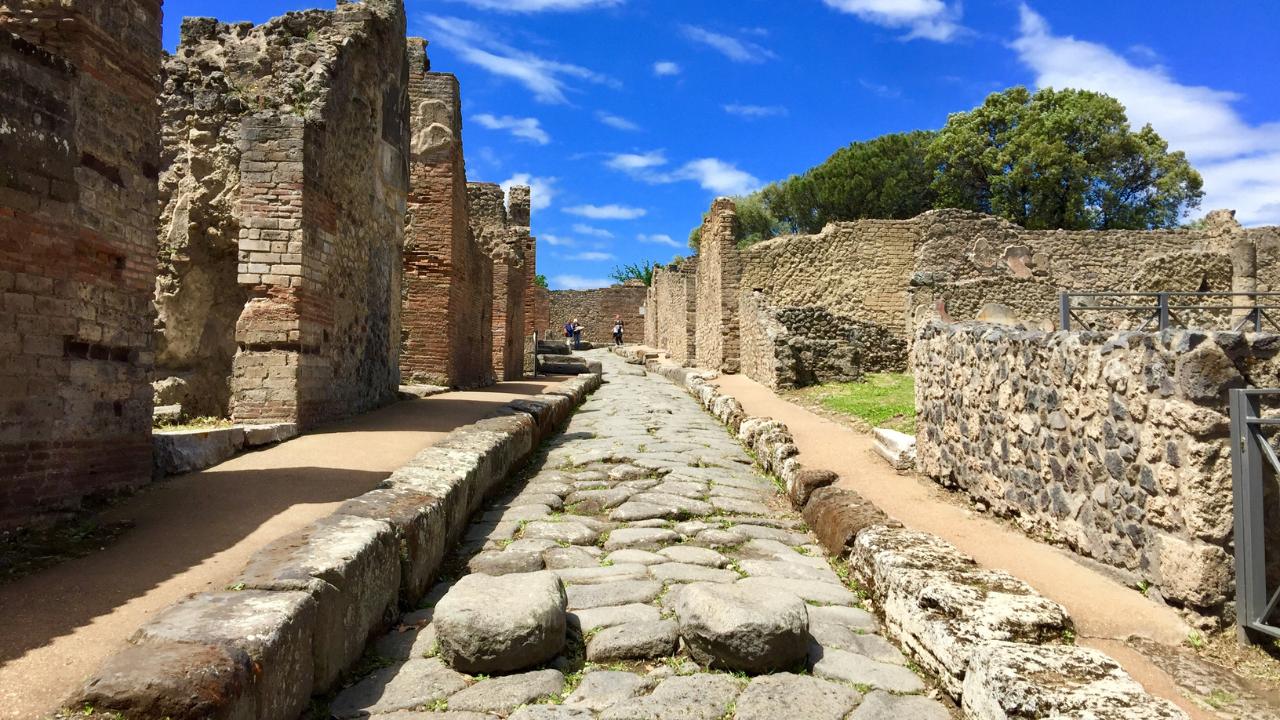
Pompeii is an ancient Roman city near Naples that was buried under volcanic ash and pumice when Mount Vesuvius erupted in AD 79. The city remained hidden until it was rediscovered in the 18th century. Today, visitors can explore the well-preserved ruins, including homes, streets, and artefacts. The ash kept the city so intact that it offered a clear view of daily life during the Roman Empire. Key sites include the Forum, the Amphitheater, and the Villa of the Mysteries, known for its detailed frescoes. The sudden eruption froze the residents in their final moments, with their casts preserved by the ash, giving a hauntingly personal look at the tragedy that struck the city.
Phnom Penh, Cambodia
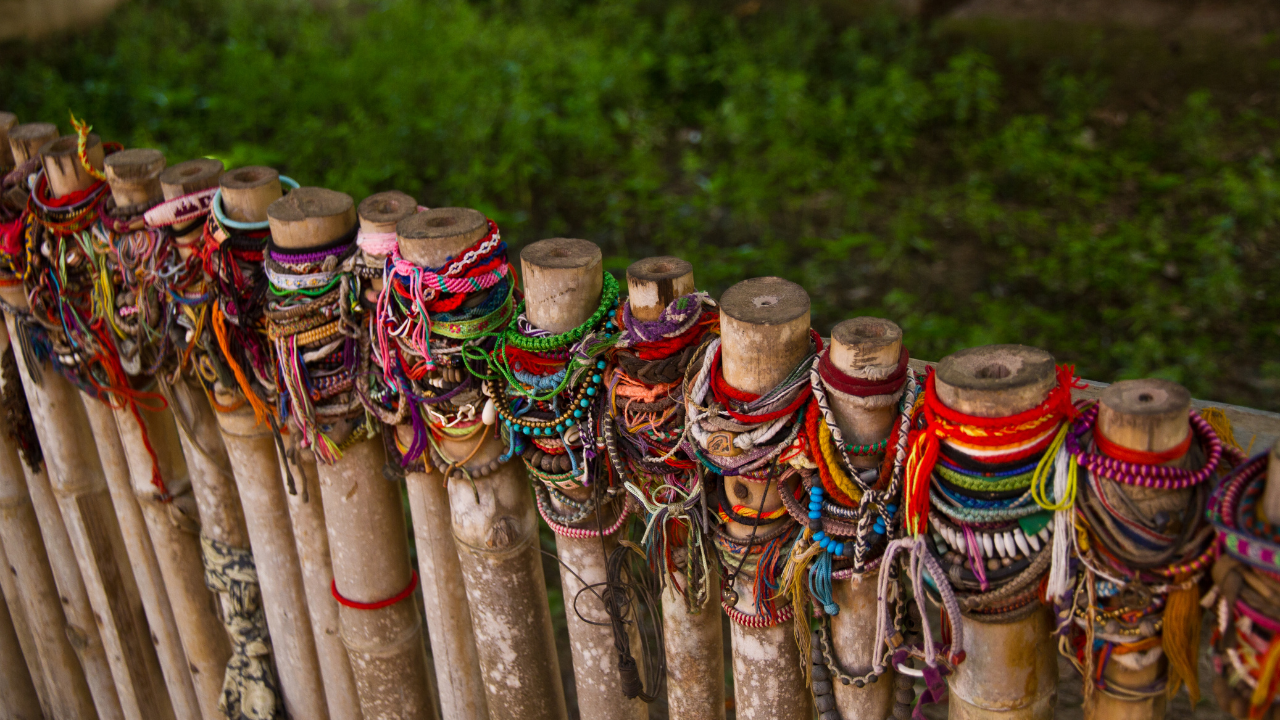
Phnom Penh, the capital of Cambodia, is known for the Killing Fields and the Tuol Sleng Genocide Museum, both of which remember the horrors of the Khmer Rouge regime (1975-1979). At the Killing Fields of Choeung Ek, visitors can see mass graves and a memorial stupa filled with thousands of human skulls. The Tuol Sleng Museum, once a school turned into a torture centre, shows grim evidence of the regime's brutality, including photos of victims and torture devices. The sheer scale of the genocide and the preserved evidence of the torture and killings make it a chilling experience, highlighting the terrible consequences of political violence and oppression.
Murambi, Rwanda
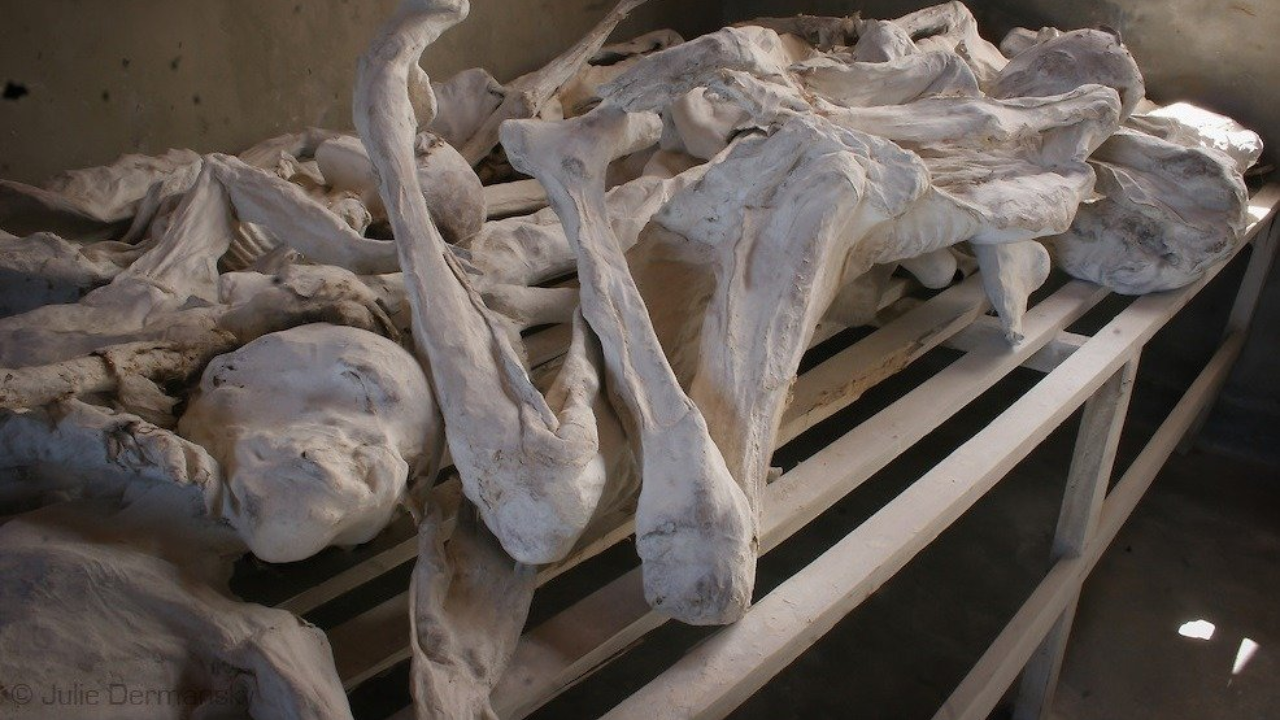
Murambi is a site of one of the most harrowing chapters of the Rwandan Genocide in 1994. The Murambi Memorial Centre is located at a former technical school where thousands were killed. The site includes a memorial with preserved remains of victims, displayed in an unembellished manner. Visitors can also explore the mass graves and learn about the events through exhibits detailing the genocide's impact on the local population. The raw presentation of the victims' remains and the stark reminders of the violence and loss make it a profoundly sobering site. It serves as a stark reminder of the genocide's brutality.
Hiroshima, Japan
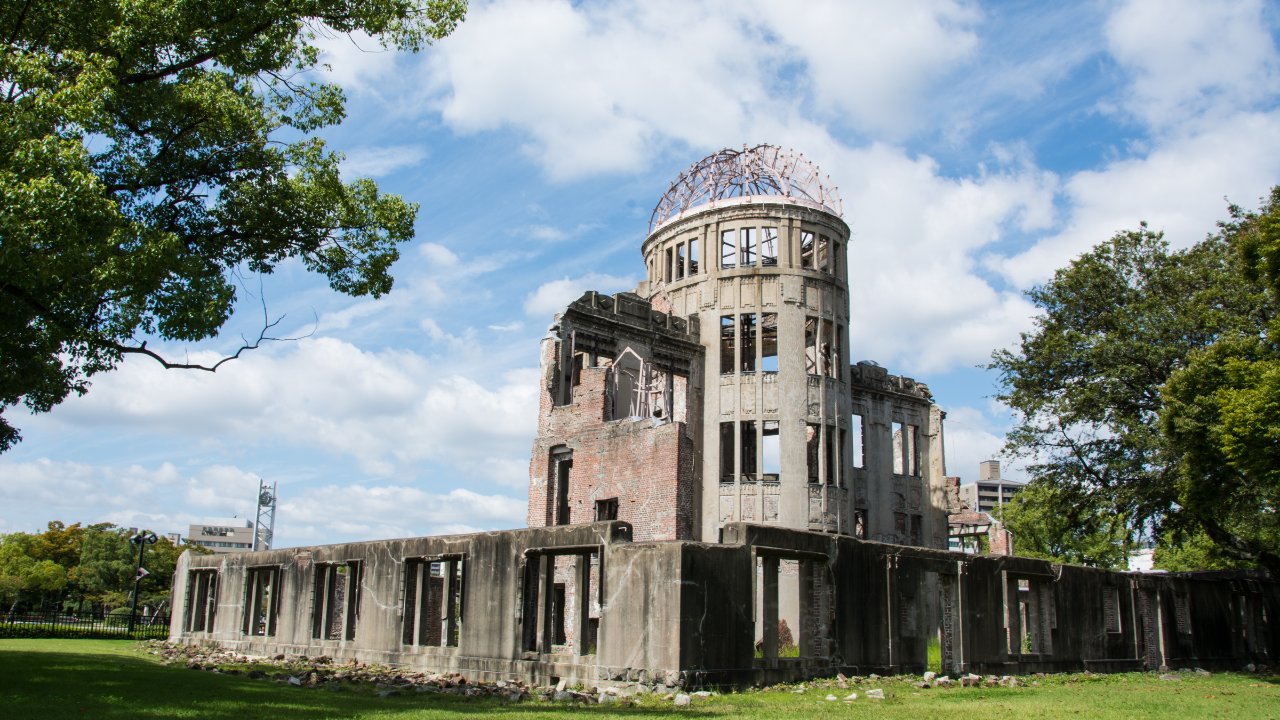
Hiroshima was the target of the first atomic bomb used in warfare, dropped by the United States on August 6, 1945. The Hiroshima Peace Memorial Park now stands as a tribute to the victims and a symbol of peace. Key sites include the Atomic Bomb Dome, which was left in its ruined state as a symbol of the devastation, and the Hiroshima Peace Memorial Museum, which provides detailed accounts of the bombing’s impact and aftermath. The immense destruction and loss of life from the atomic bomb, combined with the haunting remains of buildings and the sobering museum exhibits, offer a poignant reflection on the horrors of nuclear warfare.
Catacombs of Paris, France
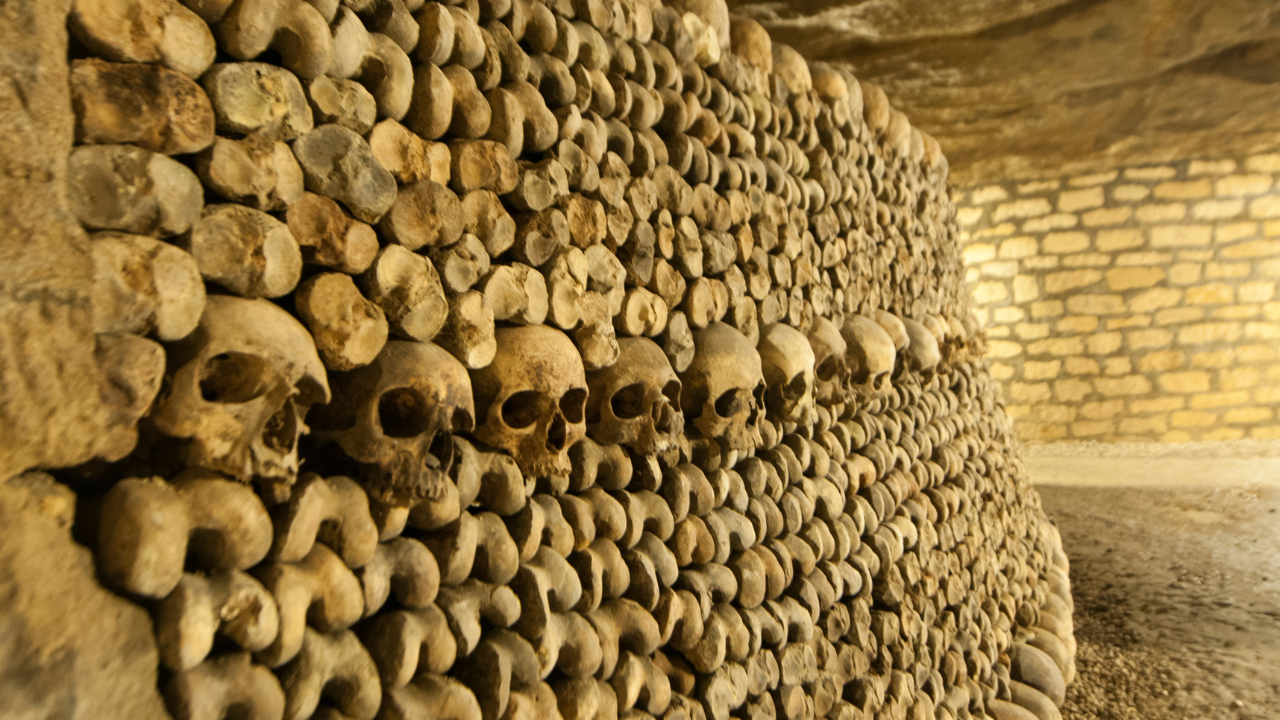
The Catacombs of Paris are an underground network of tunnels that hold the remains of over six million people. They were created in the late 18th century to deal with the city's overflowing cemeteries. Visitors can walk through these winding tunnels, where bones and skulls are neatly arranged along the walls. The Catacombs provide a haunting look into the city's past and how it managed its dead. The vast number of human remains and the dark, maze-like tunnels create an eerie atmosphere, making the experience both unsettling and unique.
Alcatraz Island, California
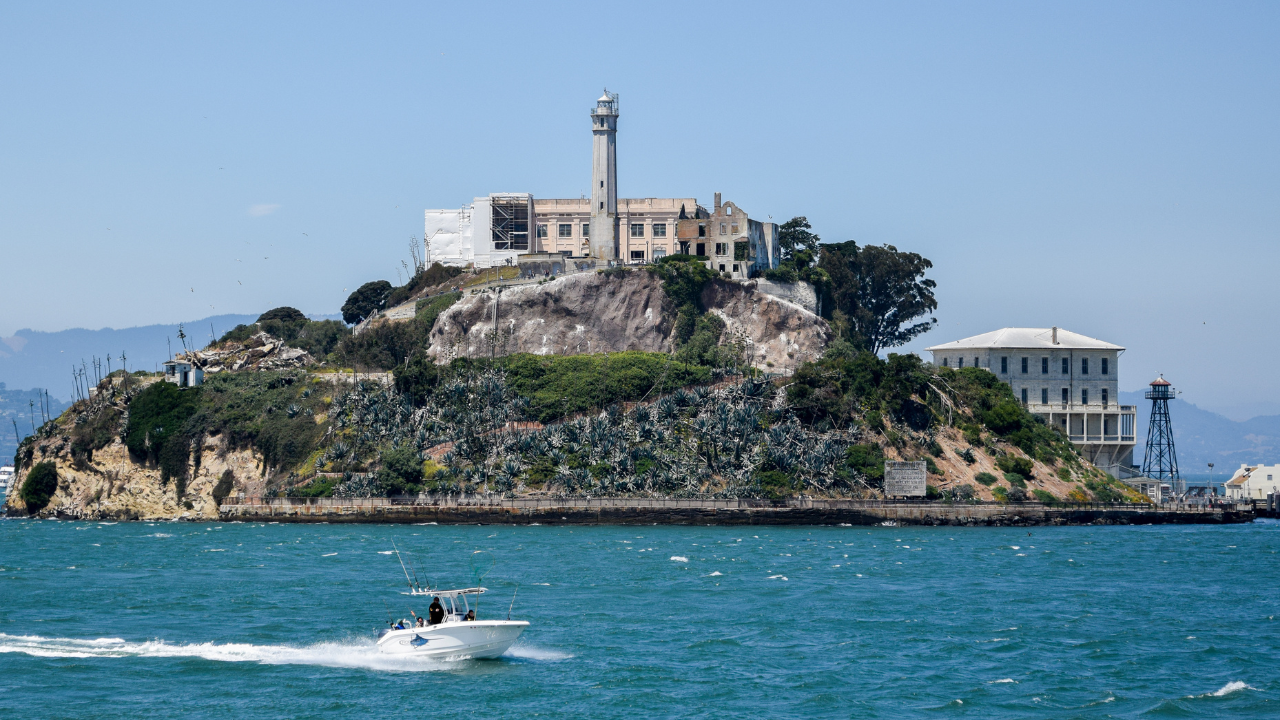
Alcatraz Island, located in San Francisco Bay, is known for its infamous federal prison, which housed some of the most notorious criminals from 1934 to 1963. The prison itself, with its stark cells and solitary confinement areas, is the primary attraction. Guided tours provide insights into the lives of the inmates, the attempted escapes, and the daily harsh conditions. The island's isolation and the stories of escape attempts, as well as the harsh conditions of imprisonment, contribute to its eerie reputation. The combination of the prison's history and its remote location adds to the site’s grim allure.
Cape Coast, Ghana
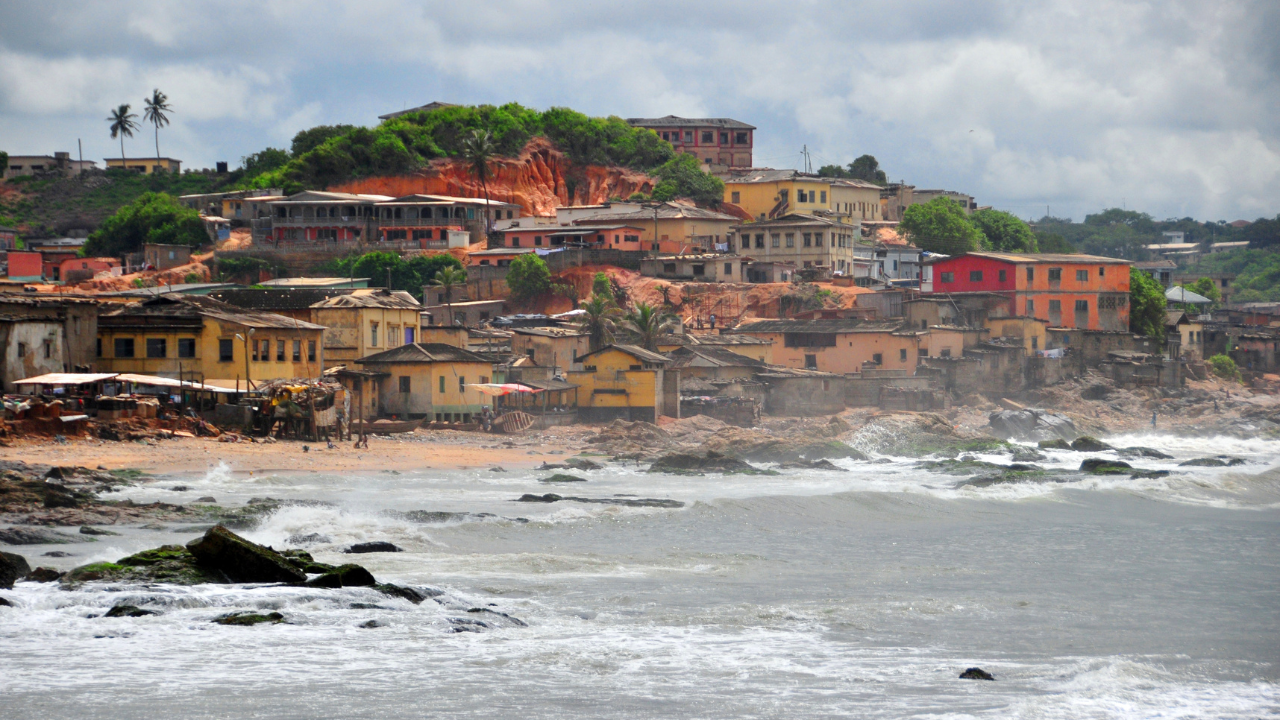
Cape Coast is home to the Cape Coast Castle, a key site in the transatlantic slave trade. The castle was used as a holding centre for enslaved Africans before they were shipped to the Americas. Visitors can tour the castle’s dungeons, where enslaved people were kept in inhumane conditions. The castle also features exhibits on the history of the slave trade and its impact on African societies. The dungeon areas, where human suffering was intense, along with the historical context of the slave trade, make it a deeply sobering and haunting place to visit.
Pripyat, Ukraine
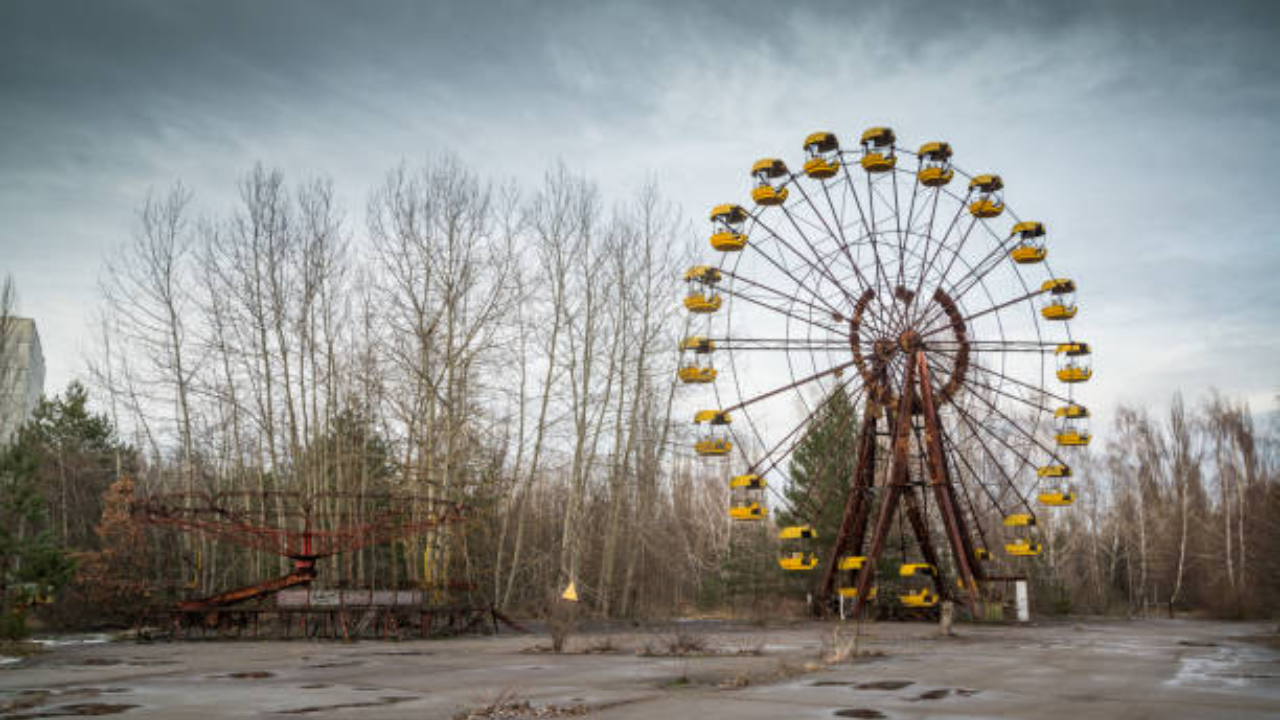
Pripyat is an abandoned city near the Chernobyl Nuclear Power Plant, which suffered a catastrophic nuclear disaster in 1986. The city was evacuated and remains frozen in time. Visitors can explore the ghostly remains of the city, including abandoned buildings, schools, and homes. The nearby Chernobyl Exclusion Zone also offers tours of the power plant itself. The deserted city, with its intact yet decayed buildings and the eerie stillness, evokes a sense of post-apocalyptic desolation. The combination of the disaster's history and the abandoned setting creates a haunting experience.

PM Modi's Sharp Attack On 'Parivarvad' Ahead Of Jammu And Kashmir Assembly Polls | NewsHour

Manipur Violence: Peacekeeping Efforts Ramped Up Amid Fresh Protests And Unrest | National Debate

Street Diaries with Aditya Seal | Aditya relishes Chinese cuisine; discusses Alia Bhatt and Raha Kapoor

Onam sadya special by Marina Balakrishnan

5 Ways the Sun is Bigger Than You Can Comprehend

Home » Travel Guides » Italy » 15 Best Pompeii Tours
15 Best Pompeii Tours
Pompeii is a unique historic site in that in an ironic twist of fate, the catastrophe that decimated the citizens of the unsuspecting town is also responsible for the near-perfect preservation of many things that would have otherwise been destroyed in all other such natural disasters.
You’ll see art, furniture, and other everyday items the citizens used – in addition to the macabre plaster forms that are accurate representations of the citizens as captured in their last living moments.
Other beautiful coastal towns are nearby and easy to get to, including wineries, ancient villas, grottos, and breathtaking seaside resorts.
1. Pompeii Private Day Trip with Local Guide

This private tour of the amazing and cursed town of Pompeii is a great way to get your Mediterranean coast vacation started.
Your licensed guide will give the tour in either English or Italian; following his lead, you’ll visit the city’s ruins that have been astonishingly well preserved.
The town is full of narrow streets brimming with the histories of the families who called this prosperous town home before that fateful day nearly 2,000 years ago.
The tour includes stops at a theatre, a brothel, and other homes and businesses, as well as the eerily accurate plaster casts of the inhabitant’s last minutes.
2. Guided Walking Tour of Pompeii

This 2 ½-hour guided tour is available in English, French, German and Spanish, and will allow you to skip right through the line and get priority entrance.
Pompeii is one of Italy’s most visited and iconic sites – it’s also a UNESCO World Heritage Site.
You’ll spend the afternoon discovering the history of this amazing city that was literally frozen in one historically unique moment in time and covered with layers of ash that in some areas exceeded 20 feet deep.
Much of the buried city wasn’t excavated until nearly 1,500 years later, making those undisturbed time capsules shocking and amazing in their completeness and preservation.
View Prices & Reviews
3. Pompeii Small Group Tour with an Archaeologist

If you’re an amateur historian or just want to know all there is to know about what makes Pompeii such a once-in-a-lifetime vacation opportunity, this two-hour guided tour is a great choice.
Your guide will be a knowledgeable and enthusiastic archaeologist who’s up to date on all the historical facts and personal anecdotes that make the town’s story so fascinating and macabre.
The maximum group size is just 15 guests, which means you’ll get that intimate feeling and attention to detail that’s so often lost with large groups.
The tour includes the Marina Gate, baths, a bakery, the basilica, and the plaster death masks.
4. Pompeii Wine Tasting with Lunch

After so much time spent among the amazing city’s long dead, it might be a good idea to switch gears and indulge yourself in a little gastronomical treat at one of the area’s most recognized vineyards.
This two-hour guided tour is available in four languages and accessible to those in wheelchairs.
You’ll see the winemaking process from beginning to end as you stroll through the vineyards, production facility, and the wine cellars where the wine is aged to perfection.
An array of food and wine samples will wet your whistle, and though door-to-door transportation isn’t included, all else is.
5. Full-Day Sightseeing Tour of Pompeii and Herculaneum from Naples

If you happen to be staying in Naples but are longing to explore Pompeii and Herculaneum, this full-day tour should be on your itinerary.
You’ll see the ruins of Pompeii in the morning with a guide, and after lunch, you’ll be free to discover Herculaneum at your own pace.
Door-to-door transportation from Naples is included. In addition to the archaeological sites, you’ll look into some of the local shops and pick up a few mementos of your trip.
This tour is nearly all-inclusive; though the entrance fees and lunch are included, you’ll need to pay for your own drinks.
6. Full-Day Tour of Naples and Pompeii from Rome

In case you were wondering, it’s possible to visit Pompeii and Naples in a day-trip from Rome.
At 14 hours, it’ll definitely be a tiring day, but transportation is included and it’ll be well worth it when you look back on the amazing amount of history and sights that you were able to cram into only one day.
Due to its length and the significant amount of walking that’s required, this tour isn’t a great fit for very young children, the elderly, or those in less than tip-top physical shape.
It’s recommended that you bring a good hat, sunglasses and a comfortable pair of shoes.
7. Private Villa Cimbrone and Pompeii Tour from Rome

Villa Cimbrone is a large historic estate situated on a rocky bluff over the majestic Amalfi Coast.
The grounds include acres of open space that is full of statues, gardens, and fountains.
In the gardens, you’ll find interesting and risqué representations of Biblical themes like the Seven Deadly Sins, as well as mythological stories and historically important events.
After lunch, you’ll head to Pompeii and check out the town’s amazing sites as your guide gives you an intimate insight into the lives of the inhabitants before their normal lives were cut short in 79 AD.
Transportation and entrance fees are included but food and drink are not, so bring a few Euros.
8. Boat Tour from Sorrento to Pompeii and Capri

If your base of operations for your Italian vacation is Sorrento but you’d still like to see Pompeii and Capri, this tour is for you.
After meeting your guide, you’ll head to the Port of Piano di Sorrento, then go via boat to the Port of Castellammare di Stabia.
From the boat, you’ll see some of the most amazing views of the coastal towns surrounded by hills and cliffs shimmering against the bright blue water.
Your guide will lead you on a tour through Pompeii’s narrow streets and must-see historical sites, after which you’ll head by boat to the island of Capri and take in its many famous grottos.
9. Naples and Pompeii Train Trip from Rome

If you’re young, adventurous and up for an amazing tour of southern Italy by train, this Rome based tour of Naples and Pompeii is a great choice.
It’s only open to those between18 and 39-years-old, which should keep the tour’s pace quick and lively.
Your local guide will share lots of amazing and historical facts about the town of Pompeii and its people, whose lives were prematurely snuffed out on the day of the eruption in 79 AD.
You’ll also have a few hours of free time before traveling to Naples, one of the Italian coast’s most scenic cities that’s also known for its delicious food – especially pizza.
10. Pompeii, Sorrento and Positano Group Tour

Whether you’re staying in Naples, Salerno or Amalfi, you’ll be able to join this tour that will include Pompeii, Sorrento, and Positano.
The tour is available in three languages and includes pick-up from the ports of Naples, Salerno, and Amalfi.
Though Pompeii is the tour’s focal point, you’ll also get a chance to enjoy the amazing town of Sorrento, which is a mecca for lovers of Italian cuisine.
Last but not least, you’ll visit the scenic town of Positano that rests atop a rocky bluff overlooking the sea.
Keep in mind that this tour doesn’t include entrance fees, food or drink.
11. 3-Day Tour from Rome to Naples, Pompeii and Amalfi Coast

For those looking for a multi-day, full-immersion tour into the beauty and history of southern Italy, this three-day Naples, Pompeii, and Amalfi tour from Rome is probably the best option.
The tour will be a pleasant mix of guided and unguided time, which will allow you to venture off the beaten path, get away from the crowds, and do exactly what you want.
After the guided portions of your Naples and Pompeii stops, you’ll get plenty of opportunities to enjoy the Amalfi Coast, its beautiful beaches and the amazing seaside town and its stunning vistas.
The tour includes transportation and some meals but not museum admission – except in Pompeii.
12. Pompeii and Herculaneum Half-Day Private Tour

Though Pompeii’s sites really deserve a full day, if you haven’t got that much free time to spare, there are a few options that’ll give you a thorough look at the town’s attractions in only a few hours.
This private four-hour tour is available in nearly 10 languages. In addition to Pompeii, it includes a stop in Herculaneum; although smaller and less known than Pompeii, it’s actually a better-preserved site.
With the preserved items you’ll see and your guide’s careful explanation, the town will come to life, though the tragedy happened nearly 2,000 years ago.
13. Pompeii, Mount Vesuvius, and Winery Day Tour

Pompeii is an amazing town that’s one of the most historic and visited in all of Italy.
That being said, all that morbid chaos and death caused by the fateful volcanic eruption so many eons ago can be a little on the depressing side.
Though even in Pompeii you’re surrounded by natural beauty, it might be worth considering adding a few upbeat activities to your itinerary to mix things up a bit.
If this sounds like a good idea, consider this tour, which includes trips to Mount Vesuvius and a local winery located at the mountain’s base.
You’ll tour the vineyard and sample the wine varieties that are produced.
This tour includes transportation, but not admission fees to historical sites or food.
14. 2-Hour Walking Tour of Pompeii with Light Lunch

For those who don’t want to commit too much of their time to one tour, this two-hour walking tour with a light lunch is a great value.
You’ll still get to see the area’s excavations, architecture, and wonderfully preserved art, but the rest of your day will be wide open so you can go wherever your spirit takes you.
Your local and knowledgeable guide will fill in lots of amazing historical details about the city that was caught off guard and paid the ultimate price.
You’ll get an amazingly accurate insight into the daily lives of the common people who called the town home before it was ravaged.
15. Pompeii Fast Track Ticket

If your Italian vacation has been full of guided tours with overly-verbose if well-meaning guides, this fast-track entrance ticket is a great way to see the sites of Pompeii on your own terms.
The tickets are good for a full day, so it’s up to you when you want to go.
This site hosts millions of visitors annually and will certainly be one of the visits that you won’t likely forget; it’s the final resting place of nearly 10,000 ancient people whose lives were unexpectedly taken so long ago.
Opening and closing times are great times to visit if you’re keen to avoid the crowds.
15 Best Pompeii Tours:
- Pompeii Private Day Trip with Local Guide
- Guided Walking Tour of Pompeii
- Pompeii Small Group Tour with an Archaeologist
- Pompeii Wine Tasting with Lunch
- Full-Day Sightseeing Tour of Pompeii and Herculaneum from Naples
- Full-Day Tour of Naples and Pompeii from Rome
- Private Villa Cimbrone and Pompeii Tour from Rome
- Boat Tour from Sorrento to Pompeii and Capri
- Naples and Pompeii Train Trip from Rome
- Pompeii, Sorrento and Positano Group Tour
- 3-Day Tour from Rome to Naples, Pompeii and Amalfi Coast
- Pompeii and Herculaneum Half-Day Private Tour
- Pompeii, Mount Vesuvius, and Winery Day Tour
- 2-Hour Walking Tour of Pompeii with Light Lunch
- Pompeii Fast Track Ticket
- Amalfi Coast
Visiting the Ruins of Pompeii
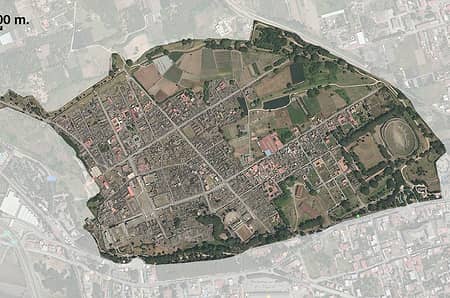
The archaeological ruins of Pompeii cover around 440,000 square meters, a vast area that would take at least three full days to explore completely. Remember that Pompeii is an entire buried city with squares, temples, baths, public buildings, private villas, and shops...just a visit to the city's forum takes about an hour.
That said, you can easily follow a shorter itinerary that includes some of the buried city's most famous sites , giving you an idea of what daily life was like in this Roman city. Here we suggest a few sites that you should include during your visit to the ruins, marking them with the same names as included on the free map provided at the ticket office and info point at the entrance to the ruins.
A Brief History of Pompeii
Pompeii was probably founded by the Oscans around the 8th century BC. This ancient Italic people settled on the southern slopes of Mount Vesuvius along the banks of the Sarno River, which was navigable at the time. Pompeii became an important commercial center early on, catching the interest of the invading Greeks and Etruscans. The Etruscans were conquered on the waters off Cuma, and the city came under domination by the Samnites in the 5th century BC. As a Samnite city, Pompeii entered into the Nucerine League and the tufo stone city walls were both expanded and fortified, allowing the city itself to grow. Pompeii became known as an important exporter of olive oil and wine, benefiting from the Mediterranean free market under Roman protection. After the end of the Samnite Wars in 80 BC, the city came under Roman dominance and in 89 BC Publius Cornelius Silla took up residency there along with a group of veterans, renaming the city Colonia Venerea Pompeianorum Sillana. During its Roman period, the city reached its architectural and economic peak, transforming into one of the most popular recreational and resort towns of the Roman aristocracy . During the Imperial Age, many wealthy Roman families moved to Pompeii, and buildings like the Temple of Fortuna Augusta and the Building of Eumachia are testimony to this influx. Under the Emperor Nero, the city was seriously damaged due to a strong earthquake in 62 AD, and rebuilding immediately began. Work was interrupted on 24 August of 79 AD by the disastrous eruption of Mount Vesuvius.
Visiting the Crater on Mount Vesuvius
A cloud, from which mountain was uncertain, at this distance (but it was found afterwards to come from Mount Vesuvius), was ascending, the appearance of which I cannot give you a more exact description of than by likening it to that of a pine tree, for it shot up to a great height in the form of a very tall trunk, which spread itself out at the top into a sort of branches; occasioned, I imagine, either by a sudden gust of air that impelled it, the force of which decreased as it advanced upwards, or the cloud itself being pressed back again by its own weight, expanded in the manner I have mentioned; it appeared sometimes bright and sometimes dark and spotted, according as it was either more or less impregnated with earth and cinders." (Pliny the Younger)
Excavation of Pompeii began in 1748 under King of Naples Charles III of Bourbon , who was interested in the project's prestige for the royal house and did not undertake the dig with particular scientific or systematic vigor. During the French occupation at the beginning of the 19th century, work at the excavation increased, though was halted almost completely with the return of the Bourbon kings. During this period, the discovery of the House of the Faun , with its excellent mosaic depicting the Battle of Alexander at Issus created such a stir that archaeological work began again at the site, this time using scientific methodology, careful record keeping, and plaster casting. From 1924 to 1961, work was overseen by Italian archaeologist Amedeo Maiuri and included important discoveries. Over recent years, excavations of new areas in the site have been halted and work is concentrated on restoring and maintaining buildings already unearthed.
2 Hour, 4 Hour, and 7 Hour Itineraries
Sites to visit from the Porta Marina Inferiore Piazza Esedra entrance (the second entrance from the Circumvesuviana “Pompei Villa Dei Misteri” stop along the Sorrento - Naples line )
- Quadriporticus of the theatres or Gladiators Barracks (VIII - 11)
- Large Theatre (VIII - 10)
- Small Theatre - Odeon (VIII - 12)
- House of the Menande ( I - 7)
- House of Casca Longus (I - 2)
- Fullery of Stephanus (I - 3)
- House of the Lararium of Achilles (I - 4)
- Garden of the Fugitives (I - 16)
- Necropolis of Nocera Gate (II - 10)
- Amphitheater (II - 5)
- Praedia of Giulia Felice (II - 3)
- House of Venus in the shell (II - 2)
- House of Octavius Quartio (II - 1)
- House of the Epidii (IX – 5)
- Stabian Baths (VII - 16)
- Lupanar (VII - 18)
- House of the Faun (VI - 1)
- House of the Vettii (VI - 11)
- House of the Golden Cupids (VI – 12)
- House of the Ara Maxima (VI – 13)
- From Torre XI up to Herculaneum Gate (VI - 16)
- Villa of the Mysteries (VI - 19)
- Forum Baths (VII - 10)
- Forum (VII – 6a)
- Temple of Jupiter (VII - 8)
- Forum Granary (VII - 7)
- Basilica (VIII - 2)
- Sanctuary of Venus (VIII - 1)
Porta Marina Superiore exit
Top 10 Area + number on the official map in parenthesis
Visiting Pompeii ruins with Kids
It isn't easy to get around Pompeii ruins with a stroller or pushchair, as the ancient Roman roads that cross the city are not navigable on wheels. Wheelchair users can follow a special marked route with the free map provided at the entrance, and the same itinerary can be followed with a stroller. Regardless, the best way to visit with infants and young children is by using a carrier or backpack. There are a number of Baby Points inside the archaeological park, which are small bungalows marked on the map. You can request keys at the park entrance and use these spaces to change and feed your infant in complete privacy.
Where to Eat
If you have decided to dedicate a full day to Pompeii ruins, the best option for lunch is packing a picnic to eat inside the park . On the park map available at the entrance, you will find a number of picnic areas marked around the ruins. Large bags are not allowed inside, so you will have to pack your food and beverages in small bags or backpacks. Purchase your supplies in Naples or Sorrento, as the snack bars inside the park are expensive. In Sorrento , the Salumeria Aprea (located on Via Tasso in the historic center and at the beginning of Via del Mare) makes excellent Caprese sandwiches and often has “casatiello”, a soft savory bread baked with diced ham, traditionally made at Easter. In Naples , pick up a sandwich at a cafè or take-away near the Stazione Centrale, or stop in Eccellenze della Costiera to choose some traditional sweet treats from the Amalfi Coast .
For a sit-down meal: Hortus (tel: +39 081 536 4566) Located along the road between the train station and the Porta Marina entrance, this spot is popular among tourists and offers a number of take-away options for a light lunch, or local dishes served in the pleasantly cool citrus garden. Caupona (tel: +39 081 1855 7911) If you want to stay on point, walk 5 minutes from Villa dei Misteri to this restaurant opposite Piazza Esedra that serves ancient recipes created by the Roman gourmet Marcus Gavius Apicius and served on terracotta plates by waiters dressed in period garb against the background of ancient music and frescoed walls inspired by Pompeii.
Top Ten Pompeii Sites
1. large theater and odeon (viii - 10).
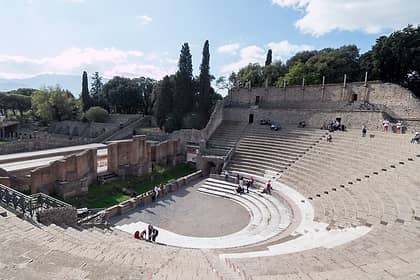
Pompeii's two theaters are located in the same area of the ancient city. The Teatro Grande (Large Theater) is an open-air amphitheater where Greek-Roman plays were performed; the smaller Odeon was used for poetry and musical performances, which required a smaller and covered space for the best acoustics. Tip: stand at the middle of the Odeon's stage and speak in a normal voice. You will hear your own voice amplified as if you have spoken into a microphone.
2. Garden of the Fugitives (I- 16)
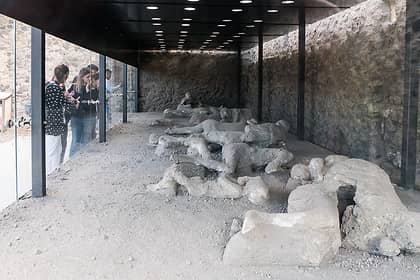
The Orto dei Fuggiaschi (Garden of the Fugitives) was an old quarter of the city that has been converted to vineyards as Pompeii grew. The name is an homage to the bodies of 13 victims of the eruption in 79 AD who were trying to escape through Porta Nocera before succumbing to the ashes and stone. Their remains where discovered during excavations in 1961-62 and 1973-74, using plaster casting methods.
3. Amphitheater (II – 5)

Built around 70 BC, Pompeii's ancient amphitheater is one of the best preserved in the world. Used for sporting events and gladiator battles, the space could seat 20,000 spectators in three sections of seating: the first rows were for prominent citizens, the middle rows were for the middle classes, and the summa, or the highest rows, were for the rest of the population.
4. Praedia of Giulia Felice (II – 3)
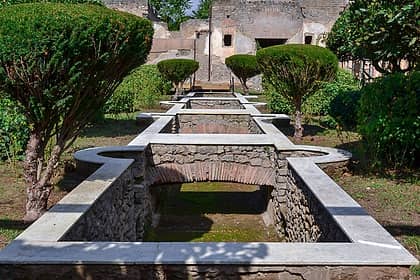
The Praedia di Giulia Felice is a large complex dating from the 1st century BC and was one of the first homes unearthed during excavations. This patrician villa has a large gardens surrounding a series of residential buildings and thermal baths. The name Giulia Felice was taken from an inscription painted on the facade after the earthquake of 62 AD (today displayed in Naples' National Archaeological Museum) in which the owner advertises that part of the property is for rent. The lavish decorations in the residential and thermal areas are particularly beautiful.
5. Lupanar (VII - 18)
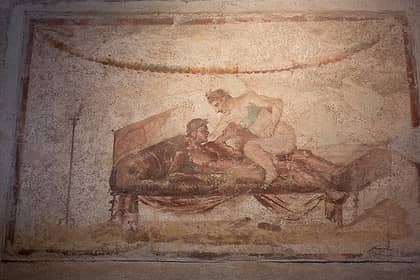
The lupanare (lupanar) is one of the most memorable sites within the ruins of Pompeii. The city's brothel was on two levels, with five small cells on the ground floor and five upstairs. Each cell had a stone bed that was topped with a mat or cushion, and above the door of each cell was an erotic fresco that probably depicted the specialization of the prostitute that worked in each individual cell. Though the brothel is located between two side streets, it was and still is easy to find by following the phallic symbols on the flagstones and facades of nearby buildings.
6. House of the Faun (VI – 1)

The Casa del Fauno (House of the Faun) is one of the most spectacular and largest houses in Pompeii, covering around 3,000 square meters with areas dedicated to the villa's owners and other areas for the servants. The name comes from a bronze satyr statue in the impluvium (a small pool for gathering rain water), and the villa has a number of statues, frescoes, and mosaics. Among the most famous is the mosaic that depicts Alexander the Great battling Darius and the Persians at Issus, now displayed at the National Archaeological Museum in Naples.
7. Villa of the Mysteries (VI – 19)
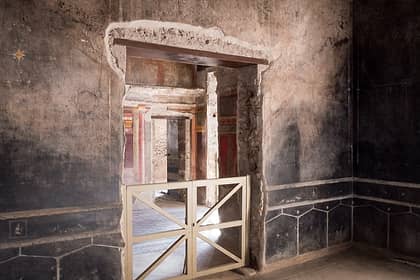
Discovered between 1909 and 1910, the Villa dei Misteri (Villa of the Mysteries) is one of the most captivating and mysterious in the entire ruins, and probably belonged to the Istacidii family, one of the most powerful in Pompeii during the reign of Augustus. The building dates from the first century BC and was built in the western residential area outside the city walls overlooking the sea. It had been renovated a number of times before the eruption in 79 AD, and is named for the Hall of Mysteries, a triclinium (dining hall) decorated with an extraordinary and enigmatic cycle of paintings,17 meters by 3 meters. The scene seems to depict a Dionysian ritual and the initiation into the cult, with the gods Dionysus and Aphrodite (or Ariadne) in the center of the rear wall.
8. Forum (VII – 6a)

Pompeii's Foro (Forum) is one of the most striking spots in the ancient city: a large square with triumphal arches, public buildings, the basilica, the market, the mensa ponderaria (weights and measures), and temples and buildings dedicated to Apollo, to Jupiter (the head of the former statue, dating from around 80 BC, still sits here), to Vespasian, to the Public Lares, and the Eumachia building. The city's main civic, religious, and commercial activities were carried out in the forum, and, as in all Imperial cities, the space was pedestrian only and closed to wheeled vehicles.
9. Basilica (VIII – 2)

Don't be fooled by the name: in Roman times, a basilica was the most important public building in the city, used as a type of courtroom where the judge sat on a raised dais above the sides and was also where commercial contracts were drawn up. The space, dating from the second century BC, resembled a covered forum with columns and could be used for the same civic, religious, and commercial functions in case of inclement weather.
10. Sanctuary of Venus (VIII – 1)

This important sacred site dedicated to Venus, protectress of the city and of navigation, was established in the second half of the second century BC on the plain of Pompeii facing the Sarno Valley and the sea. In the first half of the first century AD, the building reached its height of splendor with a series of expansions, renovations, and marble decorations. The temple housed a large gold lamp, probably donated by Nero and his wife, Poppea, to the cult, now displayed in the National Archaeological Museum in Naples .
Pompeii ruins Photo Gallery
FAQ - Frequently asked questions
Is the audioguide included in the ticket.
The cost of the audioguide is not included in the entrance ticket. While purchasing Pompeii tickets, you will be able to see all the options available to purchase together with the entrance ticket, such as audio guide, 3D eyelashes with all related explanations, etc.
Do the tickets have a binding entry time?
Skip-the-line tickets for Pompeii Ruins are valid for the whole day. Bear in mind, however, that the last entry to the site is an hour and a half before closing time.
“The Smoke of an Eruption and the Dust of an Earthquake”: Dark Tourism, the Sublime, and the Re-animation of the Disaster Location
- First Online: 21 February 2018
Cite this chapter

- Jonathan Skinner 6
4209 Accesses
7 Citations
Juxtaposing Antiquity with the Apocalypse, this chapter explores the re-animation of Pompeii as a disaster tourism trope found used, for example, on the Caribbean island of Montserrat. In so doing, this chapter engages with the question of whether or not there is space in dark tourism debate for the natural disaster, and whether or not dark tourism, then, is a relatively new phenomenon.
This is a preview of subscription content, log in via an institution to check access.
Access this chapter
Subscribe and save.
- Get 10 units per month
- Download Article/Chapter or eBook
- 1 Unit = 1 Article or 1 Chapter
- Cancel anytime
- Available as PDF
- Read on any device
- Instant download
- Own it forever
- Available as EPUB and PDF
- Durable hardcover edition
- Dispatched in 3 to 5 business days
- Free shipping worldwide - see info
Tax calculation will be finalised at checkout
Purchases are for personal use only
Institutional subscriptions
Similar content being viewed by others

Introduction: Dark Tourism in the American West
In the dark without a light: understanding unmediated sites of dark tourism.

Dark Tourism Along the Silk Route: The Case of Thessaloniki
Tourism equates to one of Giddens’s ( 1991 : 112) “fateful moments” and in the context of this chapter approximates Rojek’s “fatal attractions” ( 1993 : 136). These visitor experiences are built around contrast. In terms of emotions and arousal, Gillen points out that “tourism can and does provide the opportunity to experience a contrasting emotional landscape, where the familiar self can be felt in an unfamiliar way” ( 2001 , author’s emphasis). For him, these emotions can be bought and sold as commodities open for circulation. In terms of the dark tourism literature, the discussion in this section of the volume is whether or not this commoditisation is a new phenomenon and whether the label dark tourism is sanguine and appropriate to describe what is taking place. Space does not allow engagement with distinctions between “natural” as opposed to the man-made “cultural” disasters (cf. Lowenthal 2005 ) or the thesis of the disaster as “man-made” constructions arising from ‘modernising pressures’ (cf. Torry 1979 : 518; Skinner 2000 ).
Aguirre, B. (2012). Better disaster statistics: The Lisbon earthquake. Journal of Interdisciplinary History, 43 (1), 27–42.
Article Google Scholar
Anon. (1872). Loiterings around Lisbon. The Aldine, 5 (2), 44–47.
Google Scholar
Anon. (2016a). Mt. Unzen Disaster Memoriael Hall Gamadasu Hall . http://planetyze.com/en/japan/nagasaki/mt-unzen-disaster-memorial-hall-gamadasu-hall . Accessed 2 July 2016.
Anon. (2016b). Landmarks . Santorini360Hotels. http://www.santorini360hotels.com/landmarks/nea-kameni/nea-kameni-volcano . Accessed 5 Aug 2016.
Anon. (2016c). Akrotiri – Santorini’s own Pompeii . Greek Island Holidays. http://www.greek-island-holidays.co.uk/guides/akrotiri-santorini.html . Accessed 15 Aug 2016.
Anon. (2016d, May 2). ISU geosciences group recounts trip to the volcanic Caribbean Island Montserrat, featuring the “Pompeii of the West” . http://www.isu.edu/headlines/title-8757-en.html . Accessed 3 May 2016.
Bachelor, B. (2014, February 20). Montserrat: A modern-day Pompeii in the Caribbean. Fox News. http://www.foxnews.com/travel/2014/02/20/montserrat-modern-day-pompeii-in-caribbean.html . Accessed 1 Sept 2016.
bcdonthego. (2016, July 13). Worth the drive, but don’t expect too much. Tripadvisor Montserrat Volcano Observatory Review. https://www.tripadvisor.co.uk/ShowUserReviews-g147333-d316387-r392324792-Montserrat_Volcano_Observatory-Montserrat.html#REVIEWS . Accessed 20 Aug 2016.
Beard, M. (2008). Pompeii: The life of a Roman town . London: Profile Books.
Beckford, W. (1835). Italy; with sketches of Spain and Portugal (Vol. I). London: Richard Bentley. http://www.gutenberg.org/files/41150/41150-h/41150-h.htm . Accessed 21 Aug 2016.
Bell, C., & Lyall, J. (2002). The accelerated sublime: Landscape, tourism, and identity . London: Praeger.
Bergeron, E. (2016, June 9). Lost city of Plymouth ~ Montserrat ~ Volcano exclusion zone ~ UAV Drone Caribbean ~ WeBeYachting.com . https://www.youtube.com/watch?v=t9F-ws8T0Jw . Accessed 28 Aug 2016.
Black, J. (1999). The grand tour in the eighteenth century . London: Sandpiper Books Ltd.
Blix, G. (2013). From Paris to Pompeii: French romanticism and the cultural politics of archaeology . Philadelphia: University of Pennsylvania Press.
Brigham, W. T. (1868). Earthquakes. The American Naturalist, 2 (10), 539–547.
Brightman, E. (1919). The Lisbon earthquake: A study in religious valuation. The American Journal of Theology, 23 (4), 500–518.
Buda, D. (2015). The death drive in tourism studies. Annals of Tourism Research, 50 (1), 39–51.
Bulwer-Lytton, E. G. (1834). The last days of Pompeii . Paris: Baudry.
Burke, E. (1767[1756]). A philosophical enquiry into the origin of our ideas of the sublime and beautiful . London: J. Dodsley. https://books.google.co.uk/books?id=CUgJAAAAQAAJ&printsec=frontcover#v=onepage&q&f=false . Accessed 15 Sept 2016.
Chard, C. (2007). Picnic at Pompeii: Hyperbole and digression in the warm south. In V. Coates & J. Seydl (Eds.), Antiquity recovered: The legacy of Pompeii and Herculaneum (pp. 115–132). Los Angeles: J. Paul Getty Museum.
CTONews. (2015). The island of Montserrat is on the rebound , Caribbean Tourism Organisation. http://www.onecaribbean.org/the-island-of-montserrat-is-on-the-rebound/ . Accessed 5 Sept 2016.
Dahl, C. (1953). Bulwer-Lytton and the school of catastrophe. Philological Quarterly, 32 , 428–442.
Dahl, C. (1956). Recreators of Pompeii. Archaeology, 9 (3), 182–191.
Daly, N. (2011). The volcanic disaster narrative: From pleasure garden to canvas, page, and stage. Victorian Studies, 53 (2), 255–285.
DiscoverMNITeam. (2016, February 12). 2015 tourism figures released. http://www.discovermni.com/2016/02/2015-tourism-figures-released/ . Accessed 1 Sept 2016.
Edensor, T. (2005). Industrial ruins: Space, aesthetics and materiality . Oxford: Berg.
Ekström, A. (2016). Remediation, time and disaster. Theory, Culture & Society. Prepublished January 2016. https://doi.org/10.1177/0263276415625336 .
Erfurt-Cooper, P. (2010a). Introduction. In P. Erfurt-Cooper & M. Cooper (Eds.), Volcano and geothermal tourism: Sustainable geo-resources for leisure and recreation (pp. 3–31). London: Earthscan Ltd.
Erfurt-Cooper, P. (2010b). Volcano and geothermal tourism in Kyushu, Japan. In P. Erfurt-Cooper & M. Cooper (Eds.), Volcano and geothermal tourism: Sustainable geo-resources for leisure and recreation (pp. 142–154). London: Earthscan Ltd.
Feldman, A. (2002). Ground zero point one: On the cinematics of history. Social Analysis: The International Journal of Social and Cultural Practice, 46 (1), 110–117.
Ferguson, T. (2013). Introduction. In T. Ferguson (Ed.), Victorian time: Technologies, standardizations, catastrophes (p. 1–15). London: Palgrave Macmillan.
Forsyth, D. (2016). Denver’s Lakeside Amusement Park: From the White City beautiful to a century of fun . Boulder: University of Colorado Press.
Friedrich, W. (2009). Santorini: Volcano, natural history, mythology . Aarhus: Aarhus University Press.
Giddens, A. (1991). Modernity and self-identity: Self and society in the late modern age . Cambridge: Cambridge University Press.
Gillen, S. (2001). A moving experience? Investigating the social significance of emotion in tourism. Unpublished MA thesis, University of Lancaster. http://www.arasite.org/sgma1.htm . Accessed 6 June 2005.
Goldhill, S. (2012). A writer’s things: Edward Bulwer Lytton and the archaeological gaze; or, what’s in a skull? Representations, 119 (1), 92–118.
Goldhill, S. (2014). The buried life of things: How objects made history in nineteenth-century Britain . Cambridge: Cambridge University Press.
Hamblyn, R. (2008). Notes from underground: Lisbon after the Earthquake. Romanticism, 14 (2), 108–118.
Harper, M. (1993). Narratives for a liminal age: Ballanche, Custine, Nerval. In S. Nash (Ed.), Home and its dislocations in nineteenth-century France (pp. 65–84). Albany: State University of New York Press.
Harris, R. (2003). Pompeii . London: Hutchinson.
Heringman, N. (2003). The style of natural catastrophes. Huntington Library Quarterly, 66 (1/2), 97–113.
Hobden, F. (2009). History meets fiction in “doctor who”, the fires of Pompeii’: A BBC reception of ancient Rome on screen and online. Greece & Rome . Second Series, 56 (2), 147–163.
Hohenhaus, P. (2016a). Pompeii . Dark-Tourism.com , http://www.dark-tourism.com/index.php/italy/15-countries/individual-chapters/492-pompeii . Accessed 22 Aug 2016.
Hohenhaus, P. (2016b). Montserrat . Dark-Tourism.com , http://www.dark-tourism.com/index.php/montserrat-west-indies . Accessed 22 Aug 2016.
Kant, I. (2000). Critique of the power of judgment . Cambridge: Cambridge University Press.
Book Google Scholar
Karkut, J. (2010). Under the volcano – Can sustainable tourism development be balanced with risk management? In P. Erfurt-Cooper & M. Cooper (Eds.), Volcano and geothermal tourism: Sustainable geo-resources for leisure and recreation (pp. 233–246). London: Earthscan Ltd.
King, C. (1877). Catastrophism and evolution. The American Naturalist, 11 (8), 449–470.
Korstanje, M. (2008). The leisure in Ancient Rome: Chronicles of an empire rise. Revista de Turism, 8 (8), 14–21.
Lazer, E. (2009). Resurrecting Pompeii . Abingdon: Routledge.
Leite, N. (2014). Afterword. Locating imaginaries in the anthropology of tourism. In N. Salazar & N. Graburn (Eds.), Tourism imaginaries: Anthropological approaches (pp. 260–278). Oxford: Berghahn Books.
Lennon, J., & Foley, M. (2000). Dark tourism: The attraction of death and disaster . Padstow: Continuum.
Lockhart, J. (1838). Life of sir Walter Scott . London: Murray.
Lowenthal, D. (2005). Natural and cultural heritage. International Journal of Heritage Studies, 11 (1), 81–92.
Manjikian, M. (2012). Apocalypse and post-politics: The romance of the end . Plymouth: Lexington Books.
McCormick, J. (1998). Catastrophe and imagination: English and American writings from 1870 to 1950 . New York: Transaction Publishers.
Melville, L. (1910). The life and letters of William Beckford of Fonthill . London: William Heinemann.
Moorman, E. (2015). Pompeii’s ashes: The reception of the cities buried by Vesuvius in literature, music, and Drama . Berlin: Walter de Gruyter.
Neiman, S. (2004). Evil in modern thought: An alternative history of philosophy . Princeton: Princeton University Press.
Newsweek Staff. (1997, August 18). Another paradise lost. Newsweek . http://europe.newsweek.com/another-paradise-lost-172414?rm=eu . Accessed 3 July 2016.
Paice, E. (2008). Wrath of god: The great Lisbon earthquake of 1755 . London: Quercus/Penguin Group.
Petford, N., Fletcher, J., & Morakabati, Y. (2010). On the economics and social typology of volcano tourism with special reference to Montserrat, West Indies. In P. Erfurt-Cooper & M. Cooper (Eds.), Volcano and geothermal tourism: Sustainable geo-resources for leisure and recreation (pp. 85–93). London: Earthscan Ltd.
Pierre, C. (2016, May 13). Sailors violate exclusion zone. Montserrat reporter online. https://www.themontserratreporter.com/sailors-violate-exclusion-zone/ . Accessed 14 Sept 2016.
Possekel, A. (1999). Living with the unexpected: Linking disaster recovery to sustainable development in Montserrat . Berlin: Springer.
Ray, G. (2004). Reading the Lisbon earthquake: Adorno, Lyotard, and the contemporary sublime. The Yale Journal of Criticism, 17 (1), 1–18.
Rogers, M. (2016, July 5). Mysterious Montserrat: Volcano-buried city, Beatles legacy. USA Today . http://www.usatoday.com/story/travel/experience/caribbean/2016/06/28/montserrat/86437812/ . Accessed 1 Sept 2016.
Rojek, C. (1993). Ways of escape: Modern transformations in leisure and travel . London: The Macmillan Press Ltd.
Scott, H. (2014). Chaos and cosmos: Literary roots of modern ecology in the British nineteenth century . Pennsylvania: The Pennsylvania State University Press.
Seabrook, J. (1995). From leisure class to leisure society. In C. Critcher, P. Bramham, & A. Tomlinson (Eds.), The sociology of leisure: A reader (pp. 97–104). London: Chapman and Hall.
Shelley, M. (1844). Rambles in Germany and Italy in 1840, 1842, and 1843 (Vol. 2). London: Edward Moxon.
Skinner, J. (2000). The eruption of chances peak, Montserrat, and the narrative containment of risk. In P. Caplan (Ed.), Risk revisited (pp. 156–183). London: Pluto Press.
Skinner, J. (2008). Ghosts in the head and ghost towns in the field: Ethnography and the experience of presence and absence. Journeys: International Journal of Travel and Travel Writing, 9 (2), 10–31.
Skinner, J. (2015, May 21). Let’s get gritty on the black and green. MNIalive.com – Global Caribbean Media . http://www.mnialive.com/articles/let-s-get-gritty-on-the-black-and-green . Accessed 21 May 2015.
Skinner, J. (2017). “Was here”: Identity traces and digital footprints as survival writing. Liminalities: A Journal of Performance Studies . http://liminalities.net/12-5/washere.pdf . Accessed 20 Sept 2017.
Skinner, J., & Theodossopoulos, D. (2011). Introduction: The play of expectation in tourism. In J. Skinner & D. Theodossopoulos (Eds.), Great expectations: Imagination, anticipation, and enchantment in tourism (pp. 1–26). Oxford: Berghahn Books.
Sliwinski, S. (2011). Human rights in camera . Chicago: University of Chicago Press.
Sloan, G. (2015). Back on the map for cruisers: Montserrat. USA Today . http://www.usatoday.com/story/cruiselog/2015/03/19/windstar-cruises-montserrat/24983199/ . Accessed 5 Aug 2016.
St Clair, W., & Bautz, A. (2012). Imperial decadence: The making of the myths in Edward Bulwer-Lytton’s: The last days of Pompeii. Victorian Literature and Culture, 40 , 359–396.
Steiner, G. (1971). Bluebeard’s castle: Some notes towards the redefinition of culture . New Haven: Yale University Press.
Stendhal. (1987[1826]). Rome, Naples et Florence . Paris: Gallimard.
Thackeray, W. (1899). The works of William Makepeace Thackeray: Contributions to “Punch,” etc . London: Harper & Brothers.
Torry, W. (1979). Anthropological studies in hazardous environments: Past trends and new horizons. Current Anthropology, 20 (3), 517–540.
VisitMontserrat. (2016). Explore. http://www.visitmontserrat.com/buried-city/ . Accessed 8 Sept 2016.
Volcano Discovery. (2016). Fascination volcano. https://www.volcano-adventures.com/italy/volcanoes_italy_tour.html . Accessed 15 Aug 2016.
von Goethe, J. W. (1848). The auto-biography of Goethe: Truth and poetry: From my own life . London: H.G. Bohn.
Walker, T. (2015). Enlightened absolutism and the Lisbon earthquake: Asserting state dominance over religious sites and the church in eighteen-century Portugal. Eighteenth-Century Studies, 48 (3), 307–328.
Walpole, H. (1774). A description of the villa of Horace Walpole, youngest son of Sir Robert Walpole Earl of Orford, at Strawberry-Hill, near Twickenham. With an inventory of the furniture, pictures, curiosities, &c. Strawberry-Hill . London: Thomas Kirkgate.
Walpole, H. (1890). In C. Yonge (Ed.), Letters of Horace Walpole: Volume 1 (1736–1764) . London: T. Fisher Unwin. http://www.fullbooks.com/Letters-of-Horace-Walpole1.html . Accessed 25 May 2016.
Willis, E. (2014). Theatricality, dark tourism and ethical spectatorship: Absent others . New York: Palgrave Macmillan.
Download references
Author information
Authors and affiliations.
University of Roehampton, London, UK
Jonathan Skinner
You can also search for this author in PubMed Google Scholar
Editor information
Editors and affiliations.
University of Central Lancashire, Preston, United Kingdom
Philip R. Stone
University of Colorado Denver, Denver, USA
Rudi Hartmann
University of Limerick, Limerick, Ireland
Tony Seaton
Richard Sharpley
Victoria University, Melbourne, Australia
Leanne White
Copyright information
© 2018 The Author(s)
About this chapter
Skinner, J. (2018). “The Smoke of an Eruption and the Dust of an Earthquake”: Dark Tourism, the Sublime, and the Re-animation of the Disaster Location. In: R. Stone, P., Hartmann, R., Seaton, T., Sharpley, R., White, L. (eds) The Palgrave Handbook of Dark Tourism Studies. Palgrave Macmillan, London. https://doi.org/10.1057/978-1-137-47566-4_5
Download citation
DOI : https://doi.org/10.1057/978-1-137-47566-4_5
Published : 21 February 2018
Publisher Name : Palgrave Macmillan, London
Print ISBN : 978-1-137-47565-7
Online ISBN : 978-1-137-47566-4
eBook Packages : Social Sciences Social Sciences (R0)
Share this chapter
Anyone you share the following link with will be able to read this content:
Sorry, a shareable link is not currently available for this article.
Provided by the Springer Nature SharedIt content-sharing initiative
- Publish with us
Policies and ethics
- Find a journal
- Track your research

IMAGES
VIDEO
COMMENTS
Pompeii - darkometer rating: 7 - A world-famous heritage site, one of Italy's premier tourist attractions and one of the most important archaeological sites on Earth for its Ancient Roman remains and relics: it's the largest and best preserved Ancient Roman town. It is also a dark tourism spot, of course, namely for the reason it was preserved ...
Dark heritage concept becomes more popular during the last years than before especially in the field of heritage studies. This widespread encouraged what is known as dark tourism. As it is going to be discussed in this paper, the dark heritage or tourism concept include any destruction, catastrophe, and death cases. Travelling for the purpose of seeing dead or death sites become very popular ...
Pompeii is not only a significant dark tourism destination, but one of Italy's most popular cultural sites, with almost 4 million people visiting the ruins in 2019. Once a thriving Roman city ...
Millions of tourists visit areas around the world linked to death, disaster and atrocity every year. A professor of tourism explains our need to explore the darkest moments in history.
Below are some of the most well-known dark tourism destinations from around the world. 1. The Ruins of Pompeii // Pompeii, Italy. When Mount Vesuvius erupted in 79 AD, multiple nearby towns were ...
Mostly for mainstream tourism and cultural tourism. But there are plenty of things that are of special interest to the dark tourist too, even though some of these also overlap with mainstream tourism - which is particularly true for Pompeii and the Colosseum in Rome. - Rome (Ardeatine caves, Mussolini's bunkers at Villa Torlonia, Foro Italico ...
A valuable example of contemporary tourist folklore operates at the ruined city of Pompeii, an archaeological park near Naples, Italy (fig. 1). Pompeii is an important example not only because of its notoriety as a "dark tourist site"—a site associated with death and trauma—but also because it is one of the most visited UNESCO sites in ...
From the ruins of Pompeii to the sombre grounds of Auschwitz, dark tourism encapsulates a range of destinations that challenge, educate, and evoke deep emotional responses. Dark Tourism Definitions Dark tourism is a term enveloping a spectrum of travel experiences centered around sites of historical tragedies, war, disasters, and death.
But within the concept "dark tourism" are completely different attractions and they therefore need different behaviour from visitors. I talked to a researcher on dark tourism and she explained it as a spectrum: at one end is the serious, dark and horrible places like Auschwitz, and at the other less dark end are events like a ghost-walk.
Pompeii is a UNESCO World Heritage site and is one of Italy's most popular tourist destinations with over 2.5 million visitors per year. Some people question whether or not Pompeii is actually a dark tourism site due to the age of the site. After all, the eruption occurred nearly 2000 years ago. In my opinion, Pompeii is absolutely a dark ...
The ruined city of Pompeii lies at the foot of Mount Vesuvius, the volcano whose eruption in AD 79 engulfed and subsequently encased the city in six meters of ash and pumice-stone. ... 25 Top-Rated Tourist Attractions in Italy. MORE DESTINATIONS. Visiting Herculaneum: 13 Top Attractions. 11 Top Attractions & Places to Visit on the Amalfi Coast ...
Dark tourism was first coined in 1996, by Lennon and Foley; two scholars at Glasgow Caledonian University, ... The Ruins of Pompeii. Location: Pompeii, Italy. Mount Vesuvius's volcanic eruption wiped out the Roman city of Pompeii in 79AD. Almost two millennia later, the site is a very popular (dark) tourist destination with over 2.5 million ...
Among the aims of this study is to discuss the concept of dark heritage and tourism and its importance to the recent tourism programs and heritage studies shedding the light on the site of Pompeii as very successful and important model for dark tourism in Italy. Keywords: Dark Heritage, Tourism, Pompeii, Interpretation 1.
Experts call the phenomenon dark tourism, and they say it has a long tradition. Dark tourism refers to visiting places where some of the darkest events of human history have unfolded. That can ...
The top 10 dark tourism destinations in the world. #1 Wuhan, China. #2 Chernobyl, Ukraine. #3 Fukushima, Japan. #4 Auschwitz Concentration Camps, Poland. #5 Sedlec Ossuary, Czechia. #6 Oradour-sur-Glane, France. #7 Aokigahara Suicide Forest, Japan. #8 Volcano Creeks in Pompeii, Italy.
Pompeii, Italy - One of the most Tragic Natural Disasters in History. First up on our list of cities in Europe for dark tourism is Pompeii, situated just 25 km (15.5 miles) south of Naples. Once a thriving Roman city, Pompeii has been left abandoned since 79 AD, when Mount Vesuvius erupted, destroying everything in its wake.
Pompeii Italy a city frozen in time. This ancient Roman town which is tucked away close to the busy city of Naples has captivated the attention of millions of people because of its amazing preservation and tragic history of destruction.
Pompeii, Italy. Pompeii, Italy, stands as a captivating dark tourist site, frozen in time by the catastrophic eruption of Mount Vesuvius in 79 AD. The ancient city was buried under layers of ash and pumice, preserving its streets, buildings, and inhabitants in an eerie tableau. The plaster casts of citizens, captured in their final moments of ...
Dark tourism involves visiting places linked to death, tragedy, or the macabre, giving you a look into the darker parts of human history and culture. ... Pompeii, Italy. Pompeii is an ancient Roman city near Naples that was buried under volcanic ash and pumice when Mount Vesuvius erupted in AD 79. The city remained hidden until it was ...
11. 3-Day Tour from Rome to Naples, Pompeii and Amalfi Coast. Source: leoks / shutterstock. Amalfi Coast. For those looking for a multi-day, full-immersion tour into the beauty and history of southern Italy, this three-day Naples, Pompeii, and Amalfi tour from Rome is probably the best option.
See our three itineraries for visits to the ruins of Pompeii lasting 2 hours, 4 hours, or 7 hours. Visit Pompeii Your local experts ... it appeared sometimes bright and sometimes dark and spotted, according as it was either more or less impregnated with earth and cinders." ... Italy - [email protected] P.Iva, C.F. e N.Reg. Imprese Napoli ...
The first quotation above from The Last Days of Pompeii () describes the start of the eruption of Mount Vesuvius on 24 August 79 AD.It is written imaginatively by the popular Victorian writer Edward George Bulwer-Lytton , the gothic novelist who coined the expression "It was a dark and stormy night".
Pompeii Italy: The Dark Tourism Destination Where History Was Buried AliveDiscover the hauntingly preserved ruins of Pompeii, the ancient Roman city frozen i...
Pompeii | Image credit: muratart/Shuttertsock. On Day 9 of your Amalfi Coast itinerary, a visit to Pompeii is a must. Mount Vesuvius, an active volcano, is located on the mainland of Italy. When it erupted in 79 AD, the ash engulfed the two flourishing Roman towns of Pompei and Herculaneum, and several resort villas.